








• The SU, UCU and Unison presented an open letter to University administration at the end of April demanding official condemnation of “Israel’s colonial genocide” and action by Sussex.
• Following a meeting with representatives, VC Roseneil responded publicly and confirmed the University refuses to take an institutional position.
Ada Carpenter Senior Editor
Vice-Chancellor Professor Sasha Roseneil has defended the University of Sussex Executive Team’s decision to “not [take] a specific institutional position on the conflict in Israel-Gaza/Palestine.”
In a message sent to all staff and students on 2 May, VC Roseneil said “I believe the University as an institution should refrain from making statements about matters that are external to the running of the organisation.” This statement was made following a meeting between the Executive Team and representatives of the Students’ Union (SU) and the University and College Union (UCU) on 1 May that discussed their open letter asking for Sussex to “publicly condemn Israel’s colonial genocide in Gaza.”
The open letter called on the University Executive Team to “fully divest from all companies that are complicit in Israel’s genocide in Gaza, publicly disclose full details of all the University investments, and commit against making future investments in companies that are complicit in Israeli

settler colonialism and apartheid.”
Divestment forms a central part of the Boycott, Divest, Sanction (BDS) movement, which has been endorsed by the SU and UCU since 2015. While the University does have an existing “Socially responsible section of Investment Management Policy”, the past and current investment portfolio seems to compromise the principles laid out, in particular, the “promotion of human rights” and of “international cooperation and an end to international conflict.”
Based on Freedom of Information requests by Sussex students and the Palestine Solidarity Campaign, the University has investments totalling £20,916,240.57 in corporations or funds complicit in Israel’s genocidal attacks. This includes almost £14.5 million invested in Barclays Bank, which invests in companies known to support the Israeli military, and over £100,000 in Siemens, which amongst other concerns is “participating in [a] high-speed train project that crosses the Green Line into the occupied West Bank in two areas, using occupied Palestinian land for an Israeli transportation project aimed exclusively for Israelis.” For a full breakdown of the complicit investments,

read the open letter.
In her 2 May statement, Roseneil conceded “it is right that we review our policy, testing it with our community, and seeking best-practice in ethical investment.” She announced “I will be recommending to Council that we establish a new group, which will include student and staff representatives, to review [the
Continued on page 4...
Semhar (Semi) Tesfazgy Editor-in-Chief
The Badger has done Sussex proud! Committee members from The Badger attended the Student Publication Association’s National Conference (SPANC) in Bristol from 10 to 12 April, bringing home five national awards across several categories. It was an incredible weekend, filled with talks from industry heads and experienced journalists - not to mention a chance to network with our fellow student publications nationwide!
The 2024 awards had more than 1,200 entries, and nominations were judged by top editors and journalists from media organisations across the UK - including the BBC, The Bureau of Investigative

Journalism, The Guardian, Sky News, and The Times
The Badger received ten shortlists, which completely blew us away considering our humble beginning this academic year with a committee of just four people. Our team did us proud by successfully winning five awards - presented by Aubrey Allegretti, 2014 Editor-in-Chief of The Badger turned




• Sussex Will Not Condemn Palestine Genocide, Says VC Roseneil
• Badger Wins Big at National Awards
• Early Termination of Housing Contract for PGT Students
• Novel Materials Win Pitch for the Planet 2024
• RAAC Replacement Finishes in Bramber House
• Sussex Education Awards Celebrate Innovation
• Sustainable Sussex Fortnight Encourages Green Action
• Southern Water Hikes Bills Amidst Ongoing Pollution Controversy
• Disabled Students Not Receiving Necessary Adjustments
• Budget Cuts Lead to Backlogged Bins
Dear Readers,
• A Candid Interview with Brighton’s Peace Camp
• Bruha: Flavours of Resilience from the Philippines
• Top 10: Quirky Shops
• Puppy Yoga Studio Opens in Hove Local
• Worrying Rates of Knife Crime Amongst Young Males in the UK
• There’s Something I Have Been Dying to Tell You
• Amsterdam Solo: Discovering the True Meanings of Life in the Happiest City
• Veganism is Eating Away at My Money
• How to Handle End of Year Assessments (Without Losing Your Grip on Reality)
• Reawakening Fashion?
Micro Trends and the Met Gala
• What Happens on Tour Shouldn’t Stay on Tour
• Nostalgia: The Present Based on the Past
• The Big Collab: Should Newspapers Encourage Controversy?
• Life After the Spotlight
• The Dilemma of Deciding on a Dying Fig
• Ways to Support Palestine as Students
• Israel’s Artificial Intelligence Targeting System, A Pre-Emptive Scapegoat
GAMES
p19
• Confessions of an Ex-Gamer Girl
• Childhood Games: A Walk Down Memory Lane
FILM and TV
• Review: Invincible S2 Ep. 8
• The Downfall of Marvel: Has the MCU Reached its Endgame?
• Should We Be Doing The Things
We Do For Our Favourite Actors?
• Recommendations by Genre
It’s the end. It feels strange to be saying goodbye - it feels like just yesterday I received the key for the media office. That small room has become our team base; on an average day you can usually see at least ten Badger members skulking in and out, Falmer bar takeaway chips in hand. I am so happy to have made so many wonderful memories with an incredible teamthe happy times (receiving our five national awards, distribution days), and the stressful times (chasing up the Students’ Union and staff writers who have dropped off the face of the Earth), have meant this year has never had a boring day. I am so proud of everything our senior team, committee, staff writers and photographers have achieved, and I believe we have set a solid groundwork for next year’s committee.
Taking up my role as Editor-inChief is Abi Summers - someone who has been on the paper longer than myself and has seen its rise, fall, and (even greater) rise again. I believe that she will do an incredible job continuing The Badger, and I’m excited to see where she takes it from here.
This year has seen so many achievements from The Badger team and we have a lot to show for it - but now that my time has ended I want to take the time to discuss the struggles we have gone through this past year and the causes for some of them - the Students’ Union (SU).
MUSIC
I am grateful to the SU for funding The Badger newspaper printing, and to Steve Jackson for all his hard work supporting us this year as Sports, Societies and Events Officer despite his large workload… but my praise ends here.
I have worked very closely with the SU, regularly having to come in and out for various issues involving finances, events, management, access and permissions - and having been in this position I can say this with confidence: the organisation at the SU is SH*T Our SU is woefully underfunded (receiving less funding than most SUs across the country), but that doesn’t excuse for a fundamentally flawed distribution of work. How is one person meant to feasibly manage and act as representative for over 200 vastly different societies (sports and non academic)? The financial team consists of two (very lovely and hardworking) people working parttime - dealing with the finances of hundreds of different societies with different types of incomes and costs – and it shows in how long it takes to gain access to funds (usually over two months). Just gaining access to The Badger email took us months, due to a complete lack of communication caused by the SU staff being overworked. I think it’s very important for me to emphasise that this isn’t an issue with the Students’ Union staff. Quite the opposite, most of them have been very lovely and have tried to support us their best with
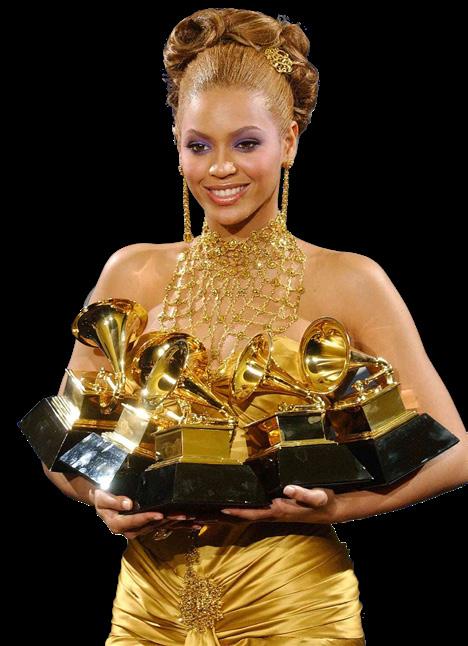
• Beyon-Say Her Name, Say Her Name
• Jojo Si-What on Earth is Going On?
• ‘Shopping’ by Welly is Great for Lidl Fans, but a Bit Candid for Waitrose Shoppers
• The Great Escape Festival 2024
BOOKS
• Book Suggestions by Genre
• Review: My Year of Rest and Relaxation by Ottessa Moshfegh
• Review: Offtrack by Esha Patel
• Hello, You: The Obsession and Consequences of Dark Romance
THEATRE
• When the Jokes Don’t Hit...
• Guess the Show!
• Are Jukebox Musicals Hitting the Right Notes?
• What’s On in Brighton... Fringe
& Tech
• Nature in Focus
• Nature’s Blueprint: Biomimicry
• Sustainable Dining Through 3D Food Printing
• Who Owns Your Voice?

• Varsity Reports
• Interview with Jayden Seales: Pacer Sets Sights on Test Return
• In the Cage and Beyond: Victor Hugo’s UFC Journey
the little time they have. It’s an issue with an SU that is unwilling to hire staff for the areas that need it most. I mean - we have a committee with over ten members for sustainability, but only one person (who also has several other committees to deal with) dealing with the media committee. It’s also very very ironic that there are four “Communications” SU staff members, but trying to get in contact with them is like shouting into the abyss…you’re lucky to get a response inside ‘ten working days’. There are a lot of things I’ll miss from my time at The Badger, but dealing with all the administrative nightmares will not be one of them. Looking on the brighter side, I’m so happy for every single person who has picked up a copy of The Badger. Seeing someone flick through it in Falmer house, or getting a message on Instagram telling me they loved the puzzles makes me so happy and has given my life so much joy. The Badger has gone from being a distant memory to the forefront of a lot of people’s minds, and I am so grateful for it. Next year’s committee is going to take us to new heights, so make sure to pick up the Freshers’ edition in September.
With that, I will say goodbye, and thank you to everyone who has played a part in this incredible journey, whether big or small. I hope you will continue to support The Badger in the future.
Happy reading (and beyond!),
Semhar (Semi) Tesfazgy, Editor-in-Chief, 2023/2024



I talk about The Badger so much that my friends are actually concerned whether I’ll get my degree. While this might be a valid point (10k words due in 10 days anyone?!), I don’t regret a second of the hours I’ve worked on this newspaper. Providing information outside of the University bulletin and platforming student voices is essential. It’s particularly important when the University isn’t representing or listening to us - as is all too clear in my front page article on the VC’s statement on Palestine. Sussex has long been home to brave and powerful student activism, and this moment must be no exception. Supporting our community through my work - be that writing breaking news or going crazy over InDesign - is the most important thing I’ve done; receiving the ‘Contribution to Student Media’ award for it is an honour. Getting to work with the most amazing team to make the paper every month has been joyful… and I’ve come to realise journalism might actually be my calling.
Ada Carpenter, Senior Editor
This year has been an exciting fresh start for The Badger thanks to the hard work and enthusiasm of Semi and the entire rest of the team. I’ve had a great time as News Editor with the help of Ada, James, Amina, and Lola who I can’t thank enough for helping out with the ever-growing number of News pages! I am thrilled to be taking on the role of Editor-in-Chief next year and hope to continue the team’s success in growing The Badger and reaching an even wider audience. The new committee are all extremely talented and I can’t wait to see what they produce. If you are interested in writing for us, keep an eye out for announcements during Freshers Week!
Abi Summers, News Editor
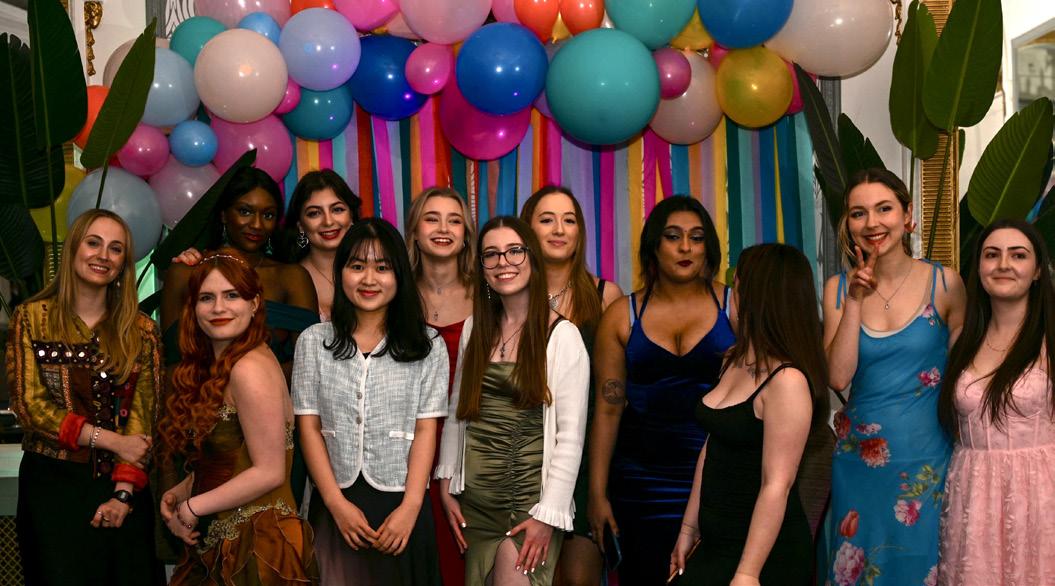
This is such a bittersweet moment! Being an editor has been an unforgettable experience filled with laughter, late nights and endless inspiration. Thank you to the committee, staff writers and readers for all your support. I’m sad to leave but I’m so excited to see what the new committee achieves :)
Charlotte Berry, Opinion Editor
It was a fun year of writing, clicking, and editing for The Badger I’m thrilled to carry forward the lessons from this journey as I transition from being a student and freelance journalist to pursuing a full-time career in journalism! Follow me on Insta to see where I go next! @mutinouszee Zeeshan Tirmizi, Opinion Sub Editor

As I’m hiding from my (late) assignments, upcoming exams and graduation, I can’t help but reflect on an amazing year at The Badger. I couldn’t find a fitting David Attenborough quote to leave you with, so from me: a huge “thank you” and a very reluctant “goodbye”.
Sian Scott, Science & Tech Editor
Goodbye
from the committee... for now!
When I arrived at Sussex in September, I was fresh out of a three-year undergraduate degree during which I made student journalism my entire personality. I wasn’t planning on doing that again. I told myself that I was going to focus on my Masters. Maybe I’d even join a new society. I could have hobbies other than student journalism, right? (Wrong!) And then I heard about The Badger. I met Semi and the rest of the ‘core four’ at Freshers. I got CC’d into an email with Ada and Akanksha. And well… the rest is history, I guess. The Badger has been such a huge part of my postgraduate experience that I can’t quite imagine what my life in Brighton would have been without it. From four members and three decade-old computers to taking home several National Awards, The Badger has grown so much over the past year, and I have grown right alongside it. I couldn’t have done it without the best senior team a girl could ask for. Semi, Ada, Akanksha, Maisie: I have learnt so much from all of you and you inspire me every day. So, for the final time, to quote our incredibly eloquent Editor-in-Chief, “live laugh The Badger.”
Francesca
Sylph, Senior Editor
My final year at Sussex has been the best so far, thanks to The Badger; but graduation is calling my name, so it is with a heavy heart that I say goodbye to Local Life! A massive thank you to Ada for all of your InDesign expertise, Local Life wouldn’t look half as good without you! I can’t believe a year has passed since we rescued this wonderful newspaper and it’s been such a privilege working alongside such a talented and dedicated team - I will miss you all, goodbye!
Anna Hills, Local Life Editor
It has been an absolute pleasure working with such a wonderful bunch of people and reading all the incredibly interesting articles we have received! I have to thank Anna Hills for choosing me as one of her sub editors – it has been a great learning experience and I’ve loved being a part of the team.
Anna Whelan, Local Life Sub Editor
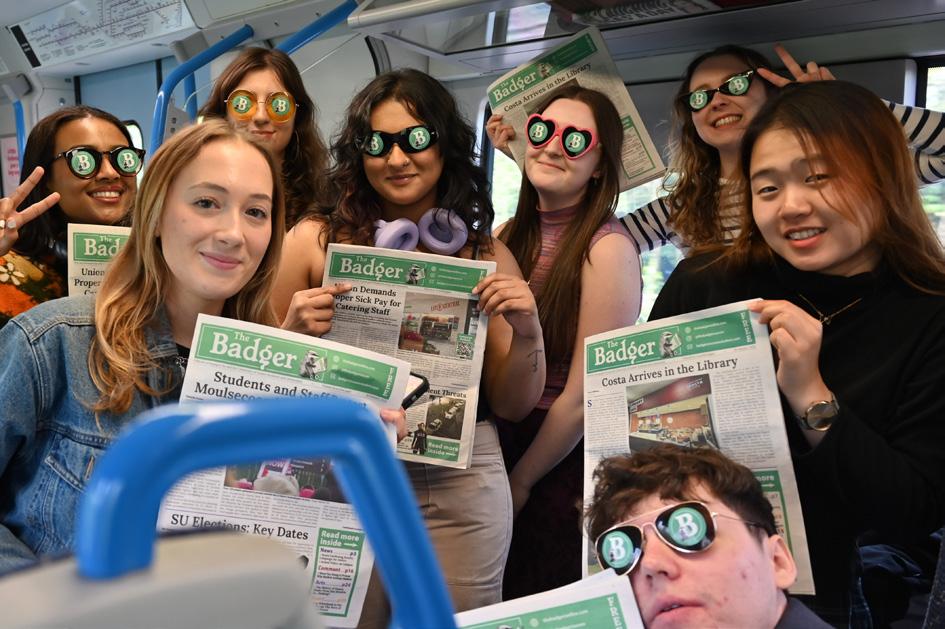
Hi, everyone! It’s been an honour and a joy being the Film and TV Editor for this year. I’ve loved every second of it, and I hope you all have loved the articles you’ve come across in my section. I’m especially grateful to Francesca for putting up with my bad grammar. Until next time.
Jemimah Kayode, Film & TV Editor
Can’t believe it’s time to say goodbye! Writing, editing, and designing the Sci & Tech section was genuinely so enjoyable. Six editions, forty articles — we did it! Thank you to our writers and readers. YOU made The Badger!
Jenny Choi, Science & Tech Sub Editor
As the term comes to an end, so does our tenure as The Badger’s committee. Calling it a bittersweet feeling would be an understatement. I have spent more time working on this newspaper than I have working on the Masters degree that I came to Sussex for, and I wouldn’t have it any other way. The Badger has given me a sense of community, and I am in awe of how INCREDIBLE the people that I have worked with are. Everything about this newspaper, including random typos in every issue, upload deadlines, and braving through awful weather just to hand out copies, has been extremely fulfilling. Special shoutout to the best senior committee ever, Semi, Ada, Francesca, Maisie, you inspire me so much and it was truly such an honour to work with you! And to our readers, thank you for every copy picked up, every Instagram story reply and every news tip, and be assured that The Badger is here to stay. For the last time ever (from me), happy reading <3
Akanksha Pandey, Senior Editor
I helped adopt The Badger in September, never foreseeing it would turn out this well. I’ve enjoyed every second running The Badger’s social media, liking all your shares and comments. The Instagram has been my baby this year, but it’s time to hand over the reins to next year’s teamand I’m so excited for Isabel Seesarun to take over as Head of Social Media. However, I’m a jack of all trades, so our physical readers may know me better as the Books editor. A year ago, the Books section was a side-lined one page near the back of the paper, and has now become one of our most popular sections! I love everyone (yes, even you) who has picked up a copy, you’re all invited to my future wedding. But here are my parting words before floating into the graduation abyss: keep reading – and follow @thebadgersussex on Instagram!
Maisie Knights, Books Editor and Head of Social Media
Being a Chinese exchange student, there were times when I doubted my ability to write for The Badger. However, these wonderful committee members have helped me regain my confidence. From being a sub editor to being shortlisted for a national award and attending the SPA conference, The Badger has not only allowed my journalism passion to soar but also rewarded me with affirmation and connections that I will cherish forever. My heart will always be The Badger! Cynthia Chan, Features Sub Editor

Wow, so this is it! The year has flown by so fast and I am so proud of everything that has been achieved. It has been an honour editing theatre, and proving that it isn’t all just singing, dancing, and jazz hands. In the words of Shakespeare: ‘parting is such sweet sorrow’. Bye, The Badger! Katie Waldron, Theatre Editor

It’s been my absolute pleasure to oversee the
working alongside and making
some
Sport Editor
Socially Responsible Investment Policy].” She made no guarantee that campus unions would be included. While this is regarded as a win for campaigners on campus, more significant is the repeated refusal to publicly condemn Israel’s actions.
maintains. “We are, and must continue to be, a site of intellectual disagreement and contestation.”
Members of Sussex’s Friends of Palestine society commented on Instagram (@sussexuni_fop): “[The response is] absolutely infuriating and very offensive to all of us. By NOT divesting [the University executives] ARE making a statement, which is pro-Israel and thus pro-genocide.”
activism” including threatening students with “serious implications” and “trying to intimidate academics.” In February, they reported that “students and staff, particularly those from the global South, have testified to a culture of fear and intimidation on campus.”
For those interested in supporting the pro-Palestine movement, sign the open letter, engage with demonstrations, and participate in the boycott of Israeli goods. A new Sussex for Palestine Campaign organised by Sussex students for further action has been set up: @sussex4palestine. campaign on Instagram. Palestine continued from page 1...
UCU Sussex commented on the VC’s response following their meeting: “Between 2022 and 2024 the University of Sussex had already reduced its investment in companies complicit in Israeli colonialism. What is gained by doing half a job, and doing it quietly? Sussex needs to build on these past actions, hold true to its institutional value of courage, and follow SOAS and the University of Glasgow in condemning genocide.”
In an email to a concerned student in November, Roseneil said “Taking a position risks alienating some members of our community,” a position she
Sussex has historically made institutional statements condemning the war in Ukraine, South African apartheid and supporting the Black Lives Matter movement. The University of Sussex AntiRacism Working Group has denounced the University’s “incoherent position on apartheid in South Africa and Palestine,” pointing out the hypocrisy of their statements and actions on other global issues but not on Palestine, as well as alleging other actions Sussex has taken to “discourage Palestinian solidarity
VC Roseneil’s message pointed to the University’s “rejection of antisemitism, Islamophobia, racism and hostility towards Palestinians, and all other forms of discrimination and harassment,” but many on campus feel that actions speak louder than words. The rejection of most of the requests in the student, faculty, and staff union’s open letter stands to demonstrate the erosion of Sussex’s position as a liberal, inclusive, and courageous university.
Steve Jackson, one of the SU FullTime Officers who attended the meeting with the University Executive, said in his personal capacity: “People should read Professor Roseneil’s words and make
their own minds up. Personally I find myself thinking about what I’d be doing if I was in the Vice-Chancellor’s position. I’d be fighting to do everything possible, everything in my power, to take a stand against genocide. Instead we’ve got a University leadership that’s seemingly trying to get away with doing as little as possible. I think students and staff, and the history books, will be right to question that.”
Abigail Keyla Staff Writer
Postgraduate students living oncampus will have their housing contracts terminated one week earlier than agreed upon, with students expected to move out from 7 September 2024, instead of the original 14 September date. This is due to an “earlier than usual start” to the 2024-2025 academic year, leading to “complications” with new students having to move into on-campus accommodation sooner than expected.
Johanna Nakatumbe, a course rep from the Business School, has said that students affected have reached out to her to say that they are “very annoyed” and do not feel “valued” by the University for their breach of contract. This is especially as many affected postgraduate students will be submitting
their dissertations during the period they are asked to leave the accommodation.
Being expected to move out before they hand in their dissertations has caused a lot of confusion and stress amongst those affected. Johanna reports that students are unsure how they will juggle submissions with the move out date, and/or are struggling to find housing in Brighton in light of the early termination.
With the ongoing situation, some students have felt resigned to the point where they are now looking to move out earlier to avoid disruptions later down the line. However, the tenancy agreement stipulates that to do so, they must find a person to replace their contract.
“So it’s like the [University] can change the contract but the students can’t,” Johanna reflected.
The University’s Housing Services
Team have contacted students affected since December 2023 about this change of contract, asking them to sign a form by February 2024. If students do not do so, the Team will assume that they agree with the new tenancy agreement and will move out by 10 a.m. on the new move-out day.
Affected students who have paid their rent in full will be issued a refund for the final week of their contract. Students who are paying their rent in installments will receive credit amounting to seven days of rent to their Sussex Direct account.
A meeting was reportedly planned between the Accommodations Manager on campus and affected students, but the manager did not show up. The manager later contacted students saying that they can reach out to him through email and “see what he can organise.”
Johanna says that the University should
do “proper planning” so that the same issue doesn’t happen again next year, “because, as much as it looks like it’s nothing, I think it’s something that can affect the [University]... especially new incoming [students].”
“Especially looking at my classmates, they are so annoyed, to the extent that they [don’t] want to give any feedback because [they feel] like it doesn’t help anything, especially with the Wi-Fi issue [throughout the semester], and [now] accommodation,” Johanna concludes.
If you are a postgraduate student affected by this change in housing contracts, please email the Housing Services Team at housing@sussex.ac.uk with the subject line “PG early end date” to receive housing support.
Sussex alumnus and founder of MarinaTex.
Two teams with ideas to produce or use sustainable fabrics have each won £5000 in project funding in the Pitch for the Planet competition. On 24 April, four teams stepped up to present their ideas for sustainable products, projects, or developments in the fourth annual competition held in the Attenborough Centre for the Creative Arts (ACCA).
The event was hosted by actor and climate finance activist Will Attenborough, and entrants were judged by Sussex Pro Vice Chancellor for Education and Students Professor Kate O’Riordan, Exeter professor and Sussex alumnus Dr Andrew Morgan, Sussex Business School lecturer Dr Shova Thapa Karki, and Lucy Hughes,
The first winning idea was presented by Senamile Sishi, MSc Energy and Climate Policy, who along with teammates Zanele Sishi and Michael Asante, is building a sustainable fashion business called StitchedByZan. They plan to use hemp fabric, waterless dyeing techniques, and traditional prints to boost their environmental and human sustainability. After the results were announced, Senamile told The Badger : “My pitching journey started last year at the Ideas Lab and Startup Sussex. I attended all the sessions, wrote, and pitched. I made it to the finals but didn’t win. However, I want to say, ‘Don’t be afraid of failure, just go for your dreams.’ With £5k, I’m excited to make things happen. I’m going to start by testing materials, developing market research, and searching for additional
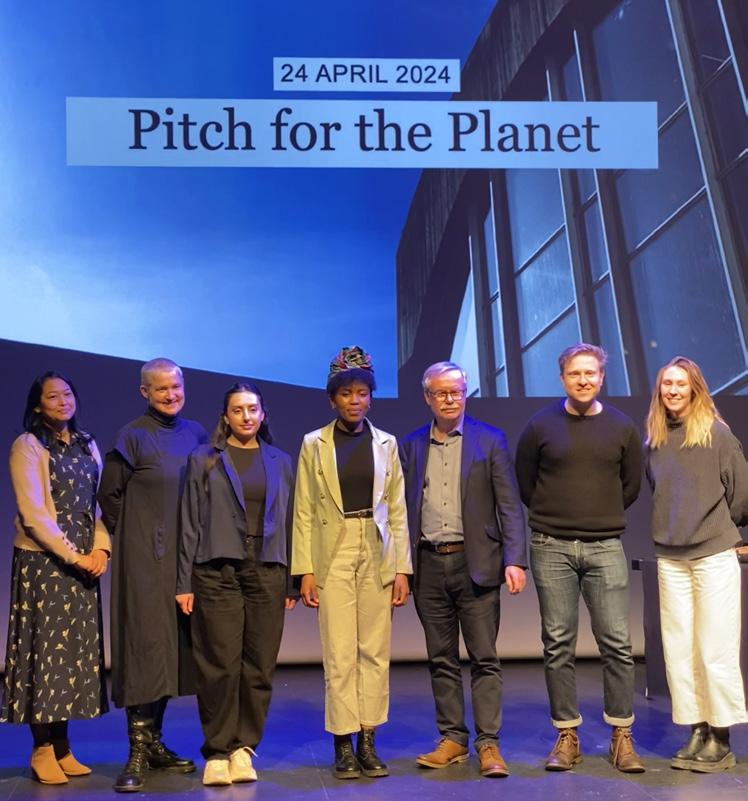
ways to run the business effectively. Excited to see the next step!”
The second winner was Arham Rahim, MSc Artificial Intelligence and Adaptive Systems, who is developing a chemical process to repurpose waste rice husk into vegan leather. She has already been testing the material, and passed out samples to judges during her presentation.
The other teams were also praised by the judges for their creativity, presenting ideas to review and improve Sussex’s sustainability policies, and to develop the use of coconut shells for packaging.
The winning teams will be supported as part of Sussex’s summer Startup Accelerator program, which aims to assist aspiring entrepreneurs across the University.

Osian Ahir Staff Writer
Following governmental warnings against the use of the building material Reinforced Autoclaved Aerated Concrete (RAAC) last year, the University of Sussex has been replacing identified areas of the dangerous material in buildings on campus. Work to replace RAAC ceiling panels in the stairwells of Bramber House was completed over the Easter break.
RAAC is a building material that was popularised between the 1960s and 1980s as a cheap alternative to concrete, as its air bubbles allow for faster installation and better insulation. As the Falmer campus was developed throughout the 1960s, RAAC was used in some of the University’s oldest buildings.
In 2018, the ceiling of a primary school in Kent collapsed. The discovery that it had been built with RAAC sparked increasing safety concerns about its widespread use in public buildings. At least three buildings of the University of Sussex have since been found to contain RAAC - Arts A, Arundel and Falmer House – resulting in closures
in these areas.
In September 2023, Sussex’s Director of Estates Robert Hutton announced the expansion of existing investigations into seven buildings on campus containing RAAC. He explained: “the University is planning each building’s RAAC replacement alongside other planned improvement works, so that we not only remove the RAAC, but we also enhance the working and study spaces on campus.”
The RAAC discovered in Bramber House stairwells has now been fully removed, with the scaffolding up since 2023. Rooms affected in the Chichester and JMS buildings were closed at the end of Autumn term for further surveys and safety measures, but have since reopened.
Other buildings affected are Arts A, Arundel, and Falmer House where affected rooms – including the Students’ Union Mandela Hall – remain closed but are monitored regularly.
Work on Falmer House is expected to start over Summer, allowing Mandela Hall to reopen soon and the Students’ Union spaces to run as usual once more. Plans for Arts A and Arundel are yet to be announced.

Akanksha Pandey Senior Editor
The Sussex Education Awards 2024 took place on 18 April at the Attenborough Centre for the Creative Arts (ACCA). These awards commend the academic and Professional Services staff of the University of Sussex, who have significantly contributed to the academic community and impacted students’ lives through innovative teaching. The event was hosted by Deputy Vice-Chancellor and Provost Michael Luck and Pro-Vice-Chancellor for Education and Students Kate O’Riordan.
This year, there was a record-high of 600 nominations for the award, with 450 submitted by students themselves. Professor Michael Luck, in his introductory speech, highlighted the central role played by students in these awards and acknowledged the staff’s role in shaping world-leading citizens and changemakers emerging from Sussex. There were a total of five awards, four of which were open to all staff. The Teaching to Disrupt Award was open only to staff with teaching roles.
The Teaching to Disrupt Award recognises teaching staff who have a different, innovative, and pioneering approach to teaching. There were seven award winners in this category, including Dyuti Ailawadi from Global Studies, David Berry from Media Arts and Humanities
(MAH), Elizabeth Mills, Lucila Newell, and Nat Arias from Global Studies, Pablo Iglesias-Rodrigues from Law, Politics and Sociology, and Warrick Roseboom from Engineering and Informatics.
The World Readiness Award recognises those who help prepare and empower students for life after graduation. Both individuals and teams received this award.
Carole Becker from Mathematical and Physical Sciences, Luis Ponce Cuspinera, Helena Joyce, and Luke Mitchell from Engineering and Informatics, Kathryn Mountford and Luke Mitchell from Careers and Entrepreneurship, and Graziana Di Pede from the Business School were among the fifteen recipients of this award.
The Better World Award is for staff actively engaged in efforts to make a positive impact in the local community and the wider world through entrepreneurial and creative ways. Atusa Saeipour from the School of Psychology, Chris Baker, Becki Cook, Anna Farlow, Jamie Smith from the School of Life Sciences, and Janine Thorogood from Student Experience received this award.
The Learning Together Award celebrates collaborations between staff and students working together on a research project or redesigning the curriculum. There were four teams who won in this category. The first team was the Informatics Peer Assisted Learning Team from Engineering and Informatics.
The second team consisted of Doran Amos, Apichaya Luathairattanametha, Kiran Lalli, Milly Rose-Wheatley, Nik Mylona, Soliana Markos, and Sophie Thorne from the School of Life Sciences. The third team to win this award was the Engineering and Design Mentors team from the School of Engineering and Informatics.
Finally, the last team to receive this award was from the School of Global Studies, consisting of Rebecca Prentice, Amy Breij, Lizzie Burtenshaw, and many more.
Finally, the Inclusive Sussex Award recognizes those members of staff who put into practice at least one of the university’s five core values of kindness, integrity, inclusion, collaboration, and courage within the context of teaching at Sussex. The recipients for this award were Amanda Griffiths from Counselling Wellbeing and Residential Life, Ayomikun Idowu from the Business School, Ambra Moroncini and Emily Baker from Media, Arts, and Humanities, and several others.
It was with great sadness that an award in the Inclusive Sussex category was also presented to Victoria Marrache, a member of staff who passed away earlier this year.
Victoria worked in the Student Advice and Guidance team, showing extreme empathy and patience while approaching students. She supported students and honoured their needs. Victoria’s partner joined the ceremony and accepted the award on her

behalf with a heart-warming speech that made the entire auditorium teary-eyed.
“Tonight was amazing – it was a fantastic celebration of the achievements of our staff at Sussex and what they’ve done for our students and their educational journey,” Professor Michael Luck said.
Professor Kate O’Riordan said, “The award categories are all amazing, but the two that spoke to me the most are the Better World category – particularly the awards that reflected LGBTQ+ inclusion, running the University’s food bank, and also doing outreach with the local schools. Also, the Inclusive Sussex Award shows an amazing array of activity and themes across that.”
The award ceremony was followed by drinks and canapés in the ACCA café.
Editor: Abi
Lucy Spencer Staff Writer
From 15 - 29 April, the University’s Students’ Union, Sussex Sustainability Research Programme (SSRP), and a range of campus food spots collaborated to bring to the community Sustainable Sussex Fortnight, a two-week event with over 16 events and activities to attend.
The University of Sussex is keen to promote sustainability, having recently implemented a biodiversity policy based on the feedback from its community. Their two key objectives focus on achieving a net gain on biodiversity and increasing the percentage of campus designated to nature to 42 percent by December 2027. The Campus Nature Walk, hosted on 29 April, was a perfect opportunity for students to observe the University’s progress. This guided tour of campus’s most biodiverse areas was also part of a worldwide citizen science event – City Nature Challenge –in which biodiversity hotspots across a multitude of schools were recorded.
The Sustainable Sussex Fortnight began with Green Futures, a careers event enabling students to build the required skills to apply for environmentally-friendly jobs. During this programme, attendees were able to hear from inspirational speakers from various green job fields, and were encouraged to take part in an interactive sustainability challenge.
Following on from this, SSRP Fellows Dr Perpetua Kirby and Dr Rebecca Webb, both from the School of Education and Social Work, discussed the importance
of education that can adapt to the sustainability challenges of the 21st century. Perpetua and Rebecca’s passion for sustainability is influential, with many MA Education students choosing to attend this event after being taught by the pair during the Autumn term. The Badger spoke to one student, Kiarra Bolade, who said, “Perpetua and Rebecca showed me that teaching can and should involve exploration, particularly of the world around us, and that all learners should be encouraged to do what they can to combat climate change.”
Also during the first week were two workshops hosted by The Veg Bowl cafe in Arts C, entitled “How to Grow Food From Waste”. These enabled students to discover how disregarded ingredients can lend themselves to a thriving garden of crops. As well as this, the cafe conducted a seminar on how to keep shop-bought herb plants alive, which proved useful as each herb variety requires different methods of care.
Arguably the most notable event of the fortnight was Pitch for the Planet on 24 April. This is an annual competition in which young social entrepreneurs propose their ideas on how to best face this generation’s key sustainability concerns. Read more about the prize on page 6.
The second half of the Sustainable Sussex Fortnight, Climate Justice Week (CJW), sought to address the interconnected crises of climate change, economic exploitation, and systemic racism. By bringing together a diverse range of voices, the University was able to prioritise justice, equity, and inclusion whilst addressing the climate crisis. Additionally, CJW aimed to
inspire individuals and communities to make meaningful changes, such as reducing consumption and adopting more ethical practices.
During CJW, some students were given a tour of Veolia’s Material Recovery Facility in Hollingdean, where over 60,000 tonnes of mixed recycling from East Sussex is collected and sorted. Veolia was awarded a 30 year waste management contract by Brighton & Hove City Council in 2003, and keen to educate people on the importance of recycling and for members of the public, including students, to observe firsthand what happens to their household waste. The members of the University in attendance, including the current Student Living and Sustainability Officer, Niamh Tickner, were given some invaluable tips on how best to recycle, including making sure all waste is clean, dry and loose (not in a separate bag) before disposal. Ensuring recycling is compacted is also important as larger objects tend not to be picked up by the trommel – a slow-rotating machine used to remove small contaminants from recycling. Finally, dispose of vapes in the recycling station outside Falmer House, as many contain batteries which can cause the machinery to malfunction.
The fortnight marked the end of the academic year for many students, and hopefully provided learners with the determination to enjoy a sustainable summer!
Badger Awards continued from page 1...
Chief Political Correspondent for The Times, which was a real full circle moment for our team.
The awards were for the following categories:
• Highly Commended for Best Lifestyle Piece: ‘UTIS: The What, The How, And The Why Me?’ by Lucy Spencer (Staff Writer)
• Winner for Best Culture Piece: ‘Jimmy Hendrix to…Nothing? A History of Music at Sussex’ by Isabella Poderico (Arts Editor) and Harry Turnbull (Music Editor)
• Winner for Rising Star (Best Newcomer): Semhar (Semi) Tesfazgy (Editor-in-Chief)
• Highly Commended for Best Overall Digital: Maisie Knights (Social Media Manager and Books Editor)
• Highly Commended for Billy Dowling Reid Award for Outstanding Commitment: Semhar (Semi) Tesfazgy (Editor-in-Chief)
We have worked incredibly hard over this year, slaving away to reinvigorate and revive The Badger from nothing. I am so proud of what we’ve achieved, and having us winning national awards after everything we’ve been through has been incredible. A massive thank you and shout out as well to Ada Carpenter and Francesca Sylph (Shortlisted for Best Design), Cynthia Chan (Shortlisted for Best Interview), Zeeshan Tirmizi (Shortlisted for Best Photographer), Francesca Sylph (Shortlisted for Best Culture Writer) and Will Symons and Kian Sheygan (Shortlisted for Best Sports Section). I expect us to bring back even more for Sussex next academic year!
Amina Daniel News Sub Editor
After increasing water bills earlier this year, Southern Water has now unveiled plans for an alarming 44% annual increase from 2025 to 2030. This places an unavoidable burden on consumers across the region who have no choice but to rely on Southern Water, and are forced to shoulder the costs of rectifying the inadequacies of a water system that has been neglected for decades.
For years, UK water companies have faced criticism for their rampant pollution of natural waterways, a situation which has recently become increasingly dire. Among these, the River Ouse in Sussex stands out as one of England’s largest and most contaminated rivers, primarily due to the continuous discharge of sewage by Southern Water. The company’s yearly release of billions of litres of raw sewage into local rivers and seas has led to high contamination of harmful substances, including dangerously elevated levels of E. coli.
The Badger spoke to local fisherman Neal, whose connection to the River Ouse spans back to 1986. He described the ongoing struggle as fishermen are pushed out of work due to the extent of river pollution. Fish numbers are dwindling rapidly, while certain species are contaminated to the point they can no longer be sold for consumption. Neal pointed to Southern Water as the problem – “big businesses aren’t thinking about the fishermen, or the environment. They’re just thinking about how much money they’re going to make.”
The restructuring of the water supply system under Margaret Thatcher’s government has drawn attention to the behaviour of certain large corporations for years. The privatisation of water companies in 1989 shifted control from public to private hands, meaning that the newly privatised Southern Water became reliant on investments from shareholders to function. This resulted in decades of cost-cutting and underinvestment in water supply infrastructure, as Southern Water prioritised creating enough surplus profit to pay huge shareholder dividends and
attract further investment. In the meantime, consumers are left with an inadequate water system, as Southern Water resorts to ever increasing sewage outflows to cope with volumes of water beyond its infrastructural capabilities.
In Sussex, multiple movements such as Love Our Ouse have emerged to combat water pollution. The Badger spoke to Matthew Bird, a group lead and mayor of Lewes, who describes the movement as ‘working to learn, celebrate, and act on issues surrounding the Ouse’. Fuelled by frustration over Southern Water’s inaction, Love Our Ouse campaign for recognising the River Ouse as a legal entity with inherent rights. This is based on the international Rights of Nature movement, as people across the world advocate for a shift away from understanding nature as nothing more than a market resource to be exploited for profit. They posit that just as corporations have legal rights, waterways such as the River Ouse, which is central to many forms of life, culture and relationships, deserve the same recognition.
Matthew emphasised that the system we
have at the present is fundamentally flawed, asserting that “it doesn’t matter how much greenwashing or what little bits of money come forward for different things, the current system does not work.” Investment in improving water supply infrastructure is urgently needed, but as Southern Water realises this, it also attempts to pass costs onto consumers through exorbitant bill increases, prioritising corporate profit over public and environmental wellbeing. The Love Our Ouse movement, as well as similar rights of nature movements worldwide, challenge the profit-driven approach of privatisation. The future lies in a move toward community ownership, prioritising humans and nature over making unnecessary levels of profit. Whether resisting unfair bill hikes, or advocating for a fundamental shift in recognising and respecting the rights of natural entities, the movement stresses the necessity to hold large corporations to account in the struggle that involves us all.
Student-led campaign group Access Sussex hosted a demonstration 1 May in Library Square to raise awareness for their fight for an accessible University of Sussex campus. The group published an open letter to the University prior to the demonstration that accused the University of not adhering to their promises of reasonable adjustments for disabled students. The letter demanded improvements in the awareness of reasonable adjustments, as some disabilities may prevent students from asking for help directly. It also called for a shift in the attitudes disabled students face, as many are targeted for having “unfair advantages” as a result of their adjustments. Lastly, the letter proposed that all reasonable adjustments must be offered to all students who qualify as disabled which can be aided through staff training and accountability. Disabled higher education students are legally required to have adjustments made for them under the 2010 Equalities Act which prevents direct and indirect discrimination, as well as harassment and victimisation. GOV.UK states that direct discrimination under the Act includes actions such as rejecting a student because of their disability. However, indirect discrimination can appear in the form of non-accessible application forms or exams, and students being unable to access certain
areas on campus due to their disability.
The University’s Student Hub lists the adjustments made to prevent these types of discrimination which include exam concessions, such as doing the exam in another room, having a support worker, and being able to start the exam one hour earlier. For assignment submissions, the University promises to remove late penalties, and provide alternative assessments such as distance exams or take away papers. For graded in-class presentations and group projects, they offer online solutions such as Skype presentations, or allowing students to email their group, instead of discussions in-person.
However, Access Sussex argues in their open letter that these adjustments are not being adhered to, stating that they are often “breached, ignored or poorly managed.” They also call attention to the fact that students have to go through a frustrating process of being directed to multiple members of staff before they reach a disability advisor or any form of support.
Moreover, students require a formal diagnosis, doctor’s note, or learning difference test result before they can even begin contacting staff to get the necessary adjustments, a process which can take more than 18 months. While the University
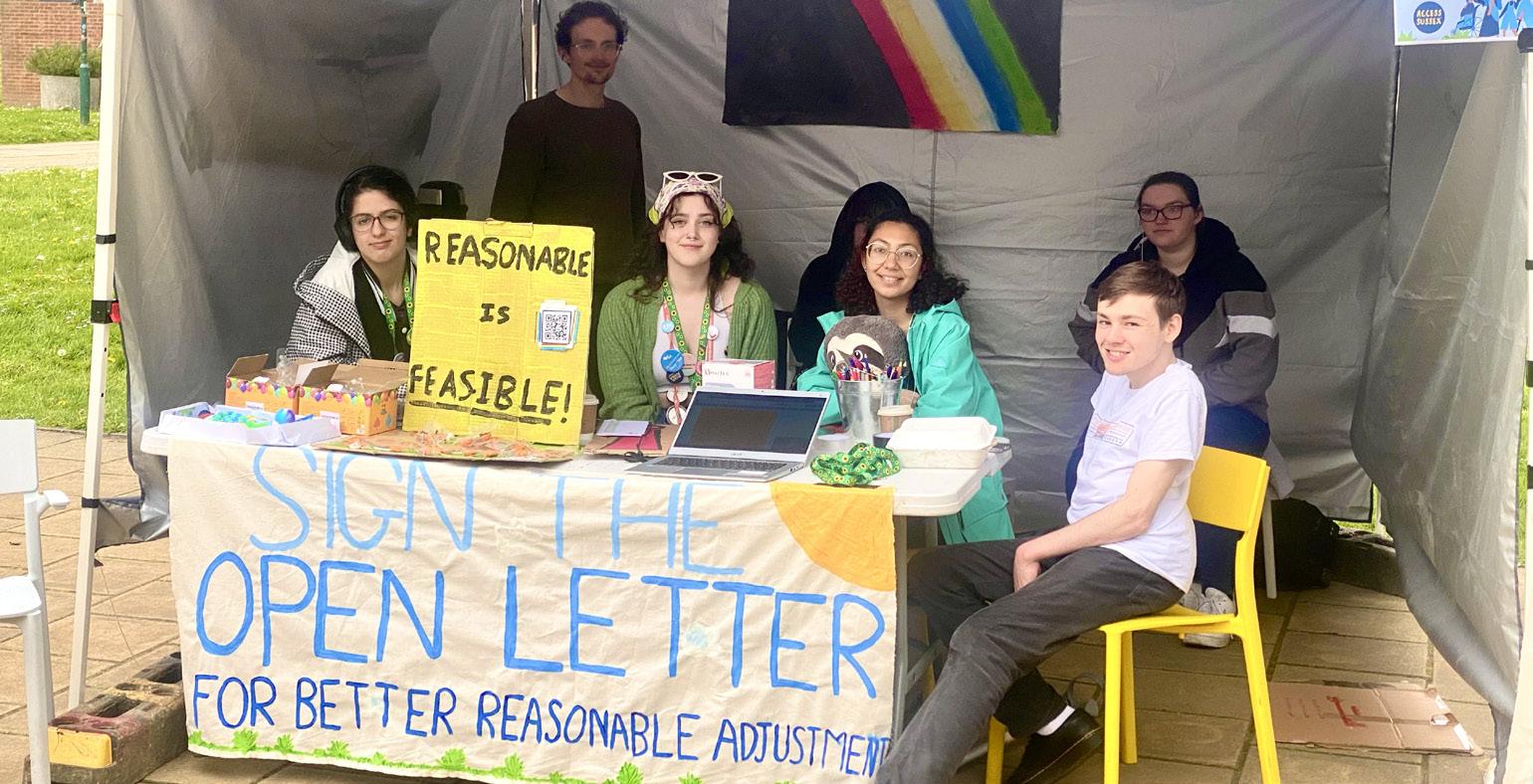

does provide ADHD and dyslexia testing, this is not a formal diagnosis, and can also have long wait times.
Lyds Knowles, one of the current Disabled Students’ Officers behind the open letter, spoke to The Badger regarding the demonstration, stating “we’ve been working on this campaign for the past few months, and have brought it to attention now as the Library is packed with students stressed about their May deadlines.” She emphasised that “reasonable adjustments aren’t just for disabled students; there are many students who might not see themselves as disabled who are also affected by these policies.” One example of this includes students who suffer with anxiety who “might need an adjustment that they don’t have to speak in class, but currently they would have to advocate for themselves to let professors know. It would be better if there’s a system to inform faculty of reasonable adjustments.”
The Sussex 2025 framework sets out aims to “transform the University so that our campus community has a fully inclusive experience.” They plan to make this happen by being “accessible, caring and flexible in everything we do.” Access Sussex and their campaign draws attention to the fact that the internal system issues must be addressed in order to meet this goal.
Jodie Fullerton Staff Writer
Financial struggles and budget cuts are an issue that most councils across the nation are facing at a rapidly developing rate. Brighton & Hove City Council have been confronted with numerous challenges in their public sectors, such as striking staff and vandalised equipment. The waste management industry is just one of the services facing the effects of budgeting councils and salary cuts.
According to the Local Government Association, more than two-thirds of local towns nationwide have faced disruption and changes to their regular waste collection services. Some refuse collectors may face unemployment or significant salary reduction due to the budgeting decisions made by local councils. Despite the government’s £600 million investment into local government budgets this January, councils around the country must make drastic changes to their spending in order to avoid joining the fourteen that have already had to issue a Section 114 notice, a declaration of bankruptcy.
The salaries of staff employed to local councils is the largest cost that councils have to budget for, as all “Council employee contracts dictate that staff are due a pay increase each year”, Callum McGoldrick, a
representative of the TaxPayers’ Alliance, claimed during an interview with The Badger. Resulting budgetary strains and cuts subsequently risk the wellbeing and safety of residents. Callum continued that “councils will often make cuts to services before attempting to cut internal cuts. Councils in the UK can raise council tax up by a maximum of 5% per year. By deliberately making services worse, they can argue that tax increases are needed.” It is not the salaries of the Council employees that are affected by these budget cuts, rather, the residents of local towns who are affected by the choice to reduce public services, such as bin collections.
Some councils, such as Lambeth and Birmingham, have reduced their collection
services from weekly to fortnightly, leaving households overrun with bin bags and bad odours. This change to the collection timetable leaves the streets of local towns overflowing with excessive amounts of general waste, increasing the chance of attracting animals and rodents to residential areas.
Brighton is not exempt from these public service changes and budget cuts, as despite the waste collections remaining a weekly occurrence, the Brighton & Hove City Council have, in the last two months, dealt with bin-lorry sabotage and talk of union strikes from angry waste collectors concerned about proposed redundancies, salary cuts and poor working conditions.
A ballot taken by union members at

Brighton’s CityClean depot revealed that 95% of workers supported acting against Brighton & Hove City Council’s planned redundancies. GMB senior organiser Lib Whitfield told Brighton and Hove News that whilst the workers of Brighton work hard to keep the streets clean, and “deliver a service, they’re being hampered by everything from vehicle breakdowns due to management not acting on defects, to inconsistent and unfair treatment.” The potential strikes have been an ongoing issue. In October 2021, the streets of Brighton were littered with excess rubbish after workers went on strike for two weeks; issues within the public service industry are still unresolved and are ongoing. Though investigation is still ongoing, at the end of March 2024 the Brighton & Hove City Council was faced with two of their bin lorries being vandalised, with the cutting of the lorry’s wires putting them out of service. The vandalism caused a “drop in the reliability of our refuse and recycling collections in recent weeks”, Labour Councillor Tom Rowkins stated. Due to this suspected sabotage, the Council has invested money into four new electric bin lorries. With the addition of these new lorries , the residents of Brighton will get more reliable and efficient collections. This may suggest that this intentional act of sabotage was indeed an act of protest towards the council.
Fiore Newland Staff Writer
Every week I venture into Brighton from campus for work, and every bus journey down Lewes Road, I was hit by the same questions: “I wonder if people actually live at the Peace Camp?” and “who are they?” These thoughts stuck with me, so I decided to sit down with some of the camp’s members and ask them before the camp packed up in late April.
Throughout my conversations, I found that more than anything, the camp was about the importance of community. While I had believed that their goal was to achieve something much more tangible and political, I found that the members I spoke to expressed a much more emotional and connection-based purpose.
I asked the members to explain to me how they manage daily commitments with life at the peace camp, and they explained, “no-one is here full-time, we all balance work, friends, and family.” I was also met with the overwhelming sentiment that this camp, for some, was used as an escape from the stresses of life, with one member explaining that the camp has given them a new sense of happiness. They explained to me that life can be quite isolating,

especially, for example, as a single parent, and the camp has given them a new sense of purpose; “I have learned here that everyone and everything is equal, whether it’s people, or a blade of grass, no one is more important than another.”
I also asked the members if they feel that their goal has been achieved; they explained to me that their goal was more about “holding the space” and having the camp exist in the first place. A member also explained to me that, “people are angry that they didn’t know about the arms factory in the first place, and our camp has spread awareness for something that
was quite sneaky.” Another member also said it’s powerful to see “what people are willing to give up for a greater cause, for example when the weather was really bad, the toilet tent kept collapsing, and it had to be reassembled multiple times.” The endurance of the members of the camp is hard not to respect, and I really got the sense that people from all ages and walks of life were welcome. It was also made clear that the climate was challenging for many members, and “the experience really puts you in touch with how others live without our privileges.”
When asked how they would inspire
more people to be involved in activism, a member said, “in order for there to be less harm and horror in the world, those who have everything need to give up some things like individual time, or physical state. It’s hard to live under capitalism - are the markers of success even real? Sharing spaces like these is so powerful.”
“
It’s powerful to see what people are willing to give up for a greater cause.
Illustrated by another member, was their interpretation of “surrender,” and “finding power in marginalisation in a creative and constructive way.” Someone else explained to me that “community is essential - nothing else matters from day to day, [whether that be for] dinner, or big goals politically”, and “in this community you learn to be less dismissive, and to talk to people with the intention of listening.”
As we all sat around the campfire, one member on my left repairing a knitted jumper, and another on my right making some trousers, I really understood what they meant. The idea of giving up the conveniences we experience every day for a political reason felt a lot easier when there was a fire and board games to play.
Nestled in the Lanes stands the lowkey frontage of Brighton’s sole Filipino restaurant, Bruha, crafting artisanal dishes with cultural fusion by a British-Filipino owner. It has not turned a profit for four years, but the owner said he asked for nothing but simply to “feed people with his (family) food”.
Sisig - diced pork and chicken cooked in coconut oil, calamansi juice and an array of ingredients - a traditional, quintessential Filipino dish and has become my all-time comfort food since my first taste. Served on a sizzling plate alongside a bowl of garlic rice, the harmonious fusion of flavours, meats, and rice offers me a profound sense of cultural immersion – a beautiful blend of Eastern ingredients and Western culinary technique that tantalise my taste buds.
Despite trying a similar dish in Hong Kong, it possesses a unique flavour here. Jay, the owner, explains that the ingredients are sourced directly from his home island in the Philippines, infusing the cuisine with a niche island flavour.
Equally remarkable are adobo - pork belly simmered in vinegar and garlicand kare kare - slow-cooked beef brisket in a sumptuous peanut sauce with bok choy and vegetables. Never can I predict their flavours until I take that first bite, as each dish is distinct, with its own unique flavours and twists that constantly creates new surprises to my palate.
But my favourite is actually the dessert
made from ube – a purple-coloured yam largely grown in the Philippines, which is not only served as food but also carries the symbolic meaning of Filipino resilience and adaptability. The more than 500 years of Spanish colonisation left the Filipinos adobo and cooking techniques with vinegar, and they stand up to create their own culinary identity with ube.
Names of the cocktails, such as Kapre - a tall, dark, and hairy creature resembling a tree giant for environmental protection - originate from Filipino myths and stories that are little known by the majority. The Philippines have a manifold and interesting culture that is worth hearing by more people, Jay says.
Running the business for four years without turning a profit has been an uphill battle.
“What does ‘bruha’ mean?” I am curious about the name of the restaurant.
“It means ‘witch’ in Filipino, which is taboo in the Philippines… My mum would never allow me to name my restaurant this way, but I’m a bit rebellious,” Jay says with a mischievous grin from behind the lush green leaves of a tropical plant. Across from him is the restaurant’s red brick wall, adorned with tiny cracks, remnants of its past as an antique fish market. A bag of rice is nailed to the wall, a cultural symbol of good luck from Jay’s Filipino mother.
I whiled away two weekend afternoons with my friends beside a large open window on the first floor of Bruha. The warm-toned, dim lighting is meticulously
crafted by the owner to enhance the most comfortable dining experience. On the shelf behind us, Jay’s personal collection of candles, second-hand antiques, and skeletons carrying the childhood stories his mother shared with him. He relocated all these decorations from his own room which is now empty. We engaged in conversations about life, culture, and reminiscing about our homes back in Asia – perhaps here, it feels like a home away from home.
Since my second visit, Jay has always greeted me with a warm smile, thanking me for bringing in new friends. But on my third visit, he told me it might be one of the last times I would see him, as the restaurant faces financial hardships. He shared with me the struggles Bruha has endured during the COVID-19 pandemic without receiving sufficient government support. Running the business for four years without turning a profit has been an uphill battle.
“I just want to bring my family’s cuisine to people,” Jay says. “It feels like doing a university degree, pouring all my effort, only to fail at the end.” Starting his own restaurant business from scratch in his late twenties, Jay utilised catering skills acquired since his youth in the Philippines, which was then further honed through learning within the Filipino community in the United Kingdom. Days and nights were spent in the restaurant, sacrificing friendships but dedicating all his time and heart to introduce his family’s food and culture to the British.
Unlike the strong flavours of Middle
Eastern curries or the delicate appearance of Chinese buns, Filipino food embodies the tropical island tastes that capture my heart. It carries the freshness, tropicality, and warmth of the welcoming and sunny islands, much like Jay’s smile that greets me every time.
The farewell words are tinged with hope for miracles - the hope to sustain the business, and the Filipino culture in Brighton, a city where Jay considers special and open-minded, and a place where he feels his rebellious spirit and his ‘naughty’ restaurant are right at home.

Semhar (Semi) Tesfazgy Editor-in-Chief
One thing that can’t be overlooked in Brighton are its shops. Bright, colourful storefronts make way for outlandish goods, fitting well with the name Brighton has built for itself as the ‘most hipster city in the world’, according to the Hipster Index. Peculiar shops are located across the city – not just at the North Laines we all know and love (to go broke at – I’ll never financially recover from buying a second-hand Carhartt coat…).
We’re going to take a dive into the exclusive and independent Brighton shops going above and beyond in their quest to stand out from the eccentric crowd.

This market is a hotspot for interesting goods at great prices. The place is always chock full of exciting stalls – but if you want to see the market in its prime, make sure to head over on a Saturday! When your legs get tired, drop by Korpan to grab some cheap and delicious Tteokbokki (Korean Rice Cakes).
Mimo
If you’re stopping off at the Open Market, make sure to head into Mimo. If I had to use one word to describe it, it’d be ‘kitschy’. Filled with weird and wonderful knick-knacks, jewellery, and everything pink, it’s a crime that this place hasn’t received more buzz.

4
If you’re decorating your room, head here before you buy. This place has a similar vibe to a record store – but with posters upon posters stacked wall to wall. Their deals for multiple poster purchases are also very reasonable – I personally have three hung up!

Please avert your eyes, people of sensitive dispositions. It lives up to its name, containing every X-rated item you can think of across its three floors. As Brighton’s largest ‘sexy lifestyle’ store, head here for all your candy lingerie, chocolate lube, and p*nis gummy needs.
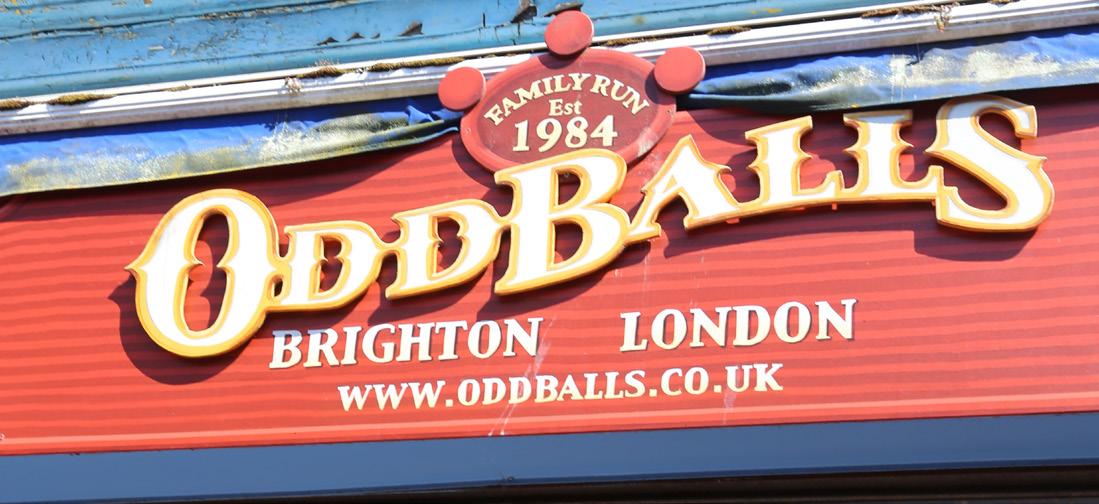
The name is pretty accurate. Flexing the title of the UK’s oldest juggling store, if you need to elevate your circus equipment this is the spot. As a juggling noob, most of the items are confusing to me, but the quality and range of items available is undeniably great.
Filling in the niche of Native American holistic goods, this shop is made for all the crystal horoscope girls out there. Walking in, you are bombarded by the musky incense, traditional music, and chill vibes.

This is an underrated gem. A twostory palace hosting over 60 stalls, it’s a glorious assault to the senses. Filled to the brim with vintage goods ranging from furniture to taxidermy, if you’ve dreamt (or had nightmares) of an item, this place has it.
You love ducks? You know someone who likes ducks? You saw a duck once? Head here. Every type of duck imaginable is available - not to mention the (very cute) collaboration ducks from popular franchises. Heartbroken that there isn’t a Badger Duck (Yes, I checked).


Been spending most of my life circling around Snoopers paradise ~ Awful reference aside… This place is a spending fest to behold. It’s huge. Be prepared to get lost, and make sure to visit the second floor – no spoilers here.
If you were head over heels for the outfits worn by Harper from Wizards of Waverly Place, run, don’t walk over to this adorable shoe store. From Lolita to cottage core, this place has it all.
Rosa Hernandez Staff Writer
For more than 5,000 years, yoga has served as a practice that promotes spiritual, emotional and physical wellbeing. In the 21st century, its proliferation around the world has caused it to undergo transformations in line with emerging fitness and wellbeing trends, with perhaps the most head-turning one of them being “puppy yoga”. What started out as a way to connect with your dog while engaging in this mindful and physical practice quickly became commercialised into very popular public group classes. Now you can attend classes surrounded by adorable puppies as you (try to) follow the moving and breathing techniques of the teacher.
In Hove, a new puppy yoga business has opened, said to be the first of its kind in Sussex. Founded by Brandon Mojica, 25, and Hayley Bianco, 24, Yogi Paws has recently started hosting yoga sessions with
puppies.
As the Yogi Paws owners promote, engaging in the spiritual and physical techniques of yoga while surrounding yourself with canine affection and energy has great benefits. Many advocates support the belief that the presence of puppies is extremely positive for your overall health, from helping with anxiety to maintaining healthy levels of blood pressure, even going as far as encouraging healthy appetite by reducing stress levels in your body. However, perfect as this may sound, critics have a multitude of reasons for which puppies and yoga should never be combined. Concerns are mainly focused on the dog’s welfare, with popular organisations such as the RSPCA arguing that forcing puppies to socialise with strangers at such a young age is detrimental to their behavioural development. Puppy yoga studios across the country have been put under scrutiny, as an ITV documentary revealed locations they visited undercover failed to care for the canine recruits in a
proper manner, depriving them of water to avoid urinating during sessions, and waking them up to interact with people despite uninterrupted sleep being crucial to a young dog’s development. Of even more concern is the risk of instigating unscrupulous puppy breeding, after all, these studios must get their puppies somewhere…
The owners’ love of dogs shines through their good care and compassion.
Regarding the practice itself, experts look into how the incorporation of animals strays away from the principles of yoga. To reap the benefits of yoga it is necessary to engage in its three key elementsmovement, breathing, and meditationall of which require deep concentration. How can one achieve such an attentive state of mind when a cute fluffy puppy is licking your cheek or chewing at your mat? Undeniably, this “innovative” proposal
compromises the ancient teachings of yoga, and so the question stands - has the western world once again taken it too far?
Nonetheless, it seems Yogi Paws has done a great job at countering these critics and establishing themselves as an ethical business. The owners’ love of dogs shines through their good care and compassion. The puppies come from homes where they are cared for dearly. The puppies are given time to rest and sleep in between sessions, and are not deprived of food or water. Their interesting session layout allows for 20 minutes of pure yoga, 20 minutes of puppy yoga, and the rest of the hour for simply puppy cuddles. This allows for customers to actually achieve successful yoga sessions whilst enjoying the presence of the puppies, who seem to be far from mistreated.
While its ambiguous nature is still of great concern, if you are craving some puppy love during a yoga session, Yogi Paws in Hove might be your best shot at doing it ethically.
Bec Nicol Features Editor
There has been a five percent surge in knife crime in the UK, with 46,367 incidents involving a knife or sharp instrument recorded in the previous year. In Brighton itself, the prevalence of knife crime is a worrying issue. It looms as a possible occurrence that could happen to any student on a night out.
The majority of knife crimes committed in Sussex between November 2020 and November 2023 happened in the centre of Brighton, with over 400 reported by The Argus. From this, some horrendous cases have transpired. In March, a 16-year-old boy was found guilty of murdering 17-yearold Mustafa Momand. Momand passed away from a single stab wound in October 2023 after being stabbed at the junction of Queens Road and Gloucester Road. He collapsed shortly after outside the Ibis Hotel near Brighton station.
Statistically, the risk of being involved in a knife crime - as the victim or perpetrator - is significantly higher for juveniles (1017 years) and young adults - males in particular.
So, why is knife crime so prevalent and
what draws this demographic to it?
The College of Policing UK released a report detailing what is believed to be the motivators for carrying a knife, as well as the risk factors associated with knife crime.
The three key motivators - firstly, for selfprotection and out of fear. Secondly, for self-preservation reasons, such as seeking ‘street credibility’. Thirdly, for utility purposes - to facilitate other crimes such as theft or to inflict serious harm upon someone.
The risk factors involve adverse childhood experiences and low school attainment, including school exclusion. The report also cited being around the age
of 15 (peak weapon carrying age) and a male is the riskiest demographic.
“
One in eight children under the age of 16 in Brighton live in poverty.
Knife crime occurs most commonly in cities in the UK, for instance in London, where the Metropolitan Police recorded 29% of knife crime offences in England and Wales last year. This may explain the prevalence of knife crime in Brighton - an ever-growing major city in the South-East which is only an hour or so from London.
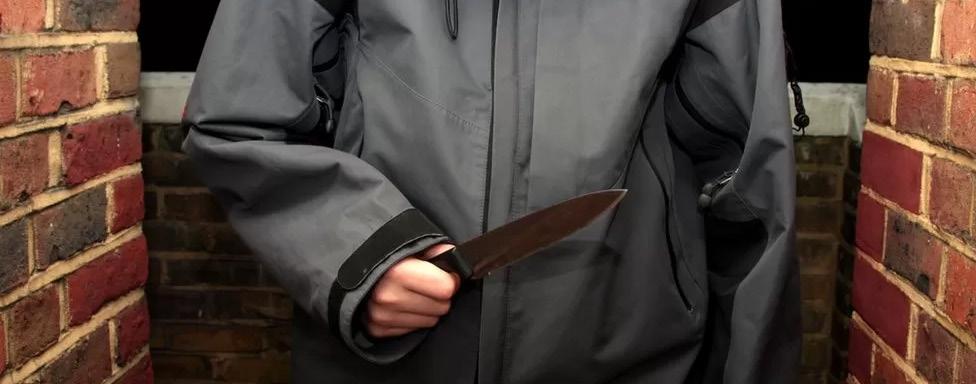
It’s easy to see how knife carrying comes about for young men, especially in the cities and surrounding areas in this country. Many children who grow up in cities in the UK live below the poverty line, something that has been particularly exacerbated in the wake of the pandemic and the rising cost of living - one in eight children under the age of 16 in Brighton live in poverty, and in London, around 33% of children do. As a result of living in poverty, many children in these areas are at a higher risk of being exposed to other issues in the home such as domestic violence.
When taking into account the adverse homelife of many young men which can lead them to spend large amounts of time out of home and on the streets, and expose them to the three motivators of weapon carrying - self-protection, selfpreservation and utility, a high rate of knife crime amongst this demographic is almost understandable.
In order to save the lives of young men on our streets, government and local councils need to tackle the core issues that make young men and even women susceptible to knife crime - like child poverty.
Jack Timmins Staff Writer
The title for this article is taken from an autobiography from Linda Bellingham, an actress who wrote about her experience of living with terminal cancer: the difficult and at times awkward feelings and sense of taboo that comes from facing one’s death. It is this taboo that drew me to write this piece.
The inevitability of death is exactly why it should be discussed.
It is natural to avoid thinking about dying, particularly for young people. If you are young and healthy, why do you need to think about dying anyway? It is normal to put it to the back of your mind, and if you do think about it, to presume it will be a good death - one where you die peacefully, surrounded by loved ones and a pain-free and gentle end to a long, happy life. It can be, and for some people it will be. But this is not a guarantee. The inevitability of death is exactly why it should be discussed. To live your best life, it is important to consider your best death, and one of the ways to ensure a good death is the principle of assisted dying.
You are probably familiar with
euthanasia but perhaps not with assisted dying. Maybe you think it is the same thing? The distinction between euthanasia and assisted dying is that the former is a deliberate act to end a person’s life for them, whereas the latter enables them to do it themselves. For example, euthanasia is like a doctor turning off someone’s life support machine, while assisted dying is providing a dying relative access to a lethal dose of medication. Both practices are currently illegal in UK law.
However, in March this year, Liam McArthur, a Liberal Democrat MP, tabled the Assisted Dying for Terminally Ill Adults Bill, which he expects to be debated in Autumn this year. This bill would make it legal for eligible adults to be provided with assistance to lawfully end their own life. However, it would only apply to those
living in Scotland. It is worth noting that assisted dying is legal in Switzerland, the Netherlands, Canada, Australia, and several US states. A recent poll from a campaign organisation, Dignity in Dying, revealed that 75% of the public supports assisted dying, with only 14% opposing.
“
It is time to stop assuming that everyone wants to stay alive whatever the cost, and do what we can to ensure people can have a good death.
One of the concerns is that if the law were to change, rather than giving vulnerable people – those in pain or with long-term conditions – more autonomy and control over their bodies, it could have

the opposite effect. It might add a sense of pressure on them to die, to remove their burden. There are also safeguarding concerns that the law could be exploited to coerce people into killing themselves, particularly women.
Fundamentally, assisted dying concerns only one thing – autonomy. It gives people the right to make their own choices. It is not about an obligation or justification for suicide, rather, it is about taking an honest, candid approach to one’s health. The reality is that there are people currently in terrible situations without any chance of getting better. They know this, and they understand this and decide that this is not the future that they want. However, they are forced to endure it because they have no choice. They are met with various arguments like life is precious, and that their symptoms can be managed. But if the pain is unbearable, surely it is more humane to respect their choices than reduce their symptoms and suffering.
As people are living longer, what was once a taboo, uncomfortable topic of conversation is now being rightfully discussed. Much like how cancer was once stigmatised and referred to as ‘the Big C’, it is time to stop assuming that everyone wants to stay alive whatever the cost, and do what we can to ensure people can have a good death. It is the responsibility of any modern state.
Editor: Cynthia Chan
Cynthia Chan Features Editor
Living a day as a local in the happiest city on earth has long intrigued me. This spring, I finally got to experience it on a solo backpack trip, where I discovered Amsterdam has so much to offer.
Stepping out from the Rijksmuseum, I hopped on a rental bike and soaked in the afternoon sunlight along the picturesque Amstel canal, blending into the daily commute of the Dutch. Craving fries, I entered a Dutch fries shop, where I encountered Rutger, a friendly-looking Dutch local. He greeted me with a relaxed smile, and curiosity sparked inside mehow do the Dutch live their daily life?
Seated on a bench by the canal under the tender spring leaves and warm late afternoon sunlight, Rutger told me he worked as an urban engineer, involved in building the city’s transportation system. He worked three to four days a week. Today was an ordinary day off for him, which he enjoyed strolling around the city, engaging in interesting conversations with strangers, or exploring new sights.
“You never know what you’ll see when walking, even on familiar streets, there’s always something new happening.”
Amsterdam is connected by bridges above beautiful, tranquil canals and accommodates large numbers of cyclists and pedestrians. Being one of the most cycling-friendly cities in the world where many residents have been on two wheels since infancy, cycling accounts for half of all journeys in the city centre.
With one third of the country below sea level, the Netherlands, which means ‘low-lying country’ in Dutch, utilised canals
during their Golden Age in the 17th century to manage water and prevent flooding. Today, these canals are the veins running through the country, shaping its lifestyle to revolve around water.
After a leisurely 10-minute ride, I stumbled upon a Brown Cafe - a local bar with brown interior walls stained by the lingering smoke of cigarettes from days gone by.
“
Happiness, or a good life, really depends on mindset, attitudes, and one’s community.
As a solo traveller, the loud laughters and feverish conversations swirling around me initially felt overwhelming. Yet, this vibrant atmosphere lured me in as an authentic glimpse into local life.
Taking a seat at the bar, I ordered an apple pie - the traditional Dutch dessert - and a drink. Across from me stood the bartender, with a hard-to-approach look. Carefully, I asked him about his work - I was just too curious.
“Listen, don’t get me wrong. I like my job because it’s a family-owned business that I am working for myself. I don’t like the Asian style of work where people work from 9 a.m. to 5 p.m., five to six days a week. There is no time for myself,” he said.
As for his life, he did not dwell on the past or worry about the future. “Just focus on now, and don’t take things too seriously,” Jan, the bartender said.
It was around 10 p.m. and I decided to leave. But Jan told me “we can have some very meaningful conversations if you have time”.
I could sense a connection between us - we were en route to explore our own
definitions of living a good life.
Stepping out onto the street, with every step I took, his words echoing in my ears - the longing for meaningful conversations burning inside me. It was my last night in Amsterdam, and I yearned to find answers about life. Ten minutes later, I pushed the front door of the restaurant again and saw Jan’s smile.
I got a kopstootje - a traditional Dutch cocktail of a genever shot served in a tulip-shaped glass with a separate glass of beer (Amstel this time). Amazed by the separation of shots and beer, Jan told me “drink the hot shot and cool it down with beer” – a quintessentially Dutch way of drinking.
Our discussion revolved around history, hobbies, and society. The night unfolded in typical Dutch small talk - a local custom where conversations about daily life prevail, surrounded by their exotic yet romantic Dutch pronunciation, though I could not understand a single word.
I finished the last bit of my sweet shot when the clock moved towards 1 a.m. It was time for my last and long-awaited question: “Do you think Amsterdam is the happiest city?”
He did not provide a direct response. Instead, he shared his personal experience of losing his parents, overcoming challenges and embracing life’s unpredictability. He said the Netherlands has the shortest working week, meaning relatively long periods of leisure and rest, which has earned it the title of the “happiest country”. But happiness, or a good life, really depends on mindset, attitudes, and one’s community.
Working three days a week, he lived a simple and content life now. Every morning he savoured a nice coffee two streets

away with his local and Australian friends, engaging in open-minded conversations. He viewed his life as brimming with opportunities to meet new people, explore new ideas, and encounter surprises every day.
“Come back here again after graduation. We will celebrate for you,” were the last few words from Jan. I did not capture a photo of his face, but I would always remember his deep, intelligent eyes.
I have travelled to over 10 countries in Europe, but the Netherlands offered something different that struck me. Cycling along the scenic canals brings me peace, but it is the genuine connections with the people I meet that truly allows me to rest my soul. By such, it creates the place that a solo traveller calls home. In this enchanting city below sea level, I found life.
Lucy Spencer Staff Writer
While some people eat to live, I live to eat. After spending two decades riddled with anxiety so strong it caused dysphagia and frequent vomiting, I began taking antidepressants, which enabled me to get out of bed and into restaurants. Yet the world of eateries is not quite my oyster - not that I would want it to be, because I don’t eat them. Or any fish. Or any meat. Or any dairy. Yes, like much of Brighton’s population, I am a vegan. And according to London North Eastern Railway, which analysed Google search data, Deliveroo’s vegan options, and HappyCow restaurant listings across the country, I am in the right place: Brighton was ranked the most vegan-friendly city in the UK in 2024.
But despite the number of restaurant options to choose from, veganism is far from friendly to the bank account. In 2023, The Times reported that pack sizes of plant-
based meals are, on average, 15% smaller than their meat-based equivalents, and 11% more expensive on a price-per-kilo basis.
Additionally, the University’s Co-op has a very limited range of vegan meal deals, with the mains often put in the ‘premium’ section, costing £1.50 more in total. But the contentious debate surrounding whether a vegan diet is truly more expensive than the alternative rages on, with research from Oxford University conversely revealing that consuming less meat could reduce the cost of food shopping by up to one third. Money may not be the root of all evil, but could be the root cause of why many stick to the diet they know. Citing the first study, carnivorous Brits can dismiss their vegan friends on the grounds that they can’t afford to embrace a plant-based lifestyle, when in reality it’s simply because they’ll miss McNuggets. Vegans, on the other hand, can provide evidence as to why forgoing meat is, in fact, cheaper, whilst lobbying for a tax on animal products to widen the difference in cost.
Due to this constant arguing, it’s no wonder that Brighton often decides to split up vegans and meat-eaters, in the manner of naughty school children. The latter can choose one of 500 Subways Brighton inexplicably seems to boast, whereas vegans are prescribed Purezza, where even thinking about a beef burger is forbidden.
“
Plant-based meals are, on average, 15% smaller than their meat equivalents.
If, as a vegan, you choose to leave Purezza and mingle with the future faces of the NHS’s leaflets on heart disease, the only way you’re getting a cheap meal is when chain restaurants accidentally bring you a meat dish instead of the plant-based version. Wagamama – I didn’t ask for my money back to be a Karen, but rather because, after three years of not eating meat, your mistake led me to believe I’d mistakenly consumed my cat’s Whiskas.
Looking at the evidence, the main reason behind veganism’s cost is seemingly artificial meat. But do plant-based diets have to contain OMV and Quorn products? Well, not really. My grandmother grew up in a village in Cyprus in the 1940’s and involuntarily maintained what would now be considered a vegan lifestyle. She once told me that she and her six siblings loved it when the neighbourhood cow would stroll into their two-roomed house because its chewing served as a bedtime lullaby. Rich she was not. Yet the Mediterranean diet of fruits, vegetables, grains and legumes was all they could afford, and she is still thriving at 86. Luckily, it finally seems as if meatemulating produce is going out of fashion, with sales of vegan alternatives falling by 16.8% year on year. But if the campus Coop introduced a fake BLT? I wouldn’t complain.

Molly Channell Staff Writer
Think of university as a nine-tofive job. Dedicating full days to sitting at a desk is not only unattainable but will reduce your focus levels. Design a personalised routine that includes regular breaks and considers your peak productivity hours. Try experimenting with different locations to see what works best for you. Study at your home one day, the campus library the next, and then try a café or the Jubilee Library another day. It is all about finding the best ways to be time efficient; work smarter not harder! Additionally, be cautious about studying with your friends. Although company can increase motivation and productivity, it can also make you side-track—ed. I know I have had study sessions turn into day-long gossip and deep meaningful conversation sessions. Adjust your study approach based on what helps you stay on track.

Time for Self-Care: Giving your eyes a rest from screens is crucial for improving your mindset. Prioritise self-care by setting aside time each day for relaxation. It could be a walk along the beach, a lunch or coffee date, having a pamper night or a kick about at the park with your friends. Even taking a ten-minute break to soak up some vitamin D — when the sun decides to come out. Do not beat yourself up for taking time off — listen to your head and your body — it will have a bigger impact than you think, on your work, mentality and wellbeing.
Exercise: Moving daily will help your mind reset and give you an extra energy boost. This does not have to be intense daily workouts; it could be a stretching session or a brisk walk.
Meal prepping: Many of us are culprits of falling into the trap of buying quick or expensive meals that have no nutritional value during this period. Try meal prepping some of your favourite meals or grab-andgo breakfasts to save your time and energy. If you like having a variety of meals, batch cook a bolognese or a dhal to freeze and eat throughout the assessment period. Ensure that your meals contain brain foods that help your brain function healthily.
Better Sleep = Better Grades: It is not a secret that a lack of sleep can have a big impact on your grades. But academic anxiety during the assessment period is something most of us are kept up with at night. I do not know about you, but I usually fall asleep thinking about literature reviews and data analysis. Sleep is the secret to better grades.
Bedtime Routine: In a perfect world avoiding screens before sleep would be easy, but that’s easier said than done. If you unwind by watching TV, switch your devices to night mode to reduce exposure to blue light. Reducing the amount of blue light on your screens at all times of the day would be most beneficial, trust me, your eyes will thank you. If you can, implement no screens before bed, read a book or listen to music that calms you instead. To make your bedtime routine even more relaxing, get some lavender spray for your room to help you sleep better and destress.
Napping: Myth buster time! Napping can be beneficial for your memory and recall, especially during this period. However, there is a fine line between over-napping and napping just right. Nap for no longer than 30 minutes to avoid your sleep cycle being disrupted.
Lydia Rosevere Staff Writer
With the rise of social media-based aesthetics, ‘cores’, and micro trends, it is easy to get caught up in the culture of overconsumption. The Costume Institute’s spring exhibition, Sleeping Beauties: Reawakening Fashion, with an aim to “breathe new life into stored objects,” feels like an ironic contradiction to the reality of the fashion industry, where the rise of micro trends has undeniably fueled overconsumption and ultra fast fashion. With the media’s influence on fashion, widely-publicised and influential events like the Met Gala should focus less on ‘sleeping beauties’ and instead wake up and start promoting sustainability in the fashion industry.
The 2024 Met Gala is the first event to be sponsored by TikTok, a platform that arguably breeds micro trends and accelerates fashion cycles. The irony of TikTok sponsoring an exhibition focused on the conservation of historical garments is undeniable, considering how its algorithm is set up to showcase hundreds of posts depicting trends that probably will be seen
as outdated before the end of the season. While social media can be a way of making fashion more accessible by acting as a source of outfit inspiration, it can be hard to find a balance between inspiration and an obsession with being ahead of trends. With our collective desire for instant gratification, it is hard for fashion and social media to coexist in a way that is not detrimental to both consumers and the planet.
Emissions from textile production will increase by 60% by 2030.
The emphasis on textile conservation in this year’s theme follows Kim Kardashian wearing Marilyn Monroe’s iconic Bob Mackie dress in 2022. While this was controversial in many ways, it did show the widespread popularity in re-wearing vintage clothes. It goes without saying that the Met Gala does not represent the clothes we wear on a daily basis (although I am sure many of us would if we had the money), and the average person is more likely to find a Shein knockoff in a high street charity shop than a historically significant dress. The rise in low quality clothes in charity shops impacts
those who rely on them the most, and it has become increasingly difficult for lower income people to find good pieces among the micro trends in a second hand market that is saturated with fast fashion.
Furthermore, the impact this has on the planet is detrimental, with these ‘outdated’ clothes often ending up in landfill if they cannot be sold. The United Nations Framework Convention on Climate Change (UNFCCC) predicts that emissions from textile production will increase by 60% by 2030, meaning that now is the time for companies and influencers alike to prioritise sustainability. The popularity of vintage clothing is something that should be timelessly celebrated, rather than a trend or a greenwashing shield for environmentally damaging brands to hide behind.
While it is great that the Metropolitan Museum of Art is focussing on sustainable and renewable conservation practices, it should be the responsibility of the fashion industry to follow suit. In this economy, it is basically impossible for the average person to spend a significant amount of money on one piece of clothing, and subsequently fast fashion is the only option for many. However, it should arguably be our job as
Small Incentives: Treat yourself, weekly or even daily! It does not have to be big. Whether it is a pint, a face mask or a sweet treat to keep yourself going, buy it for yourself, you deserve it. Acknowledge your progress and hard work.
Social Outings in Moderation: The assessment period does not mean the rest of your life has to be put on pause. Do not isolate yourself, social connections are crucial for mental well-being. Just be mindful of not overindulging in activities or drinking that may disrupt your productivity or sleep patterns. Swap a club night for a quiz night or a few drinks at Falmer bar before heading home from university. Save it for when you are celebrating at the end of the year.
End-of-Year Rewards: Book postassessment rewards! Whether it’s a special treat, a weekend away or concert tickets, having something to look forward to will provide an extra incentive to stay focused and motivated. Plus, it will be welldeserved respite.

viewers not to be influenced by what the internet considers out of fashion. Equally, companies should not use algorithms, where trends can drop off as quickly as they appear, to sell their products. The danger of buying into trends, without considering where the products will go after they are sold on Vinted or taken to the charity shop, not only impacts the environment but also speeds up trend cycles, landing fashion in a continuous downward spiral into poor quality pieces with a short shelf life. Buying second-hand should afford people the opportunity to buy good quality clothes that one can wear timelessly without worrying about being in style. So, if the Met Gala says we should reawaken fashion, surely it is time we de-influence micro trends and instead invest in pieces that make us happy.
Anonymous
Every Easter break, thousands of students across the UK make the journey to Croatia for a week-long holiday called ‘tour’, on behalf of their university sports teams. But over the years what happens on this ominous European excursion has become an open secret among Sussex sporting societies. You know the saying: “What happens on tour stays on tour.”
But someone has to say something –and it follows these simple lines: Alcohol, partying, and hazing, on a repeated loop, for a week.
Hazing is one of our campus’s biggest unkept secrets.
patches of hair left as if they had been attacked by animals. Men (although not from Sussex from what I could tell) were walked on their hands and knees with a dog collar and leash around the pool. I witnessed Sussex freshers being forced to stay in the ice-cold pool despite shaking and pleading to get out; young men on the H team with yoghurt dumped over their heads at breakfast and dinner, no time of day sacred – forced to climb on tables of people eating, sing, rap, entertain a crowd that felt nothing but sorry for them. I heard rumours of urination on members and in their mouths, lewd sex games at pre-drinks which borderline an orgy. And this is only the tip of the tour iceberg; there are things so filthy I cannot possibly write them in The Badger
multiple complaints from the hotel about the treatment of their freshers from other university students. It questions why Sussex is so cruel when away from prying eyes – and what happens behind closed doors.
“
Where
our Sussex sports teams are lacking in winning leagues, they make up for in torturing their freshers on tour.
is essential about this?
Remember folks, what happens on tour stays on tour. To anyone considering attending next year, make sure your team respects you as a person before putting down that first deposit. There is a fine line between being a ‘tour fresher’ and participating in the light-hearted fresher antics, compared to what I witnessed from the H and R teams. This article is not to shame and embarrass the men who were forced to complete these challenges throughout the week. If anything, my sympathy for them was so strong I wrote this article, despite the backlash I might receive.
“ It’s clear that change and action are needed immediately. “
Hazing is one of our campus’s biggest unkept secrets; many remember the events of tour 2023 which led to a Sussex team facing a lawsuit for hazing. I was not surprised to see this particular team was back to its top hazing form in 2024. Over the weekend, I saw H and R team freshers from Sussex publicly humiliated and socially tortured in front of our entire hotel. And no one batted an eyelid.
Many freshers had their heads forcibly shaved, arriving in Croatia with only
Naked humiliation rituals were common, with men running and crawling around with no clothes on at any given time. At one point, naked H team members were running around on the beach and swimming lengths, not stopping even when local Croatian children were pointing and watching. ‘I Love Tour’ staff saw this unfolding, and instead of stopping the hazing altogether, the men were made to put on underwear instead.
Many other students at different universities were horrified by Sussex’s antics. It is alleged that the H team received
It quickly became evident to me that where our Sussex sports teams are lacking in winning leagues, they make up for in torturing their freshers on tour. This is a gentle suggestion that they put this hazing energy and enthusiasm into their sport. Is being part of these teams (you’re not exactly Olympians, boys, so not a brag if we’re being honest) worth the stress and humiliation of hazing?
I heard rumours of R boys not being allowed to drink water, shower, or change outfits throughout the week, no matter the heat. The singular outfit the R team were seen in included t-shirts with racist and offensive jokes about the wearer on the back. Ironically, the company running this trip, ‘I Love Tour’, has ‘Essential Life Experience’ as their slogan – what exactly
I address this final closing to Ardi, our recently elected Sports, Societies and Events Officer: What are you going to do about this? Your campaign focused almost entirely on sports societies and wanting to make better changes for our campus. Well, it’s clear that change and action are needed immediately. This article has highlighted the beginning and those you need to focus on. Act now.
Harry Turnbull Music Editor
The world is in a phase of consistent mediatisation, with knowledge, history and ideologies at the fingertips of any and all people. With the sheer volume of cultures, subcultures, and trends now in the public eye, it is increasingly difficult to pinpoint a means to define this era.
“
The abundance of cultural options has led people to try and balance everything as a means of escapism.
In the 70’s, spandex, sequins, and the regal sounds of rock bands such as Led Zeppelin and Pink Floyd flooded the public consciousness. The 80’s shifted the appeal to big hair and even bigger leg warmers, with pop culture taking after Marty McFly and Han Solo as fashion icons. The 90’s was filled to the brim with denim and dance hits. But now, the abundance of cultural options has led people to try and balance everything as a means of escapism. I believe that the primary motivation for this mixture is a general sense of nostalgia; the romanticisation of a ‘better’ time. For younger generations, this is perhaps instead anemoia - one’s feeling of nostalgia for something not personally experienced.
If we take for example the current film and television climate, most Hollywood blockbusters are no longer original projects, but remakes and reboots. In the 2020’s, two of the top five grossing films at the box office (so far) were sequels of films made at least 10 years prior. Joseph Kosinski’s Top Gun: Maverick accumulated an impressive $1.49 billion at the box office. Whilst this could be put down to a stellar plot and strong performance from the franchise’s icon Tom Cruise, the element of nostalgia and anticipation for the return of titular characters contributed substantially to this film’s box office success. A quote from Quora explains this, citing that “the original film is a cult classic, and the sequel reunites fans with iconic characters, as well as introducing an exciting new storyline”.
A retro fashion trend has also been increasingly prominent outside the film and television world. The biggest comeback of the 2020’s must be the mullet. The iconic 80’s hairdo was sported worldwide back then, including by icons David Bowie, Paul

McCartney, and George Clooney. Though its popularity waned in the 90’s and 2000’s, the mullet made a drastic return over the COVID-19 lockdown of 2020. Perhaps this was thanks to the virality of Netflix’s Tiger King, with the infamous Joe Exotic unapologetically flaunting the controversial hairstyle, but its return is also yet another nostalgic trend The return of the mullet into the public sphere has introduced a new generation to a whole new means of individuality and expression. With the emergence of a new wave of LGBTQ+ acceptance, it seemed like the obvious route that the queer community reclaimed the BBC article entitled ‘Thoroughly Modern Mullets: Style’s Unlikeliest Comeback’, stylist John Vial commented on the influence of the mullet on queer identity: “It was an incredibly safe place to be. If you were a lesbian who wanted to feel slightly more boyish, you could wear your hair shorter around the
frame and have the safety of the length in the back. The same applied to boys who wanted a bit more hair.”
Whilst the mullet was not and is not exclusive to the LGBTQ+ community, it has a distinct inclusivity that allows anyone to experiment with trends that aren’t defined by gender or sexuality. I’d go so far as to say this hairstyle can bring a community together for the better, and its connection to the past makes it all the more credible.
“
I’d go so far as to say the mullet can bring a community together for the better.
With nostalgic trends making a comeback in the 21st century, some can argue that it is leading to a lack of originality. Ghostbusters Afterlife has been criticised for its overreliance on the 80’s cult classics to drive forward the plot. One IMDB reviewer explains why this was a flawed approach: “I’m sure it’s great for fans of the original but if you haven’t seen it - it’s not. It’s mostly boring, aimless, and wraps up quickly near the end.” With the long-awaited Beetlejuice sequel releasing this year, over 30 years after the first, and Disney live-action remakes showing no signs of slowing down, could nostalgic tendencies dictate our future? We’re heading for a retro-futuristic cultural landscape, and I’m not mad about it.
Charlotte Berry Opinion Editor
Should student newspaper opinion sections stir up controversy? It’s like adding hot sauce to your meal - some love the kick, while others worry it might be too spicy. But I think a little controversy is good for the soul of a student newspaper.
Controversy grabs attention. Opinion sections that toss in a few controversial takes spark conversations, get people talking, and make sure our voices are heard amidst the minefield of current events. Objectivity can become boring and repetitive, people read newspapers to learn and laugh - preventing controversy could make a paper seem sterile. Opinion and controversy help you to understand the facts, whilst keeping it interesting. For me, opinion was the gateway drug into journalism. Only after I had read an opinion article did I feel strongly enough to write in agreement or opposition to it.
“
Controversy pushes us to question, analyse, and maybe even change our minds once in a while.
Which brings me to the brain food factor. Controversy isn’t just drama for drama’s sake; it makes us better humans. When we read opinions that challenge our own, it helps us to develop critical thinking
skills. Controversy pushes us to question, analyse, and maybe even change our minds once in a while. It’s how we grow, learn, and become more openminded individuals - and more equipped students!
Controversy is good for society too. Think about it - some of the biggest changes in history came from shaking things up and challenging the status quo. Entire monarchies have been crushed and revolutions organised from a radical idea. Opinion sections that dare to be controversial can spark movements, challenge power structures, and give a voice to the underdogs. By controlling the content of an opinion section, you control the kinds of authors that get the opportunity to be published. Authors can represent the perspectives of entirely different cultures and lifestyles to your own. By giving authors a chance to write

about their side of the story, we could be amplifying the voices of a marginalized community. It’s like lighting a fire under social progress. And if that community so happens to be bad news, and it generates supporters, we now know who to avoid in
Now, we hear the sceptics out there. Controversy can sometimes feel like stirring the pot. There’s the risk of spreading misinformation, fueling division, and just making a big mess. But here’s the thing: a little controversy doesn’t have to mean chaos. We can keep things civil, fact-check like pros, and stick to our journalistic The team is pretty damn good at their jobs. Letting valuable stories on campus stay unwritten for the sake of keeping the peace
would promote ignorance and silence the truth. Besides, what would be the point of a student newspaper if we did what we were told?
What’s more, controversy helps to bypass editorial bias (although this editor may be a little biased). An editor may not agree with the opinions they publish, but they wouldn’t be fulfilling their civic duties if they did. Controversy diversifies the paper and helps keep it neutral (which is very different from being objective). With great controversy comes great responsibility, after all.
“
We can dish out those hot takes without resorting to name-calling or spreading fake news.
So, here’s the deal: let’s embrace the controversy, but keep it classy. We can dish out those hot takes without resorting to name-calling or spreading fake news. By setting some ground rules for respectful debate, we can keep the conversation going without encouraging malice. Student newspaper opinion sections should totally encourage controversy. It adds flavour to our pages, gets our brains buzzing, and maybe even changes the world a little bit.

Yesenia Mahe Darlington Staff Writer
Newspapers, and subsequently journalists, are an essential means of informing the public on current affairs and relevant topics of discussion. News sources must be factual and impartial, delegating the task of offering differing viewpoints to the opinion or comment section of a paper. This section also provides the opportunity to discuss topics that readers believe to be important which may not be covered in the regular news cycle. While it may seem like a natural reaction to agree that platforming multiple sides of an argument is a good thing, when it comes to subjects plagued with controversy, the outcome can only be harmful.
This often occurs when it comes to subjects relating to race, religion, sexuality, and gender. Encouraging controversy directly affects marginalised groups as they become prime candidates for harassment and online abuse. This can be perfectly encapsulated by the ongoing debate surrounding trans people. When
an article is approached in good faith and aims to spread awareness or relay new information, it might only serve to reignite existing prejudices. When an opposing view is presented that denounces the validity or rights of trans people, it spreads further hatred and amplifies that perspective in an echo chamber. Regardless of the intent of the author, marginalised groups are caught in the crossfire between the article and the public despite never signing up to be part of the discourse.
“
Encouraging controversy directly affects marginalised groups as they become prime candidates for harassment and online abuse.
Additionally, while it is the ethical responsibility of the press to remain impartial, there will always be human shortcomings. They may be impartial in a basic sense, but plenty of papers do have right-wing or left-wing biases that affect their readers. For example, The Guardian is commonly viewed as favouring left-
wing ideology, whereas The Daily Mail is infamously sympathetic to right-wing beliefs. This then translates into having a bias toward which authors are platformed, clearly demonstrated by recent articles. ‘It’s clearer than ever that Brexit has failed - let’s not inflict its miseries on young people’ is the headline in The Guardian’s Opinion section. In The Daily Mail’s Comment section, an article opens with the statement that “we know from a wealth of experience over the years that the political Left have little respect for freedom of speech”. This may be a more exaggerated demonstration of what type of controversial opinions are published by each paper, yet it still highlights how partisan the information being presented is. They only legitimise one angle of the argument, but for controversial opinions to be approached in good faith, an opposing view should be presented within the same platform. As this is rarely the case, readers do not receive a well-rounded understanding of the topic. This partiality is exaggerated as individuals tend to prefer to read from only one or two newspapers; this type of loyalty results in people forming
their opinions based upon others who have ingrained biases. Indeed, it is irresponsible for newspapers to encourage controversy while not presenting the full picture.
“
Opinions are not always grounded in facts and may be used to serve the bias media has.
The opinion section can be people’s first exposure to topics they had not considered before. They can have a great impact on people’s subsequent own judgement; as it is the first encounter of this information, what is presented is often seen as superior and factual. However, opinions are not always grounded in facts and may be used to serve the bias media has. Misinformation can be easily spread when unchallenged, which in turn leads to an ideological echo chamber that also discourages fact-checking. Marginalised people are the victims of controversies, encouraged through a form of media that has implicit bias.
Charlotte Berry and Zeeshan Tirmizi Opinion Editor and Sub Editor
To wrap up this year’s paper, we got back in touch with our Student Spotlight interviewees to see what they have achieved since we last spoke! We’ve loved showcasing how amazing Sussex students truly are.
Miri
Musician, Radio Host, Youth Mentor
“I’m still a youth mentor for Audio Active, and I’m now a radio host for Platform B! I had sex for the first time since my transition which was so affirming. I modelled for a binder company called “For Them”. I booked my top surgery through “Neda Transgender Surgery” in Istanbul. It’s a safe space created by trans people for trans people. It makes me think about how I felt during our last interview. I wanted [top surgery] so bad, I needed it. Top surgery still isn’t recognised as something that saves lives. I am going to feel like myself for the rest of my life. Weirdly, people have so many opinions about it.”

Rio Drag Queen

“Since rising to campus stardom and being recognised by no one I have gained so many new skills. While procrastinating my dissertation, I now sew my looks every time I perform. I got cast in Season 6 of the Next Drag Superstar competition in London and have since been networking with the other queens. I’m finally branching out with venues and my skills are on full display. I will be at Queen of Hoxton on 1 May for the Next Drag Superstar final, and I will have a go at some comedy at the R-Bar charity roast on 5 May. If my lovely Sussex cohort wants to witness me look stunning in something self-made, follow my Instagram @theaurorablake!”

“Since participating in the interview, I have become more determined in my plans and goals for the future. My master’s degree is in Media Practice for Development and Social Change. Social changes are more about changing society at the grassroots level through daily activities. I want to use the knowledge I have learned and combine it with my interest in football to explore the significance of football on race and gender issues. I am a Chinese football vlogger, so I often mention these in my videos. This week I will go to watch the Arsenal Women’s football match, I hope it can bring me some inspiration.”

Nigerian Chevening student, Green Impact Project Assistant
“Well, same old (OG)henechovwe. I have been engaged in sustainability on campus. As a Green Impact Project Assistant (GIPA), I supported the Sussex Sports Department in taking sustainable and green actions. I engaged their staff through email, sharing various sustainable tips, including reducing their digital footprint and plastic waste. An exciting part of my role was engaging with the Head of Sports on sustainability and researching the five negative environmental impacts of Sussex sports. As a sports enthusiast, this experience has made me reflect on how sports can become sustainable and also support the fight against climate change.”

Andrea Neurodivergent MA student from Mexico
“I have had several activities since the interview with The Badger. One of them is that I have been focusing on getting the Master’s degree done, through creating two essays and the thesis, due in September of this year. My tutors have given me the social tools to have more friends and be able to participate more frequently in the seminars of the classes; since I consider myself a person who finds it difficult to socialise and read people’s intentions. Another thing I have done after the interview has been to keep in touch with my family and friends in Mexico. I have also been going out with my boyfriend and my friends from the Master’s degree.”
Megan Delaney Staff Writer
Ioften fall into a spiral of fantasising about every possible other choice I could have made in my life, which would mean I would not be sitting here right now doing this. Maybe if I were having a miserable time, it would be understandable that I feel this way. But I love what I study, I love where I live, and I genuinely enjoy the life I lead. So, what is the problem?
I find so many things enjoyable, and the fact that I have to choose between things is an impossible task. To pick one is to give up another, and my regret after making a choice is suffocating. When I first read the fig tree analogy in Sylvia Plath’s The Bell Jar, I finally felt seen. She depicts how a tree branches out before her, and on every branch hangs a fig each representing a different path her life could take. In front of her were different versions of herself: a poet, a wife and mother, an athlete and so on. As she
stands at the foot of this tree, unable to choose a path to embark on, she watches as each of the figs shrivels up and dies at her feet as she “starves” with indecision.
I battle with my fig tree daily. There are so many things I want to do, and so many versions of myself that I would love to be.
I seek comfort in the fact that many other people relate to this, but even still, I find the feelings of regret impossible to shake. It reminds me of my decision to drop out of uni a few years ago, which felt like the end of the world. Even though it felt right, I now look back and wonder if that version of my life was the ‘right’ one, the right fig. I realise that this is just the manifestation of being a chronic overthinker. In reality, so many good things came from that decision, and although it’s natural to think about what could have been, it is an insidious task to regret the present.
Decision paralysis is a recipe for insanity. I’ve fretted over so much, from choosing my module courses to a brand of mouthwash. But I’m finding it easier to brush these thoughts away. What helps
is finding small amounts of good in my current reality. For instance, I’ll have one hard lecture, spiral, and convince myself that my degree was the wrong choice. But instead of letting this consume me, I now try to find three good things for every bad. Instead of focusing on what I didn’t like that day, I’ll go and find three other interesting things from the module that I have enjoyed. It’s small, but it helps me to appreciate where I am without getting overwhelmed. The looming presence of the fig tree can be seen in one of two ways: it can stand for the lives you did not choose, and you regret letting that fig rot. Or you can see it as a gift. To have so many interests and passions in life means you will always have something
to strive towards, another version of yourself always waiting to take shape. Remember that the fig tree will blossom again, and more figs will grow. Just make sure to look after


• The first edition of Union News, the University of Sussex’s student newspaper, was published.

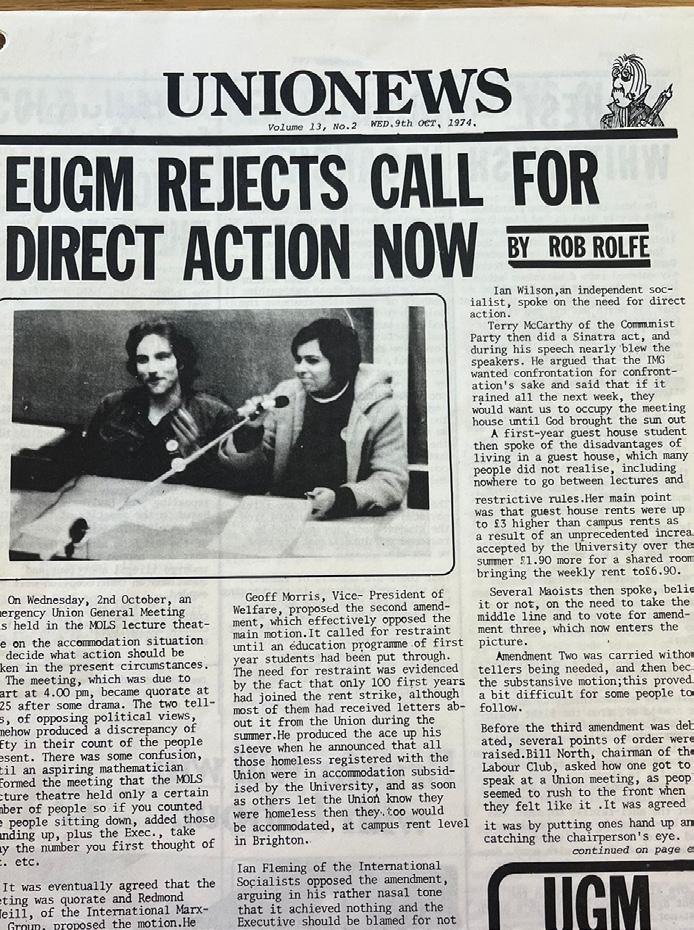
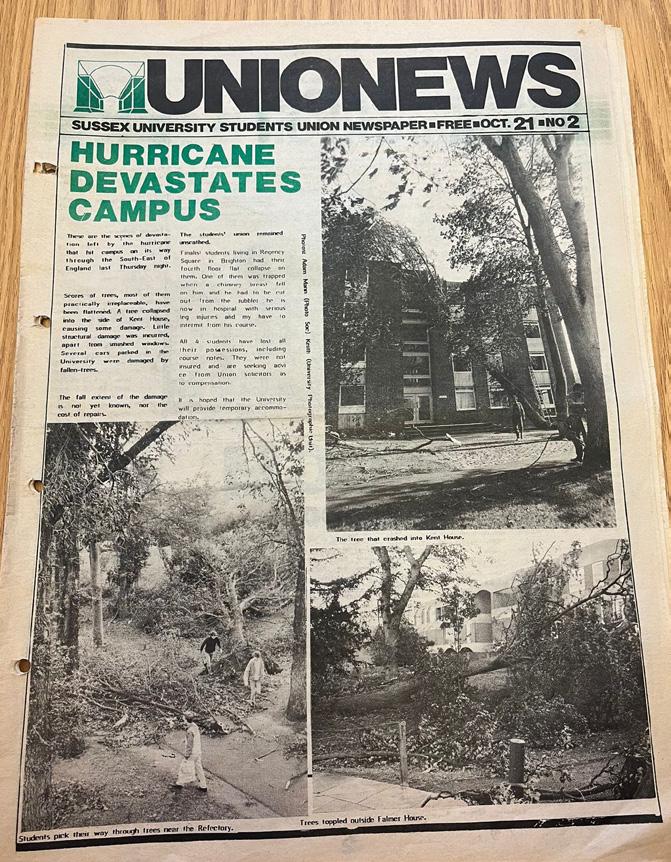
• Students occupied Sussex House for 10 days to protest the proposed axing of 90 jobs.
• The great storm of 1987 devastated Falmer campus.
• The Badger reports on the AIDs crisis internationally and in Brighton.

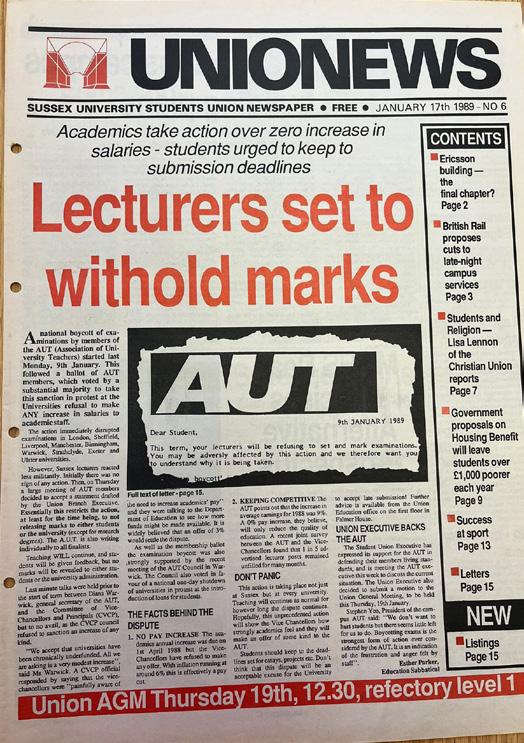
• COVID hits, but The Badger keeps publishing... mostly. A tough few years ahead.


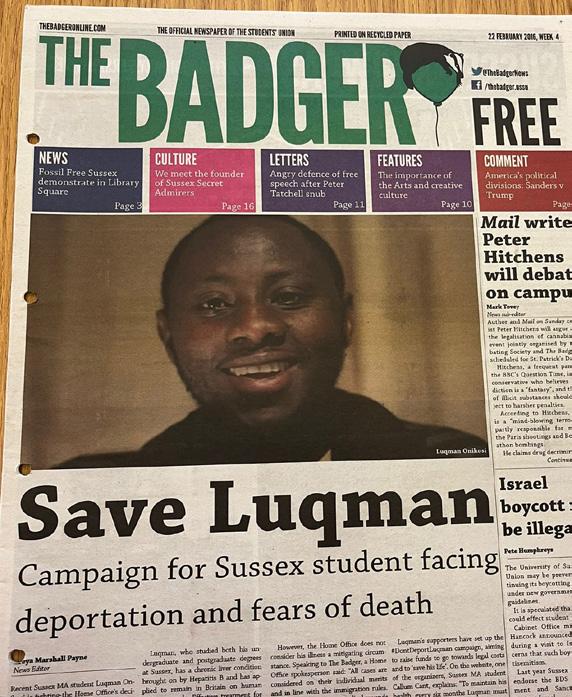

First distribution day for the new committee 1987 1974

• The “core four” - Semhar (Semi) Tesfazgy, Maisie Knights, Will Gaffney and Anna Hills - saved The Badger when it went up for society adoption after being alerted by Professor David Berry that the newspaper needed a new team. Little did they
Aug 2023

• Sussex lecturers withheld marks due to a national boycott of examinations by members of the AUT (Association of University Teachers).
• East slope balcony collapsed, injuring a student.

• After a referendum, students voted for The Badger to become independent from the Students’ Union. However, as far as we can tell, it seemingly never happened…
• Student protestors occupy Bramber House over Luqman Onikosi’s “death sentence” deportation.
• After recruiting at the Freshers’ Fair, The Badger is reborn with over 100 editors and staff writers.



2015



2015
• The University of Sussex’s Students’ Union seized copies of The Badger and fired the then Editor-in-Chief Paul Millar. Major newspapers including The Guardian report.

• The first edition of The Badger from an entirely new committee is published and distributed across campus (as you can see, we were very enthusiastic).



Carpenter and Francesca Sylph



• Sussex’s Rugby Team was disbanded for two years and forced to pay over £15,000 in damages after their summer tour. Head to page 13 to see if they’ve learned their lesson…

meets Aubrey Allegretti, EIC in 2014
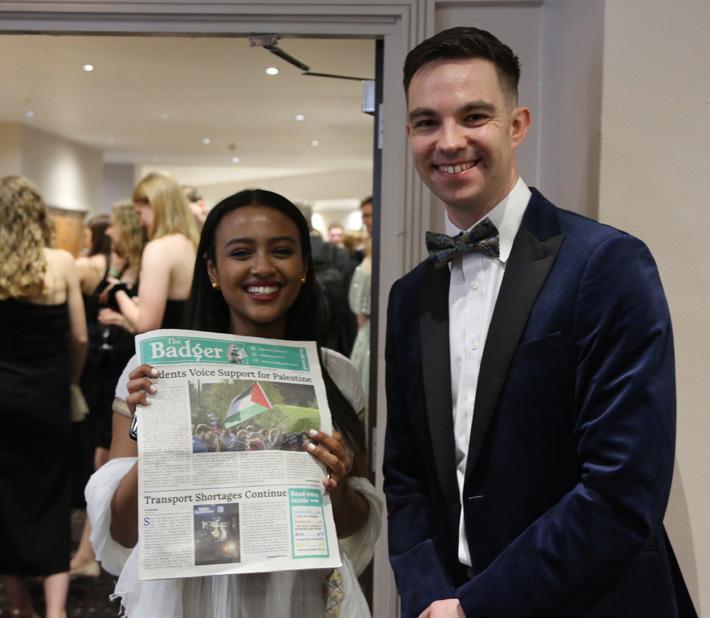
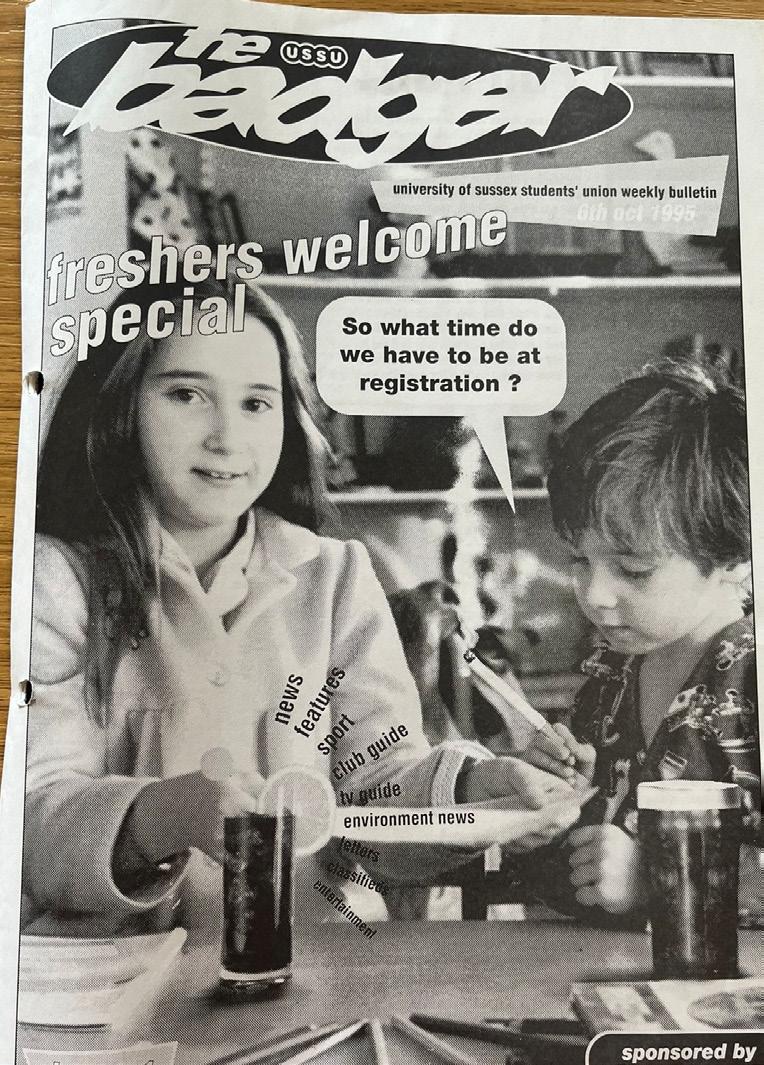



• Members of The Badger committee attend the Student Publication Association National Conference (SPANC), and bring home five awards!

• Union News was renamed and the first edition of The Badger was published.
• The name is reportedly after local Badger beer, after the newspaper ran an ad for it.


• Ten Sussex students, all members of the Palestine Solidarity Society, visited Palestine to show solidarity, raise awareness and interview locals.
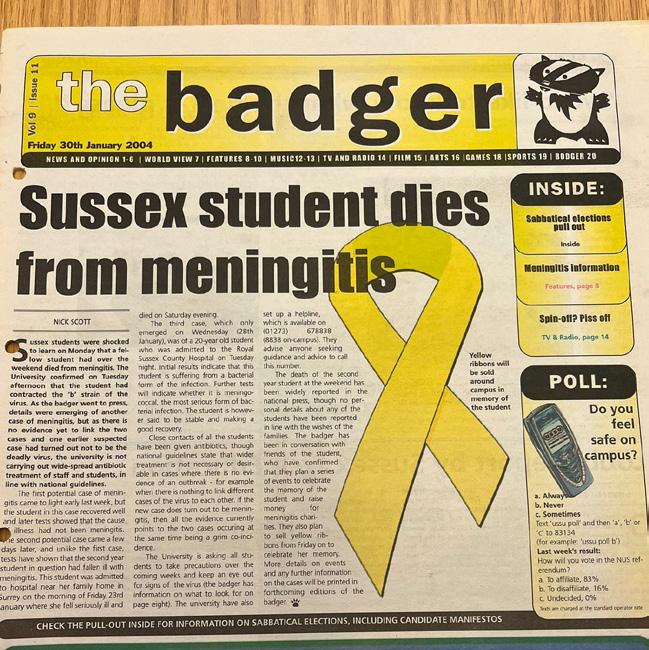
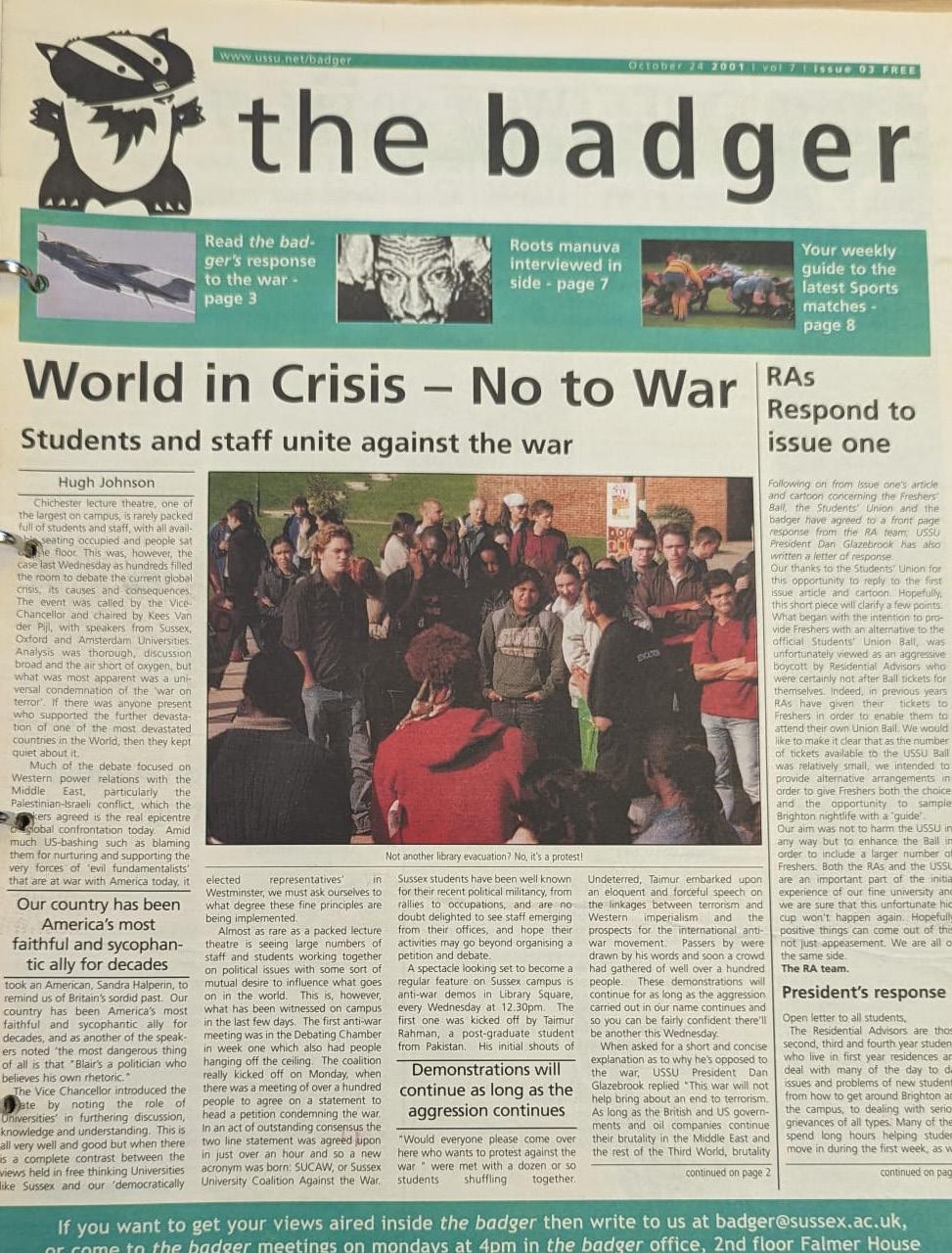


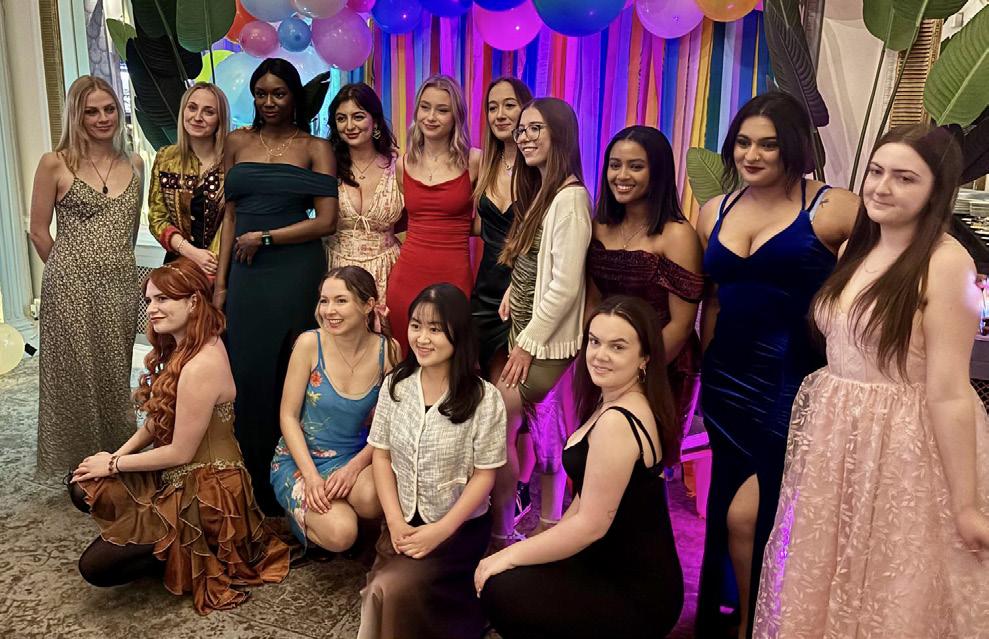

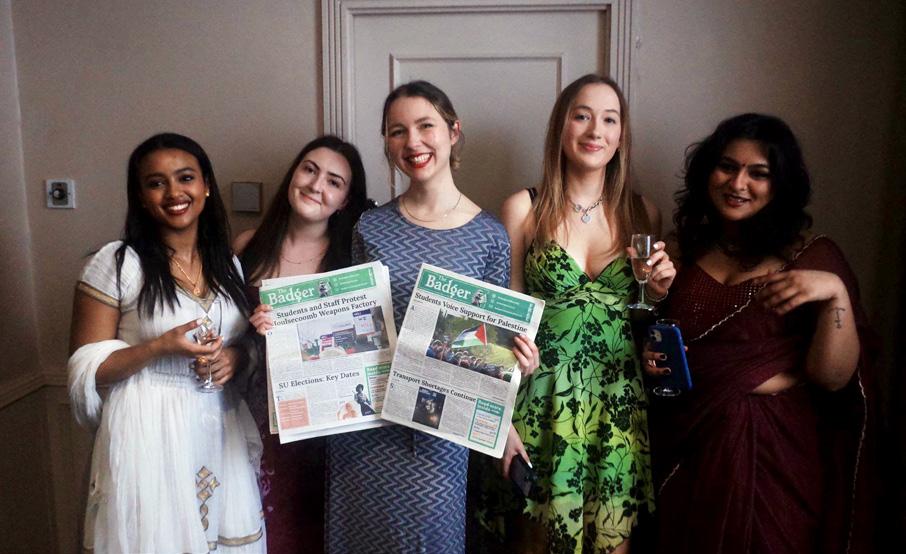
• In collaboration with University Radio

Thomas Barlow and Sean McCord Staff Writers
The Israeli government's occupation of Gaza and blockade of aid is genocidal. The situation has been ongoing for over six months, and some aid organisations have left Gaza and stopped their supply of desperately needed food and healthcare assistance due to safety concerns. Ongoing famine in the Gaza Strip has killed thousands - Oxfam recently stated that “since December the number of people in Gaza who have plunged into catastrophic levels of hunger has nearly doubled.” Living and studying in the UK, we may feel as though we have no power to help the people of Palestine. And, as students, money is undoubtedly tight. But there are other ways to support the Palestinian people:
1. Emailing your local MP
Whether at home or university, emailing your local MP can show our representatives that we will not be complicit in genocide. If enough constituents repeat the message, they will have to pass on our concerns to the powers that be in Westminster to call for a ceasefire.
2. Taking part in student action
Sussex’s Friends of Palestine Society plan plenty of events you can be a part of. Planning your own fundraisers is also super easy, an email to campaignsadmin@sussexstudent. com or events@sussexstudent.com should help point you in the right direction.
3. Downloading the Chili App
Chili is an app that provides daily incentives and instructions to pressure policymaking departments to act in favour of environmental concerns. With Israeli
military action creating a surge in fossil fuel consumption, Chili directly combats the companies profiting from the production of Israeli arms.
4. Donating directly
If you do have some spare change, Save the Children, Islamic Relief, Medical Aid for Palestinians and the Middle East Children’s Alliance are some examples of NGOs and non-profit organisations helping victims in Gaza.

5. Cooking for Palestine
Whether this be a barbecue or an attempt at Palestinian foods like rummaniyeh, get your friends together and appreciate Palestinian culture. Attendees can be encouraged to donate to charities doing crucial work now in Gaza.
6. 5-a-side charity football match
A football match consisting of two teams putting together prize money. The losing team donates to a Palestinian charity, or for those extra generous, you can donate the entire pot.
7. Sports sweepstakes
Collecting sweepstakes from large groups for the current Premier or Champions League, the upcoming Euros, or any other sport is an uncomplicated way to encourage your friends to donate.
Despite the busy schedule we all have as students, we hope these fundraising and volunteering opportunities are compatible with the stress of upcoming deadlines. Any support shown with and for the Palestinian people by Sussex students goes a long way.
Jude Budworth Staff Writer
Israel’s intelligence services have been discovered to be using an artificial intelligence system dubbed “Lavender” to identify and locate Palestinians suspected of being active members of Hamas’ military wing and the Palestinian Islamic Jihad (PIJ). In testimonies given to journalist Yuval Abraham for a report published in +972 Magazine, six Israeli intelligence officers with experience using the Lavender system revealed how personnel were reduced to mere “rubber stamp[s]”. Israel’s unscrupulously systemised use of technology removes individual complicity in the excess death caused by such systems of assassination. It provides a ready scapegoat for the accusations of breaches of international law, and genocide.
Israel’s unscrupulously systemised use of technology removes individual complicity in the excess death caused by such systems of assassination.
The Lavender system operates by identifying potential targets associated with Hamas or the PIJ based on intelligence data and puts them on kill lists that are given to the Israeli army. In the initial stages of the war, the system identified 37,000 potential targets. According to the +972 report, this system differs from another
artificial intelligence system previously used by the Israeli armed forces named “The Gospel”, which identified buildings suspected of being used by militants rather than individuals.
This system of targeted assassinations is justified through the designation of “human targets” which, before the current conflict in Gaza, was limited to highranking officials of militant groups such as Hamas. Since 7 October 2023, the Israeli army has expanded this definition to include all operatives of Hamas’ military wing. The massively increased list of potential targets meant that personnel had to be sidelined so that the Lavender system could handle the increased workload, despite it being known to make “errors” in 10% of cases and targeting people with only a loose connection to militancy.
A Lavender programme called “Where’s Daddy?” would track selected targets and notify the army when the target returned home.
A Lavender programme called “Where’s Daddy?” would track selected targets and notify the army when the target returned home, at which time the army would carry out an air strike against the target’s home. These strikes would often be carried out at night whilst the target family was present. For lower-ranking targets, “dumb bombs” were utilised to reduce expenditure on precision ordnance. A Guardian article cited experts who believe this could be one of the reasons why death tolls have been so high in Gaza.

+972’s sources stated that after the system had been approved by Israeli officials, just two weeks after 7 October, the system was given clearance to be used widely across the armed forces. The system should then be received by Israeli soldiers as the equivalent of an official order. The use of artificial intelligence as an indiscriminate tool of surveillance and a producer of mass casualties is a frightening development in warfare. Israel’s significant advantage from the use of AI, especially considering the International Court of Justice’s (ICJ) genocide accusations, is that it can be used as a scapegoat. Under the official context of relieving a data bottleneck, the Lavender system makes it harder to identify the “dolus specialis” (or “special intent”) required to prove genocide. Suddenly, the thousands of innocent casualties can be attributed to individual misconduct or as a result of the system’s failure, rather than an intentional attempt to murder civilians.
We in the West will not stay sheltered from the type of suffering in Gaza. AI is already being used in the war in Ukraine under US tech firm Palantir. Israel has been accused of using Gaza as a laboratory to test newly developed arms. Instead of the IDF using AI against Palestinians, it could be the Metropolitan Police using AI against Palestinian solidarity rallies that are so often labelled as “hate mobs”. This is the dystopian future come true.
Isabella Poderico Arts Editor
Ohhh, so you played The Sims right? Or Minecraft, but you don’t actually go caving or beat the game?
Whilst both those statements are certainly true about myself, girls don’t just play Stardew Valley or It Takes Two We dabble in Phasmophobia, Uncharted, Dead by Daylight, Resident Evil, World of Warcraft, Disco Elysium, Valorant. You name it. We play it.
Over the pandemic, everyone found different little new hobbies to delve into in order to distract themselves from the crippling boredom that would otherwise be faced. For me, new little activities popped up here and there, but nothing truly stuck. Until…
An advert appeared on my YouTube, a game a little strange, unlike anything I’ve seen before. Immediately I’m sucked in, and it’s too late.
Now I have crippling shame for the game I played for a good two years of my life, and you can certainly feel free to judge or hurl abuse, as it is well deserved. I played

FLeague of Legends (LoL), a game so terrible and yet so exhilarating that it was almost impossible to stop. If anyone reading actually plays the game, I mained Neekoby far the cutest of all the one-hundredand-sixty champions available. Within the gaming community, judging me for playing this game is completely justifiable, however I have never received backlash for it the way others may have. I seem to have some privilege that has softened the blow of the amount of criticism I have received for playing this heinous game. I’ve been on first dates where I mentioned in passing that I enjoy video games, and unfortunately I cannot lie to save my life, so when asked my most played game the truth would always slip out. “League of Legends” I’d quietly mumble, hoping they couldn’t hear me. But surprisingly, despite the extortionate amount of hatred LoL players often receive, I have never encountered that in real life. I think it may have something to do with the fact I am aware I don’t look like your stereotypical Discord mod, a privilege may have something to do with how I am treated as a female gamer. As a girl gamer, everything nerdy that I am
into doesn’t make me a ‘neek’, it just makes me ‘different’, or ‘unique’.
Men are allowed to make mistakes in video games, with little to no judgement.
Women, on the other hand, face crippling backlash.
My experience playing LoL as a female player is very different from someone who is a man. Women are vastly outnumbered on online multiplayer video games, and in my experience they definitely make only a minority of players in League of Legends. My gamer tag at the time was “TescoPrincess”, an obviously gendered title that often made me the target of sexist comments when playing. Dying in a game could mean constant harassment by male players who blamed my failure on my gender. The misogynistic culture perpetuated by players was ultimately one of the main reasons I retreated from playing LoL, along with the fact that I desperately needed to get my life back on track. And whether it
was through chat abuse, or the people I was playing with screaming into their mic at me at the smallest of a misplay, I always noticed. Men are allowed to make mistakes in video games, with little to no judgement. Women, on the other hand, face crippling backlash from their supposed teammates. Comments like “it’s not your fault you’re a girl” were the most aggravating of all.
I would only go back if the raging, stroppy and sexist men who played along side me sort out their own major issues first.
I retreated from online MOBAs (Multiplayer Online Battle Arena) like League of Legends for good reason, and I don’t really intend on returning. For me, it was unhealthy, an addiction, and while I’m sure I could have slowed down into having a positive relationship with the game, I would only go back if the raging, stroppy, and sexist men who played alongside me sort out their own major issues first.
or every fashion-obsessed kid who had unfiltered access to the web, there was no greater game than MovieStarPlanet.This “free-to-play” online social game had an absolute grip on me - I needed the latest accessory (most likely a moustache - it was 2014, sue me), hairstyle or outfit as a matter of life or death. Being able to make attention-seeking art books or movies begging fellow Moviestars for likes was groundbreaking, and this innovation meant the website at its peak saw on average ~150,000 users online at a time. With such a large volume of users, this meant the bustling chat rooms were… memorable. The words “Type 123 if u want 2 be my BF/GF ;P” are engraved in my memory, along with the countless arguments almost entirely consisting of the ‘*’ symbol due to the game’s censorship running rampant. This is a game that defined my childhood and is part of what shaped me (for better or worse) into the person I am today.


The procrastination demon possessed me, recently, to log into my Neopets account from 2008. The legendary virtual pets website celebrates its 25th anniversary this year, and after a tumultuous decade of uncertainty over management, it has recently been relaunched for a new generation. With over 55 types of pets to adopt (including my favourite - the squirrel/ rabbit-looking Usul), and 20 lands of Neopia to explore, the Neopets lore is seemingly endless. From faerie quests to secret treasure maps, it’s easy to see how it captured the attention of millions of children around the world. The other attractive part was the hundreds of unique minigames (Hassee Bounce anyone?), and the totally unregulated neofriend forums. But it wasn’t just timewasters; it was Neopets that I first learned how banking and interest works - not to brag, but I am in fact a neopoints millionaire - and I even traded virtual stocks and bid on rare items in auction. Neopets was so successful because it let us play at adult life through amazing fantasy stories. Now when I’m sick of reality, I’ll go and take care of my neopets instead.

Nothing sounds like the early-mid 00s like the whirring and clunking of a family computer firing up, and ours was a shrine to The Sims 2. It took four discs to install but from then on you could insert disc 1, grab a drink (or a five-course meal) in the time it took to load, before slipping straight into Pleasantview. My favourite part was always creating my new family and the mounting excitement of preparing to enter them into a world in which they, and so I, could do anything; an attractive concept for a small child with little power over anything else. Once the family was perfected and the house bought, my older siblings would shatter this illusion and forbid me from using cheats to earn money. I soon lost interest in struggling to afford necessities like a toilet. Now, however, whenever I want a blast from the past, I’m happy to load up a shinier, newer version of The Sims and motherlode with a vengeance.

As we come to the last edition of this academic year, I thought it fitting to return to the same show I reviewed in the first edition.
It has been a long year for Invincible fans. After more than a two and a half year wait, fans were ecstatic to find out that new episodes of Season 2 would be arriving from 3 November 2023. Only to discover that there would be a hiatus after episode 4. A hiatus that lasted until 14 March 2024. However, Invincible isn’t in Amazon’s top five most-watched shows for no reason, and this last episode did not disappoint. This episode proved harrowing for Mark and his family. Our first introduction to Mark in this episode is him rushing into his house to find Angstrom Levy wrapping his hands around his mother Debbie’s head, threatening to kill her while she is carrying baby Oliver. Now, threatening to kill or harm the loved ones of a superhero for a villain isn’t anything new. However, what was interesting to see about Invincible was the diversion from mainstream superhero cliches where the villain merely threatens family members and you don’t actually believe that they will harm them.
At multiple points throughout the show, Levy is seen putting hands on Debbie and injuring her. He throws her to the ground, slaps her in the face, and most shockingly and unexpectedly, breaks her arm, whilst then going on to dangle Oliver from his leg and threatening to make “the child hurt”. Having to watch Debbie try to protect Oliver from this man’s lunacy has been devastating because we get to see how much she has grown to love and care for this child that her husband fathered after he left Earth… and her. Honestly, this season has made me admire her more, having to watch her pick up the pieces that Nolan left behind and try and put herself back together, as well as be a mother to her son and then to the child her husband sired with someone else.
Angstrom Levy spends the episode forcing Mark into alternate realities and universes while he is threatening both Debbie and Oliver. It’s through Levy’s conversations with Debbie that we learn just how unhinged and broken he has become due to the accident, and it’s truly chilling to see how he is unable to distinguish between events that happened with our Mark Grayson and what the alternate one’s did to him. His anguish is almost palpable, but so is my fear for Debbie and the child.
Finally, Levy seems ready to fight. So far, Levy has proven unhinged, but powerful, and at this part in the episode, Mark has been fighting for who knows how long through however many dimensions and is physically exhausted. So when he tells Mark that the doctors “improved” his body, I do fear for Mark’s life, especially as all the show has shown us so far, is that he is pretty much everything except invincible. So, then we have to watch a tired Mark put up with more punches. Then, Levy starts threatening Mark’s family again and suddenly, Mark snaps. Mark starts hitting back and we get to watch the accumulation of all his exhaustion, frustration and anger. For the entire season, the running theme has been that he needs to stop holding back and we finally get to see it happen. We finally see him snap and break. Mark loses control and with every hit, he is splattered with Levy’s blood. And he doesn’t stop.
So now, instead of fearing for Mark’s life, I start fearing for Levy’s life and Mark’s no-kill record. And then it finally happens. Mark finally kills someone, and we watch him break, and as he screams, we hear those heartbreaking, devastating words, “I thought you were stronger”. This literally brought chills to me and with the addition of the music, the camera panning outwards
and seeing all the blood on the ground I feel the gravity of the situation and what Mark has done.
From this point onwards, we witness Mark’s breakdown via a monologue. Stephen Yeun’s voice acting here is phenomenal. We watch Mark go from denial to rationalisation to acceptance. “He made me kill him… I wanted to kill him… I thought he was stronger; he told me he was stronger… I wanted to kill him but I didn’t know if I could… He took me here and I killed him, and now I’m stuck forever”. Mark is now trapped, alone, in an alternate dimension and his own mind, due to his own actions, and coming to the realisation that he is one step closer to what he doesn’t want to be... his dad.
Eventually, Mark is rescued from this desolate land, and we watch him curl up into a ball, sobbing into his mother’s arms on her hospital bed.
All in all, this season was great, but I did think Levy was going to play a bigger role. But, really, all he did was play a role in Mark’s development and I’m guessing in his preparation to take on the Viltrumites. I look forward to next season, but given Amazon’s track record, that could be anytime between next year and the next decade.
Harry Turnbull Music Editor
Picture the scene; it’s April 2019. Robert Downey Jr’s Iron Man sacrificed himself for the sake of the Universe, and Chris Evans’ Captain America lived his dream life with his dream girl. Marvel had reached its peak and after three phases and 23 films, Kevin Feige’s vision of the MCU had been achieved. It was the perfect ending, so what’s happened since?
Phase four of Marvel was, right off the bat, a so-so revitalisation, with the much-anticipated Black Widow solo film accumulating a mere $379.8 million at the box office. For comparison, Endgame mustered 7.3 times more than this amount. This box office mediocrity was down to a forgettable villain and questionable VFX (although the fault of this is not down to the VFX teams, as they were working in morally ambiguous conditions). However, Shang-Chi and the Legend of the Ten Rings seemed to give another glimmer of hope to phase four, due to Simu Liu’s compelling performance as the titular character, and impressive visual effects that treated viewers to a spectacle rather than just another martial arts film. Fans were then
cautiously optimistic about Marvel’s future, even though the overarching plot with the key villain was up in the air. Marvel then followed with Eternals, the MCU’s first rotten film on the Rotten Tomatoes scale.
For those of you who are unfamiliar, a film with a critique score of less than 60% gets a rotten status and Eternals only managed to amass a score of 47%. Visually stunning landscapes and effects failed to save its slow, dull plot and lacklustre characters.
It was clear that there was a distinct lack of forethought that went into a postEndgame MCU, resulting in inconsistent and generic tropes that have been seen all too many times in Marvel history. This theme of mediocrity continued through to the following MCU projects, such as Thor: Love and Thunder Doctor Strange in the Multiverse of Madness, and continued over into phase five with Ant-Man and the Wasp: Quantumania more recently, Marvels, to this date has made the least at
the box office. The saving graces of these phases are Spider-Man: No Way Home and Black Panther: Wakanda Forever, although they still struggled to curate any form of originality, and based their successes primarily on nostalgia and fan service, particularly with the return of Andrew Garfield and Toby Maguire’s respective incarnations of Spider-Man. In terms of the wider MCU plot, they add minimal impact besides the odd reference to the multiverse.
Perhaps one of the most fascinating yet divisive new additions to the MCU is the introduction of television shows alongside the routine production of films. Admittedly the hype around WandaVision was palpable, even though its initial release was a COVID-19 lockdown. It was a debut to the world of MCU TV, The Falcon and following, the trope of forgettable villains and slow plots seemed to make a return. It felt like a chore to watch week after week. Whilst we have had some gems from the TV world, such as Moon Knight and

both seasons of Loki, which was our best dive into time and the multiverse we’ve yet to have, the remainders don’t have that same level of excitement and memorability that their predecessors had. Hawkeye and Ms. Marvel, whilst demonstrating excellent performances from newcomers to the MCU, suffered from lazy writing, and we don’t even talk about She-Hulk and Secret Invasion
The main problem of the current MCU is their shift from quality to quantity with no clear plan for the future. An ambitious Kevin Feige has led the MCU to greatness over the first three phases of its lifespan, with each film being a multi-million and billion-dollar box office smash. There is a saving grace. With the introduction of Ryan Reynolds’ infamous Deadpool into the MCU accompanied by the highly anticipated return of Hugh Jackman’s Wolverine, Marvel fans could be treated this summer with a comforting and familiar environment. However, with current figures from critiques and box offices, has Feige’s ambition got the better of him? And if Disney doesn’t take a break and reevaluate the future, could we be waving goodbye to the golden age of the MCU?
Atreyo Palit Staff Writer
The things I do for Timothée Chalamet”, I say with a sigh after the credits start rolling and I realise that A Rainy Day in New York is directed by Woody Allen, whose films I don’t watch on principle. The lack of real substance in the film and the use of a dreamy colour grading to create a sense of nostalgia for the present which isn’t yet lost suddenly makes more sense. Frustration has built up through the viewing experience due to the lack of chemistry between the leads and the one-dimensional dialogue that betrays a lack of characterisation, especially of the female protagonist. I sit there for a few minutes pondering over my commitment to watching every film that my celebrity crush is in. Chalamet wouldn’t have known and I would have avoided watching a stale Woody Allen film. The saddest part is... his performance isn’t even good.
“I should have just rewatched Miss Stevens or Beautiful Boy.” As I grumble to myself, I realise this isn’t the first time I’ve had this realisation. Watching Pitch Perfect 3 because I loved Hailee Steinfeld in Bumblebee, True Grit, and Dickinson was a questionable choice too. As was watching Woman in the Window for Amy
Adams and Julianne Moore. Unless you’re as obsessed with someone’s appearance, body language, and ability to act as I am with Chalamet, actor-specific viewing decisions will quite often prove impossible unless you have infinite patience for films you don’t like. Even actors who are known to be very specific about their choices, like Joaquin Phoenix, will appear in the occasional Napoleon
There will never be an exhaustive list of factors that make a viewing experience enjoyable, but it is perhaps telling that as often as we say “Must a movie be good? Is it not enough that Angelina Jolie is in it?” (I wouldn’t recommend Croft: Tomb Raider but she’s very cool in it), we’re more commonly lamenting about “The things I do for Jessie Buckley.” (I have nothing else to say about Men, which, unlike the claims it makes, addresses the trauma of sexual harassment as much as Spider-Man addresses the technical difficulties

of making a spider which passes on webmaking abilities instead of poisoning you). Sometimes, it’s not even just that the film is not your thing. My journey to A Rainy Day in New York, of course, involved a regrettable stop at Call Me By Your Name I will never know why my favourite actor would choose to be in a film that presents paedophilia as the central romance, but I watched the whole thing because I was committed, and I wish I hadn’t. When I watched Dune a few years ago, I enjoyed it because Chalamet got enough screen time even though the film lacks substance since it’s busy setting things up. People who watched it for Zendaya can’t say the same thing, though. She barely even has any dialogue. The ideal way to decide what to watch for your favourite performers is to consider how many negative factors you could endure for their presence. The lack of coherence in the later seasons Peaky Blinders didn’t bother
me, but I won’t watch Breakfast on Pluto (it’s most likely transphobic) for Cillian Murphy even if he’s one of my favourite actors.
Any Jared Leto cameo is undesirable, but his jumpscare appearance in Suicide Squad can scar you for life, so be careful.
I am in support of going blindly into movies, but you should at least see reviews for films you’re choosing to see just because your favourite actor is in them, and do a pre-watch vibe check. It’s helpful except for the risk of missing out on hidden gems like Personal Shopper and Speak because Kristen Stewart is largely considered a bad actress even though she was supposed to be insufferable (it’s Stephanie Meyer’s fault, not Stewart’s!) as Bella in Twilight. If you value your time more than I do though, I wouldn’t recommend making film choices based on actors unless you’re choosing to watch Terminal for Margot Robbie because she makes everything she’s in more than tolerable. Not Suicide Squad though. Any Jared Leto cameo is undesirable, but his jumpscare appearance in Suicide Squad can scar you for life, so be careful.
Romance: The Last Letter From Your Lover
Sophie Martin Staff Writer
I’m a sucker for anything by Jojo Moyes and this is no exception. Think ‘forbidden romance’ meets ‘friends to lovers’ meets ‘right person, wrong time’. The film intertwines past and present with a modern-day journalist discovering a series of 1960s love letters. In an effort to find out what happened to these mystery love birds, she ends up unraveling the story of Jennifer Stirling - an American socialite stuck in an unhappy marriage who meets Anthony O’Hare, a new friend of her husband, and a love affair ensues. The chemistry between Shailene Woodley and Callum Turner in their respective roles takes this movie to the next level and had me giggling and kicking my feet at my screen for the entire hour and 50 minutes. Apart from the romance aspect, the styling of this film is impeccable and sent me down a solid two-month-long rabbit hole of 1960s fashion and pop culture. Definitely one to add to your ‘to watch’ list.

Ayra
Imran Staff Writer
Action: Ballerina
IScience Fiction: The Three-Body Problem
Santiago Buitrago Staff Writer
Fantasy: House of the Dragon
Katie Mahoney-Roberts Staff Writer

Tf you’re looking for a violent revenge story with the contrast of downright gorgeous cinematography, this film is not one to miss. The plot may be slightly predictable, as with any revenge storyline; a ballerina takes her own life, leaving a note asking her friend, a former bodyguard, to avenge her. This sets her friend on a thrilling and gruesome mission to kill the man who abused the sweet ballerina. As a fan of the K-drama My Name, this wasn’t first time dabbling in the Korean action genre, yet I’m still not over the intense fight sequences and how spectacularly choreographed and realistic they were.
Jeon Jong-seo, who plays the main protagonist, had me convinced she could be highly trained to kill someone in real life. The way it’s shot sometimes makes the film feel like a music video as it plays around with filter colours, and that artistic spark is what pieces everything together. All in all, this film delivers the perfect adrenaline rush and is definitely not for the faint of heart!
he Three-Body Problem is a Netflixadapted sci-fi drama following a group of physics graduates as they become evermore involved and subsequently lost in the unfurling universe before them. The adaptation’s first season covers the first in a trilogy of books by Liu Cixin dubbed the ‘Remembrance of Earth’s Past’ and captivates the audience from the start. Though only eight episodes (each one almost an hour long), every episode goes above and beyond drawing in and holding the audience’s attention. The show can, at times, get a little graphic and definitely treads the line between drama and thriller, even incorporating aspects of cosmic horror for those who are fans. Though, it must be said that the show does invite any who take an interest in tremendous worldbuilding, it’s above all a show that encourages you to open your mind and explore a little.

Based on parts of the book Fire & Blood by George R. R. Martin, House of the Dragon combines gripping storytelling and fantastical elements to create a prequel to the hit series Game of Thrones. This show, which can be viewed as a standalone, is set around the Targaryen family. With dragons, battles, and some scenes of incest, House of the Dragon surrounds two sibling heirs fighting for their father’s crown. The show is set across two time periods, as it features a central ten-year time jump. This allows for a large ensemble cast within the production. The main female lead (Princess Rhaenyra Targaryen), for instance, is portrayed by both Milly Alcock and Emma D’Arcy. There is a focus on homoerotic female friendship and the intricacies that exist in the imagined monarchy. Due to have a second season released in June 2024, House of the Dragon is a powerful epitome of the fantasy genre.


Ciaran Barry Staff Writer
If I were to say that Beyoncé had made as much of an impact on the music industry as the likes of David Bowie, I would probably have one hundred copies of Let’s Dance frisbeed at my head! However, I will die on the hill that, no matter your personal music taste, anybody with a Spotify account and a pair of headphones should be paying attention to not only how Beyoncé constantly evolves as an artist, but also how she takes a sledgehammer to genre and has maintained a constant and prevalent political voice for over twenty years, all while serving *country*.
“ Her seventh studio album Renaissance, released in the wake of the pandemic, honoured the legacy of the Black ballroom scenes of New York City
Texas-born Beyoncé Knowles first rose to fame as part of the R&B sensation Destiny’s Child, slamming into the music scene with tracks that preached girlpower, killer vocals, and songs that still feature heavily on everybody’s break-up playlists (and if ‘Survivor’ isn’t on yours,
then add it!) Before long, she began releasing her solo material, starring in several movies (including the often slept-on Austin Powers), and of course kickstarting an entire Renaissance, eventually culminating in the luminary she is today; but this is not the only reason why we should be listening to her.
An element that constantly shines through any project she works on, and empowers her fan base, is the pride she harbours over her identity, not just as a singer, but as an entrepreneur, a writer, a resonant voice in the Black Lives Matter movement, as a genre-defying pioneer, as an independent woman, and as a mother. This is all celebrated constantly throughout her career, a crucial example being her monumentous Coachella performance, in which she paid tribute to historically

Black colleges and universities through her use of a colossal fully AfricanAmerican marching band on stage and her integration of the voices of Malcolm X and Nina Simone, turning the iconic opening bars of ‘Crazy in Love’ into nothing short of a fanfare as she marched across
Furthermore, Beyoncé also uses her artistry to lend a voice and a platform to those who never get enough credit for the impact they had on music, featuring several Black country artists who have been marginalised from the gate-kept Nashville scene in her recent cover of Paul McCartney’s ‘Blackbird’, a song inspired by the Civil Rights Movement and the Little Rock Nine in particular. Moreover, after being influenced by her Uncle Johnny (of “made my dress, that cheap spandex” fame), her seventh studio album
Renaissance, released in the wake of the pandemic, honoured the legacy of the Black ballroom scenes of New York City, whilst injecting house music, dance, bounce, and obviously disco, giving us all music to dance to when we needed it most whilst paying homage to the unsung pioneers of the genre.
And on the matter of genre, “genres are a funny little concept, aren’t they”, Linda Martell, another singer who was forced out of the Nashville scene due to racial prejudice, preaches on Cowboy Carter, and Beyoncé is without a doubt testament to this! Blending the likes of Dolly Parton and Miley Cyrus on an album that simultaneously makes you want to barn dance and twerk, getting the sainted Grace Jones to feature on an album that remixes Donna Summer and makes you feel nothing short of unique, to blessing us with ‘Single Ladies’, for the love that is good pay attention to what Beyoncé is singing at you! Having begun her career at such a young age, Beyoncé has carved her career with such grace and precision that not even the harshest critic can deny her talent and her voice as an artist.
Ben Pope Staff Writer
Karma’s a bitch, I should have known better” is not quite the chorus we would have expected to hear from a Jojo Siwa single just a few years ago. Rising to fame on the US reality show Dance Moms aged nine, Jojo Siwa has dominated social media and pop culture ever since. For better or for worse, her YouTube videos, pop singles, and signature bows have turned her into a social media phenomenon, accumulating over 30 million followers across her platforms and over 2 billion views.
So, why now, as she continues to rake in millions of dollars in merchandise and YouTube videos from her masses of pre-teen fans, would she choose to jeopardise her squeaky-clean image?
For those not entirely up to date in the world of Jojo Siwa, the star came out as gay in 2021, creating

TikTok to queer pop anthem ‘Born This Way’. No longer concerned with appeasing the mass audiences of American children, Jojo slowly began to shed the childlike image she once publicly portrayed. Instead, we receive an older, wiser Jojo - a twenty something woman publicly navigating her way through sexuality and relationships. This has marked quite a change from her YouTube playdates with North West, just
While Siwa’s gradual coming has created murmurs of discussion and controversy on the internet over the past few years, it has undoubtedly reached its peak with the release of ‘Karma’ and a strange string of press interviews which shortly followed. The music video for ‘Karma’ pictures Siwa in a revealing jumpsuit, dancing in the sea and getting intimate with a series of different women on the beach. As a viewer, it is simultaneously shocking and intriguing - this is Jojo as we
have never seen her before.
Teaser clips from the music video went viral on TikTok in the days approaching its release, with users criticising her questionable choreography, and interesting lyric choices.
Notably, the opening lines of the song “I was a bad girl, I did some bad things” led to some fans questioning how authentic the song actually was, considering much of her teenage years consisted of her filming Jojo Siwa-themed baking videos on YouTube, whilst wearing custom rainbow themed costumes.
The star’s apparent rebrand appears to have also extended to her press interviews regarding the song. Referring to her updated look in a red carpet interview, Jojo claimed that she is the “first of her generation” to “make this dramatic of a switch” - a clip that went immediately viral on social media.
Fans and the internet alike were stunned as she compared herself to the likes of Elvis when describing the resurgence of her music career. Alongside this, she claimed that with the new song, she had invented a new genre of pop - coining the term “gay pop”.
With the likes of Elton John, George Michael and Lady Gaga amassing huge queer fan bases across multiple decades before the star was even born, Jojo appears to lack some self-awareness when
referring to her personal impact on the music industry.
She later retracted the claims, stating that she is neither the creator nor president of queer pop, but “would like to be considered the CEO” of it; some would argue that this is an equally bold statement.
The star seems to tread a fine line, where the audience isn’t quite sure whether she is or isn’t in on the joke. Is she an outof-touch child star who truly believes that she is the next Elvis Presley, or is this new ‘bad-girl’ image just one elaborate stunt for publicity and attention? Whatever her intentions, she remains one of the hottest topics on the internet as of late, with Google searches for her name increasing by over 700% this month.
Only the test of time will reveal whether this continues to elevate her career, or if she should have, in fact, “known better”
Love her or hate her, it seems that Jojo Siwa is back with a new image, and it looks like it’s here to stay. Only the test of time will reveal whether this continues to elevate her career, or if she should have, in fact, “known better”.
Harry Turnbull Music Editor
Known for their flamboyant fashion choices and James Acaster-coded satire, Brighton icons Welly (not the boot) are no strangers to outside-the-box thinking. Providing plenty of pogo-able (real word) live hits with a drum kit absent, the Southampton-formed quintet are on a highly upward trajectory, particularly after the studio release of their recent track ‘Shopping’.
Who’d have thought that this would be a fan favourite? Well, the band did seemingly, and it has paid off, with their Instagram promotions of the track reaching views in the hundreds of thousands. Seemingly, people still enjoy that 8 Out of 10 Cats’ wit that made it popular (although I mainly watch it for Jimmy Carr’s abnormal laugh). In April, I got the chance to interview the very hungover man himself… Welly. We dug deep into the two-faced nature of the modern-day local community, as well as the “80s yuppie stuff” that inspired the band, and Scooby Doo, because why not.
‘Shopping’ is an extremely profound (by Welly’s standards) social commentary on the habits of the local community, and how the ever-globalised and mediatised world is leading to the death of the high street. I can relate; my local high street used to be heaving, but now Pizza Express is the
last exciting thing left. When commenting on the downfall of local supermarkets and high streets, Welly hits out against the soullessness of modern high streets due to a community’s lack of willingness to counteract the changing world and save their town. “About the local area, they [the community] do nothing to help,” Welly tells me, “The town is disgusting, and they get everything on Amazon. So that’s why there are no shops left. That’s why the post office is closed down”.
The demise of the marketplace can partly be put down to the cost-of-living crisis, with a lack of sufficient government support putting current businesses in jeopardy and questioning the future of imagined businesses from graduating students who already need to pay off copious student loan debts. However, the lack of active change from communities seals the fate of our high streets. Commenting on that, Welly recalls how he “saw signs of what England used to be , something very different than it is now. People complain about it, they do nothing about it. SO that’s what the lyrics are about”. Of course, it wouldn’t be a Welly track without that campy satire that we have all come to (or will come to) know and love. That translated greatly into the music video for this track, where the band flail their arms around mindlessly in an abandoned shopping centre, which has since been
compared to a Horrible Histories-esque spectacle (spectacle is the appropriate noun). Inspired by, as Welly put it, “80s Yuppie stuff”, he recalls his connection to the band Madness, whose song ‘Our House’ is Welly’s chosen track when they come onto the stage. “They [Madness] always start with a tiny skit,” recalls Welly, “and then every different video they’ve got like a different sort of thing going on, like the ‘Baggy Trousers’ dress of the schoolkids”. Superfans of Welly know that they have a pattern of distinctive campy fashion. Before it was the iconic PE kit, and now they seem to have graduated secondary school and got themselves a cashier job with their work-style uniforms.
Applying the Madness formula to his works, Welly “got attached to this idea of like a band that works in a supermarket… Ironically, the shopping centre we were originally going to do it in got shut down in lockdown”. Describing the video, Welly labels it as “a typically dilapidated shopping centre and they’re going to knock it down and build flats or offices that no one would use. But instead, some local artist bought the whole thing and now it’s just being used for live events and like pop-up kitchens”. What says community like local bands and pop-up kitchens.
Joining Welly in the music video are his bandmates or, more so, his employees. Welly was the brainchild of his musical
project, but the band’s shared energy and collaboration are incredibly palpable, and when you watch them perform, you can tell each track was a joint effort. Speaking on this collective relationship, Welly recalls pitching his ideas to them as their first point of call: “I see them as the first sort of audience because they don’t really like me. We all listen to sort of similar music, so I will sit with videos and stuff I like, and hash out ideas with them because I trust all their opinions”. He brought up an interesting comparison that put into perspective a lot of their antics: “They’ve all got different sort of things they specialise in, in terms of like the way I describe it, it’s like Scooby Doo, where it’s named after the main character, but you remember the whole gang”. He has considered the possibility of his bandmates wanting to pursue individual projects, however. “I’ll lay out all the stuff myself and then also give them, like, little gaps, like I want you to do something like this, like an objective, and let them fill it,” Welly explains, “I’m not so cocky to say that if there’s nothing else in it for them, I don’t think they would stick around because I’m such a great guy”.
With their new single ‘Shopping’ mustering views into the hundreds of thousands on Instagram, Welly seem to have a bright future, and we can’t wait to see what they do next.
Kicking off from 15-18 May is the UK’s biggest and best indie up-and-coming festival: The Great Escape. Selfdescribed as ‘the festival for new music’, it features 500+ artists across over 30 intimate, walkable Brighton venues, providing the perfect opportunity for music lovers to discover as much as possible.
This year’s killer lineup headlines Kingston singer Faye Webster with Cut Worms for a ‘spotlight’ show with dedicated standalone tickets - the unmissable event of the week. Other big hitters include Kenya Grace, Vaultboy, Alfie Templeman, and Lauren Mayberry (of CHVRCHES), and notable names such as Noahfinnce and Soft Launch, setting the scene for three days of incredible performances.
To close out a day of indie/alternative browsing you can head to the official afters, titled ‘The Late Escape’. Venues such as The Arch, Patterns, and Alphabet host dance and electronic showcase sets across Friday the 17th and Saturday the 18th, so there’s something for everyone. Entry is free for TGE wristband holders, with individual tickets available.
There is more to The Great Escape than the big names and even the music itself. The uniqueness of the festival is its focus on and
importance for smaller artists - the website citing a “particular reputation for breaking new talent” - so be sure to check them out. With the sheer number of shows, it’s a great opportunity to try out something you haven’t listened to before.
The festival is also attended by industry professionals looking for ‘The Next Big Thing’ - so this is your chance to earn bragging rights to say you saw a band play live “before they got big”. Usually, this takes place at targeted events known as ‘showcases’, where a packed programme of artists plays a venue, aiming to get new talent in front of the eyes and ears of organisations such as record labels, distributors, and media outlets. Alongside the central focus on emerging artists, the festival parallels Texas’ South By Southwest festival model, running a concurrent conference with events and keynote discussions for the 4000 music industry professional attendees. For an insider view on the business aspect, The Badger spoke to James Bruce, who works in live music venue programming and as an Artist Manager for Post Electric Artists. The Great Escape stands out as a networking opportunity; having attended since 2007, he finds it a “one-stop shop” for all things “relevant to contemporary artists”, and “building a foundation of connections that can help support a career”. On the importance of the Great Escape, he described a “land of
opportunity for artists”, with the exposure to both new audiences and industry figures being “a rite of passage and a stamp of approval that can build teams, seal deals and accelerate awareness for artists and their teams”.
The festival’s international presence further enriches its offerings. Various countries’ trade organisation showcases bring UK visibility to some of the 33 nationalities of artists who perform, and promoters come to book artists for festivals worldwide. A testament to its grassroots feel, The Great Escape even has its own fringe events and showcases, dubbed The Alternative Escape. These are usually free, prioritising exposure and taking advantage of the passing audience - all while supporting small, independent venues.
Some controversy has been attached to the festival with a boycott by some in the music industry, protesting financial ties to Barclays Bank. The campaign’s statement asks TGE to cut ties with the bank due to shareholdings in- and loans to- companies that sell military equipment and arms to Israel. Though aspirational, this objective is more complex than it first seems; TGE’s use of Barclaycard as a payment provider is dictated by its festival promoter, Live Nation. Live Nation is the largest event promoter in the world, and encompasses Ticketmaster among other ticketing vendors. It is used by a mass of live
acts, from major artists to the indie scene, theatre, and sports. All major UK banks, other than The Co-operative, have financial ties to these same companies, so as it stands, there is no alternative available. Criticisms of the initiative suggest a misconception of TGE’s agency in this respect, raising questions that as a grassroots-centred festival, TGE may not be best placed to take on this challenge. The Festival lists its lineup by country, including Palestine. To support Palestininan artists, you can catch Palestinian-American Lana Lubany’s Arabic-Western fusion set at Komedia Basement on Friday.
If you’re not sure where to start, most tickets offer access to all gigs so the lineup’s your oyster. Use the gig planner on the website to see who’s playing where and when, and create a personal schedule with the festival’s app. Check out the Spotify playlist by @thegreatescapefestival linked on TGE’s website for top tracks from artists performing in the 2024 edition. Alternatively, going into a gig blind with no expectations offers the chance to break out of mainstream trends and explore music off the beaten track.
The festival offers tickets with access to all festival events in single, two, or threeday tickets, and standalone tickets for Faye Webster’s Friday Spotlight show at the Brighton Dome. All tickets are available from The Great Escape website.
Isabella Poderico Arts Editor
TW: cannibalism; murder; physical, mental, sexual and child abuse, suicide; extreme graphic content; and gore.
Natsuki believes she is an alien, different from everyone else on the planet. She wants to return to her home planet, as on Earth it appears everyone is nothing but a cog in a machine, with their value reduced down to their bodily functions in the organic analogy, such as having children and working. Natsuki attempts to navigate an alien world by breaking every social taboo in order to free her soul from being human, a limiting definition, and one which she does not feel she fits into. Now be warned, this book is a twisted, deranged and truly jaw dropping piece of literature. So if that’s your cup of tea, this incredibly tale of one young girl’s responses to trauma, and how this develops into adulthood may be for you. The novel is beautifully sharp and incredibly thought provoking, and made me question my own sanity… I fear enjoying this incredible book is definitely a red flag. It is gory, gross and repulsive, and done so in a style worlds apart from other horror novels. It is indescribably horrifying novel, and at parts I had to put it down due to feeling sick, or far too sorrowful. Earthlings is the weirdest and wildest book you will ever read.

Megan Delaney Staff Writer
TW: mention of eating disorders.
Oh, sleep. Nothing else could ever bring me such pleasure, such freedom, the power to feel and move and think and imagine, safe from the miseries of my waking consciousness.”
If Moshfegh’s aim was to write a book that divided readers, with alternating responses of praise or hate, then she has done exceedingly well. I have never had such a long list of bad things to say about a book than I do for My Year of Rest and Relaxation. After seemingly glowing reviews online, I was urged that as a lover of feminist literature and a fan of other works such as The Bell Jar, then Moshfegh’s literary novel was the perfect fit for me. However, after reading all 304 pages, all I wanted back was the ten hours I wasted trying to finish it, and the £5.99 I spent on buying it.
The book focuses on a twenty-something unnamed and unlikeable protagonist who, quite literally, prescription drug-induces
Francesca Sylph Senior Editor
Iread Radio Silence for the first time in the final term of my undergraduate degree. I was drowning in deadlines and at risk of fulfilling the gifted child to burnt-out twenty-something pipeline. When I curled up with a copy of Radio Silence after a long day of pretending to know what a literature review was, I didn’t know how much this book was about to shift my brain chemistry. Radio Silence follows Frances: a shy, secretive seventeen-year-old, and absolute academic weapon. When she befriends the creator of her favourite podcast, she is confronted with a life outside of academic validation. It is a life full of creativity, chaos, love, loss, friendship, and found family. Reading Radio Silence was the first time I felt truly seen while reading a book. So, if you also find it hard to detangle your personality from the fictional characters you loved as a child (*cough* Hermione Granger and/ or Rory Gilmore *cough*) or listened to a little too much Welcome to Night Vale as a teenager, maybe Radio Silence is ready to kick your frontal lobe into developing. Or, maybe you just need to be reminded that there is more to life than your dissertation.

herself into a year-long slumber to sleep away her depression in hopes of waking up a new person. Set in the 2000s, the story follows the young woman’s inner monologue as she spends her waking hours either with her best (and only) friend Reva, or her kooky therapist who supplies her with a never-ending supply of prescription drugs. The protagonist is also experiencing a heavy depression following the recent deaths of her barely-there parents, and how she navigates life with her large sum of inheritance and extravagant Manhattan apartment.
The cover of this book, displaying a classic 1798 painting by Jacques-Louis David, gives the allure that you’re about to read an elegantly written piece of literature. Lovers of this story praise it for being a wonderfully curated piece of satire, claiming to find its depiction of mental illness relatable and pleasurable to read. After such reviews, as someone who has struggled with depression for many years, I was excited to read this and feel seen. While I can agree that there are certain parts of the book that
Lily Gould Staff Writer
Twenty-Four Hours in the Life of a Woman is, quite simply, gripping. It has everything you could ask for in a novella: death, misery, love. Published in 1927 by Stefan Zweig, it is very much a reflection of the author reminiscing about the early 20th century – about 25 years before the book was published. The writing draws you in, and despite being of its period, it’s far from complicated and suitable for anyone. The flourishes add to the sense of drama, as the story is told from the perspective of a woman who has a flair for the dramatic. There are two narrators: one who covers the beginning part of the story, following the happenings in a certain guest-house on the Riviera. They get into conversation with Mrs C, the second narrator. The overall theme of the book seems to be crimes of passion –within the first few pages there are infidelity and runaway brides! Before getting into the torrid day-to-day of Mrs C’s, life which the book is named after. Overall, I read this cover to cover in one sitting and highly recommend for anyone looking for an enjoyable, quick read.

illustrate the feelings of monotony and hopelessness that accompany depression rather well, the poorly written characters and lack of coherent plot make it difficult to appreciate.
The protagonist of the book is portrayed as being unpleasant and disrespectful, mostly to her best friend Reva. A reoccurring topic throughout the novel is Reva’s eating disorder, which is only ever used as the punchline about how the protagonist is ‘perfection’ in comparison to her friend. When asked about the unlikability of the protagonist in an interview, Moshfegh says that the most interesting characters are the villains and that readers usually don’t like them because they see parts of themselves that they don’t like reflected in bad people. I understand the point she makes, but that’s not why I dislike the main character. I dislike her not because she’s mean, but because she is incredibly boring to read about. People argue that the book represents how depression has the ability to make the world seem boring and has the ability to make those who suffer from it unlikeable, but that doesn’t mean the
fiction about it has to be so dull.
Fans of Moshfegh celebrate her for writing about the dark side of human nature and creating characters who are inherently bad people. However, the book reads like a badly written parody spin-off of a Gossip Girl episode. I think it’s one thing to write characters about unlikeable women but to write complete caricatures feels quite distasteful. Throughout the book, the characters face numerous traumatic experiences, but with very little afterthought about the impacts. For example, the entire premise of the plot is that a girl is repeatedly overdosing on prescription drugs, yet there is no mention of any inevitable side effects. The whole thing just feels very forced and sporadic, with little reason or meaning behind the entire book.
In the end, My Year of Rest and Relaxation leaves readers divided, and at least I can give Moshfegh credit for her creation of strong lovers and haters of her work. Is it a masterpiece of satirical brilliance or simply a poorly executed parody? That’s up to you.
Maisie Knights Books Editor and Head of Social Media
Offtrack is a new and upcoming contemporary romance by debut author Esha Patel. The novel provides an insight into the terrifying world of F1 racing, its drivers, and the fame that comes alongside the sport. The book follows the story of Diana Zahrani, the first female driver to break into the F1 races in a century, and the romance she strikes up with fellow racer, Miguel de la Fuente. I know nothing about F1, but as someone who enjoys reading novels centred around female empowerment, I was intrigued. In a world where romance has become an oversaturated market full of smut and bad writing, I went into this cautious and ready for, dare I say, cringe. But I was pleasantly surprised …sort of. But not for the reasons you’re thinking. Sports romances have taken the publishing industry by storm since the rise of BookTok. No sport is safe from the smutty novels hidden behind bright cartoon covers – there’s even a market for golf romances – and let’s face it, that’s really scraping the barrel.
So I was taken back to come across Offtrack, one of the first (that I had seen) of its kind. Rather than having the main
character a colleague or family friend of the F1 driver, she was a driver herself, tearing around the tracks alongside her love interest. By the time Diana is introduced to the public as a new driver, serving as an ‘experiment’ to test the feminism waters, Miguel is already a big name in the racing industry. The two hold a mutual respect, borderline friendship, which the reader watches slowly blossom into something new. Diana, an athlete fighting to make it in a very male-dominated field, was a captivating main character for her patience and resilience in dealing with the sports’ double standards.
“
It comes as no surprise that the strongest attribute to Offtrack isn’t its romance, but rather the engaging plot of one woman’s story of success.
However, it comes as no surprise that the strongest attribute to Offtrack isn’t its romance, but rather the engaging plot of one woman’s story of success. Whilst reading I was sure I could hear ’The Man’ by Taylor Swift playing somewhere in the distance. Diana faces a lot of misogyny, double standards and sexism throughout
the book, a relatable reality for every woman across the world. I quickly found myself more engaged in Diana’s journey and the F1 aspect rather than the romance – despite this novel being marketed as a romance! Overall, I found the relationship between Diana and Miguel forced and unnecessary, especially when the plot potential was *right* there.
However, that is not to say the romance between Diana and Miguel is necessarily ‘bad’. The two share a special journey that any friends-to-lovers fan will rave for. There is mutual respect and a deep understanding many romance books like to skirt around in favour of smut. But I will be honest in admitting my style has always been enemies to lovers – so I grew bored, and I wanted more of the action and plot! It is almost insulting to write a novel like this and force it into a romance, implying that many sports could never become co-ed for the fear of athletes falling in love with each other.
In short, I believe Offtrack would have read better as a literary fiction, focusing on the realistic reality of a female woman of colour F1 driver, rather than the romance Esha Patel tried to interweave into the plot and market it as. That being said, the novel is a fun, easy read for anyone curious to
learn more about F1 and catch a glimpse of what life is like for the drivers.
Thank you NetGalley and Avon Books for sending this book for review consideration. Offtrack is now available to buy in-stores and online.
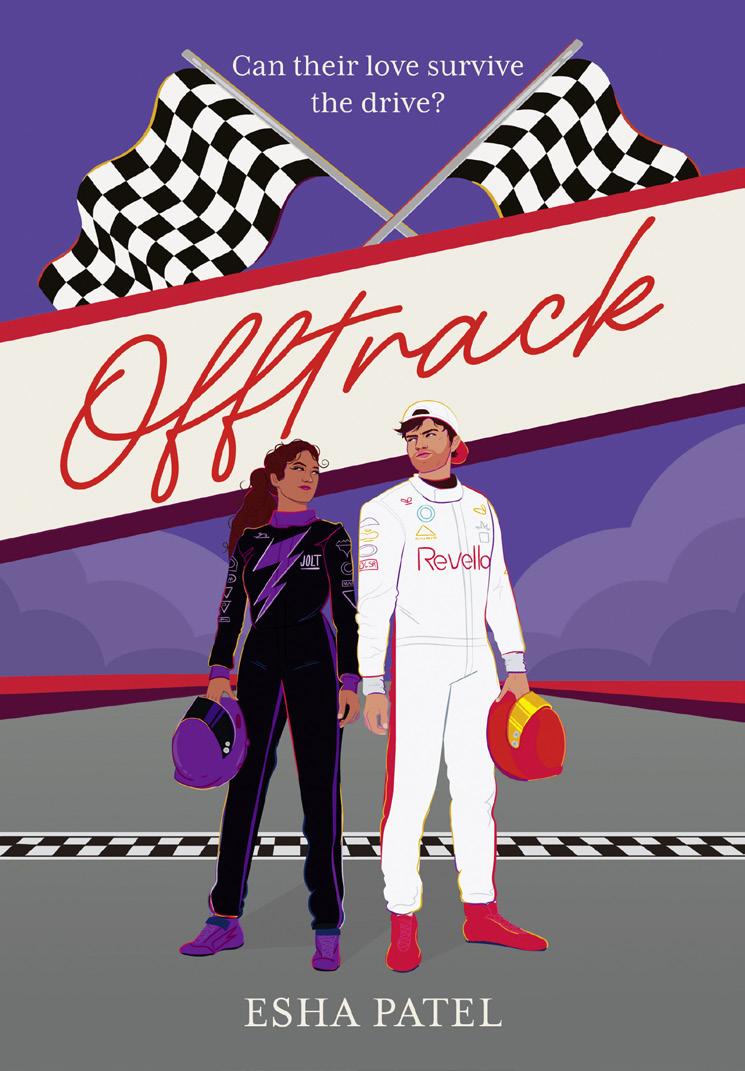
His eyes darkened as his hand gripped me tightly, inching closer to my daddy-issues painted lips. Reading the trauma right from the whips and chains he keeps in his fratboy, dartboard-door, nicotine-stained walls apartment. “I can fix him, no really, I can,” I tell myself decadently as he promised to hurt me mercilessly. God, I must love him.”
If you’re wondering what dark romance is, that was just about the best summary one could write of every book of this unusual genre. You may have stumbled upon the term ‘dark romance’ on social media these days, or in your local bookshop. All these novels need is a dark-haired boy with tattoos and piercings, living with his daddy’s money or descending from mafia blood, and suddenly, the damsel main character falls to their feet like a storm. If you couldn’t tell by now, a modern definition of ‘dark romance’ is a subgenre of romance novels often riddled with morally grey characters, trauma, and violence, with popular tropes including (but not limited to): mafia, stalking, and kidnapping. Now, it does not take a rocket scientist to read those and see the minor, or very major, flaws in these tropes. After all, crime isn’t usually something to be fawned over and romanticised. And yet, one search on major
platforms such as Tiktok’s #BookTok and suddenly, you’re transported in a world where kidnapping is seen as romantic possessiveness, murder is just another word for “I love you”, and assault is “hot”. So why is this genre of books serialised and so popular? The answer is the same if asked in the context of any other genre – escapism, expressionism, and projections.
“
It
is just a sad reminder that we crave romance but live in a world where it is frowned upon.
But dark romance wasn’t always so twisted and disturbing. Historically, dark romance comes from a collective fascination with melancholia, insanity, crime, the grotesque, and the irrational. From the 1800s onwards, dark romanticism was used to counter the euphoria and sublimity brought by romance – becoming a popular genre not only in books but also artwork. Authors such as Edgar Allan Poe and artists like William Blake are among the famous household names which fall under this genre. A famous book that boasts dark romanticism with the macabre is none other than Wuthering Heights by Emily Bronte; Bronte wrote in a beautifully haunting way, creating one of the classic romance novels we know today.
In the 20th century, Rebecca by Daphne du Maurier, was a beautifully written novel exploring psychological depths and a love story shrouded in mystery. And in the 21st century, Fifty Shades of Grey by E. L. James came to be. Riddled with possessive aptitudes, meek main characters and of course, highly sexual themes that manage to offend those who practise it.

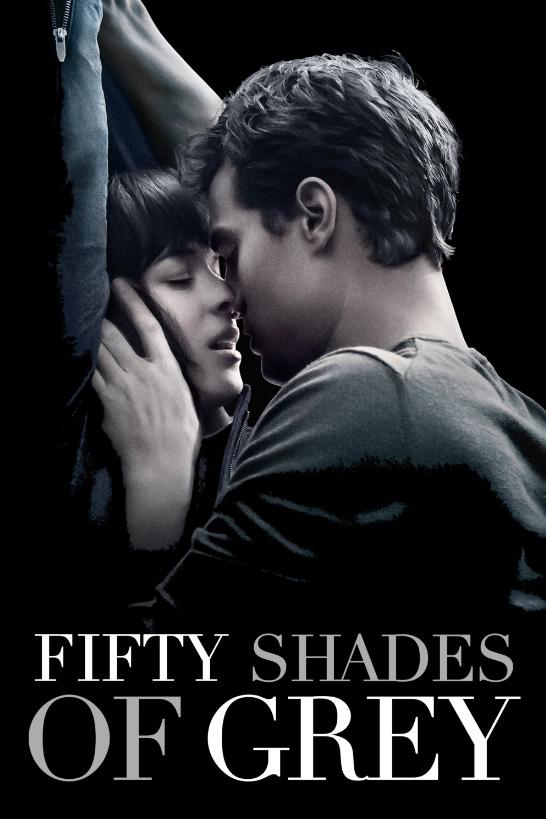
What once was a genre filled with fatalistic philosophy, written poetic charms and cultural underpinnings of the time, turned into pop-culture fantasy disguised with romance and directed with traumatic meet-cutes. So, how did we get here? Well, this generation has been criticised for its many radical views of life, most recently how they manage romantic expectations and relationships. And although most criticisms come from a place of hatred, this one might be on the money. As young girls record themselves on TikTok, typing texts of “I want…” followed by murderous scenes, or restricted hands and feet, the ball drops on the true problem. It isn’t the grotesque that they want – it’s the subtext of it. In these books, for each tight grip is the unsaid “you’re the only one I want”; for each possessive claim it’s “at least he wants me”; and for each dark-haired boy traumatic dump is “at least he communicates with me,”. In some ways, these books still follow history and in other ways, it is just a sad reminder that we crave romance but live in a world where it is frowned upon. Where it’s seen as too feminine, too cute, too “icky”. The biggest consequence of all of this? If you keep thinking fatalistic love is what you deserve – you might actually start to believe it.
Shambhavi Shukla Staff Writer
Fetch yourself a drink with some snacks and get comfortable, because you now have front-row tickets to a date where stand-up comedy truly stood everyone up. Ever uttered a witty joke with expectations higher than Burj Khalifa, only to be met with a silent room and chirping crickets? Whether you have or not, buckle up, because we’re diving headfirst into the abyss of failed comedy shows that were so unfunny, it’s actually kinda funny.
her pointing and instructing the cameras and audience like a lost traffic cop, and reading excerpts from her new book with a “funny title”, it was tough to tell when the actual comedy began and ended. To be fair, I did laugh once when she quipped after stuttering for a while “What if this was two hours long?” That definitely forced a teary-eyed chuckle out of me. Don’t get me wrong, I’m sure that Stalter is a wonderfully kind person. But the girl, bless her kind heart, needs a joke intervention ASAP before subjecting millions to her comedic misadventures.
guilty giggle. Nevertheless, Rock messed up the moment he decided to joke about somebody’s condition without a heads-up or prior consent in front of billions. In a way, the slap was quite well-deserved (and if I may, pretty impressive).
“
Watching these punchlines fail was like witnessing a car crash in slow motion - you can’t look directly at it or even look away, and there’s a weird mix of horror and sadistic curiosity. It’s like joking about Stephen Hawking running a marathon - totally inappropriate, but it might elicit a guilty giggle.
Up first in this hall of shame: Megan Stalter’s HBO Max: Human by Orientation Pride 2021 special. The confidence with which Stalter beautifully strutted onto the stage was inversely proportional to the graceless manner in which her jokes landed. In those painful few minutes of my life, I could not help but feel huge respect for her unwavering confidence. Amidst
Talking about weird stand-ups without mentioning the crash and burn of Chris Rock’s 2022 Oscar performance is like talking about Will Smith and not keeping his wife’s name out of our mouths (see what I did there?). Before Rock landed himself in hot water with the Smith family, he was slinging jokes like a pro. He took off in the smoothest fashion, only to come crashing (or rather slapping) down at the end. Was it in bad taste for him to comment on Jada’s medical condition which she has been rather open about? Absolutely. But was it kinda funny in a dark, twisted way? Maybe. It’s like joking about Stephen Hawking running a marathontotally inappropriate, but it might elicit a
Last, but in no way the least, failed show we’re going to talk about is Jo Koy’s 81st Annual Golden Globes performance. Koy’s attempt to wrangle laughs from Hollywood’s elite was met with the enthusiasm of a snail at a speed-dating event. If bombing a comedy show in front of regular people is awkward, I cannot even imagine the red-faced, uncomfortable feeling of cringe crawling up the spine while bombing one in front of Hollywood’s biggest names. Koy went from joking about celebrities in a riotous comedy special to watching the same celebrities disappointed
with his (or as he pointed out multiple times, his writer’s) lack of effort. If Taylor Swift’s stone-faced expression wasn’t a wake-up call for him, I don’t know what possibly could be. I wonder if any of Koy’s team of writers survived to see the light of the day after the Titanic-level crash.
Watching these punchlines fail was like witnessing a car crash in slow motion - you can’t look directly at it or even look away, and there’s a weird mix of horror and sadistic curiosity. It’s a bonding experience. There’s nothing like it to bring people together, united by a sense of cringe and awkwardness. But hey, at least the artists get tons of material to work with for their next couple of gigs. When life throws you a curveball (or a whoopee cushion), laugh it off and just call it your character-building (or villain-origin) exercise. There’s nowhere to go but up when you’ve hit the rock bottom!
When life throws you a curveball (or a whoopee cushion), laugh it off and just call it your characterbuilding (or villain-origin) exercise.
Guess which theatre show each of these quotes are from... bonus points if you get the character too!
“I am filled with calculust!”

“When life gives you eggs, make an omlette.”

“I thought it was hilarious to call a cat a kind of fish.”


“I will kill your friends and family to remind you of my love.”
Editors: Isabella Poderico and Katie Waldron

Lottie Carter Staff Writer
hough jukebox musicals are not a new concept within theatre, the popularity of such continues to grow. But how is this impacting the West End, and Broadway? Are jukebox musicals merely an easy ‘Money Money Money’ maker? Many will ‘Say No To This’ opinion, and argue that jukebox musicals have invited those who ordinarily would not visit the theatre to take a seat. But does this shift signal the diminu-end-o of traditional musicals?
Jukebox musicals have been performed since 1728. They seek to utilise popularised music and apply it to musical theatre to, either, celebrate and dramatise a musician’s life or apply the music to an entirely separate plot. In recent years, theatregoers can expect music from ABBA in Mamma Mia! The Musical to Tina Turner in Tina Turner: The Musical. Regardless of one’s love for theatre, there is an undeniable difference between jukebox and original musicals. Through the history of theatre, musicals with original scores are created to enhance the plot and convey characters’ thoughts through an innovative medium. In relation to the aforementioned Tina Turner: The Musical,
using her own music makes sense to the plot. However, Moulin Rouge! The Musical, which uses various popular artists’ songs, evokes less authenticity and relatability to a traditional musical. This is not to say the latter is a flop but rather emulates a concert style performance and eradicates the individuality that stems from original scores and themes.
To categorise jukebox musicals with original musicals is arguably insulting to both genres due to their widely different takes on theatre. One cannot
deny the impact of original musicals, such as Hamilton and Cabaret that were, essentially, built from nothing and thus incomparable to already established and popularised songs that people know the words to.
Arguably, the original singer’s perspective cannot merely be passed onto a different character such as the case in & Juliet, in which Juliet sings Domino by Jessie J. It is important to highlight that the disconnection stems from the songs used rather than the musical adaptation of a Shakespearean play. Continually, the reused music can be — and is — celebrated separately without its relocation into theatre and jukebox musicals are relatively unnecessary within the sphere of theatre. In jukebox musicals, as in & Juliet, the popular music does not provide an additional message to the plot other than acting as a selling point for non-theatre goers to enjoy Shakespeare in a simplified way. One could argue that, had an original score been created for a Romeo and Juliet adaptation, this largely would have been a more credible musical. Jukebox musicals therefore beg the question, are they merely facilitating a space for people

who hate traditional musical theatre?
One could argue that jukebox musicals act as a celebratory tribute to late musical artists that deserve to be honoured within theatre. While this is largely true and would encourage younger generations to appreciate a variety of musicians throughout history, it is worth acknowledging the increase in biopics already exploring artists in nuanced details that theatre is unable to do.
Nonetheless, musical theatre is witnessing an increase in immersive experiences, such as ‘Mamma Mia! The Party’ which invites audience members to dance and interact with the story and dine at ‘Nikos Taverna’. Not only does this experience incorporate all aspects of a jukebox musical, it establishes itself as an original take upon theatre and commits to breaking the limitations of traditional musicals that do not, ordinarily, encourage audience participation.
However, due to COVID-19, many actors and theatre companies were unable to perform under lockdown restrictions and theatres are still dealing with the impact of such. Therefore jukebox musicals have been encouraging all types of music lovers to engage in theatre and support the arts industry.
Akshayaa Suresh Staff Writer
Have you ever danced with fireeaters, or laughed until you cried at a street performer’s antics? Welcome to the Brighton Fringe Festival, where the ordinary transforms into the extraordinary. In its vibrant drapery of art, music, comedy, and theatre, this celebration of creativity ignites the city with a fervour unmatched. From avantgarde performances to intimate poetry readings, there’s something for every soul seeking inspiration. So, let’s wander through the eclectic streets, immerse ourselves in the kaleidoscope of talent, and discover the magic that thrives in the heart of Brighton. Shall we embark on this adventure together?
Comedy
Darran Griffiths: Inconceivable
11 May, 8:15 pm | Tickets £10
Laughing Horse at The Walrus (Raised Room)
Darran Griffiths: Work in Progress
11 May, 3:30 pm | Tickets £5
Laughing Horse at The Temple Bar
Darren Walsh: New Jokes
18 May, 8:15 pm | Tickets £5
Laughing Horse at Caroline of Brunswick
A Complete Idiot’s Guide to New Zealand
18-26 May, 3:15 pm | Tickets £7.50
Laughing Horse at Caroline of Brunswick
Daniel Powell: Breathless (Work in Progress)
25-26 May, 8:00 pm | Tickets £5 Bar Broadway
Crudi Dench: Someone Help Her! (Work in Progress)
26 May, 6:45 pm | Tickets £5
Bleach (upstairs at the Hare and Hounds)
Cabaret & Variety
Violet’s Vaudeville Vault 15-17 May, 6:45 pm | Tickets £15
Laughing Horse at The Walrus (Basement Room)
Blues and Burlesque
17 May, 8 pm | Tickets £12
Ironworks Studios (Studio A)
The Lady Boys of Bangkok
17 May-2 June (6 pm, 6:30 pm, 9 pm)
Tickets £25.50
Danny Lee Grew: 24k Magic 24-26 May, 3:15 pm | Tickets £10
The Rotunda Theatre Brighton: Squeak
Who’s Been a Naughty Chops?
30-31 May, 6:30 pm | Tickets: £9 The Actors Theatre
Dance/Circus
Circus Abyssinia: Ethiopian Dreams 15-20 May, 6:30 pm | Tickets: £18
The Vault at Fool’s Paradise
Crème de la Crème 17 May - 1 June, 11:00 pm | Tickets: £15
The Vault at Fool’s Paradise
Dirty Tattooed Circus Bastards 17-19 May, 8:30 pm | Tickets: £12
The Bunker at Fool’s Paradise
Disrupted Rhythms 24-25 May, 8:00 pm | Tickets: £14 St Mary’s Church
Emotion in Motion 1 June (3:30 pm), 2 June (2:00 pm)
Tickets: £15
Brighton Unitarian Church
Theatre
Mr Pineapplehead 19 May, 12:00 pm | Tickets £8 Various venues
Magic Word
25 May, 10:00 am | Tickets £10 The Bunker at Fool’s Paradise
Maria Morevna & The Moth 26 May, 11:00 am | Tickets £8 Brighton Toy and Model Museum
Music & Nightlife
Geoff Robb: The Music of Trees 16-17 May, 8:00 pm | Tickets: £12 The Actors Theatre
Words2Music 19 May, 3:30 pm | Tickets: £7 The Brunswick
Other
Booze & Balance (Comedy Circus) 24-29 May, 10:00 pm | Tickets: £10
The Bunker at Fool’s Paradise
Crossland & Wilkinson: Tea and Coffee on Arrival 25-26 May, 4:15 pm, 6:15 pm Tickets: donations, non-ticketed Bleach (upstairs at the Hare and Hounds)
Sian Scott Science and Tech Editor
For the final print edition, and as the academic year draws to a close, it feels fitting to conclude with a celebration, and given that I am an environmentalist at heart, of wildlife.
This month, I was fortunate to be gifted a press pass for the 2023 Wildlife Photographer of the Year exhibition, staged at London’s Natural History Museum.
Established in 1965, the Wildlife Photographer of the Year is a globally renowned photography competition that welcomes over 49,000 entries from over 90 countries. International experts select the winning images based on their creativity, originality, and technical excellence.

11-14

Stepping into the Hintze entrance hall, I was humbled by the 25.2 metre-long blue whale skeleton, aptly named Hope.
Prepared with my reporter’s notepad and pen, I was primed to report the facts and return to Brighton, yet I left with empty pages; instead, overcome with a cloud of nostalgia, but most overwhelmingly- a flood of emotion.
Nine years ago, as a sixteen-year-old art student, I ventured to South Kensington to see the 2015 Wildlife Photographer of the Year. At the time, I was sold on pursuing a career within the glossy pages of fashion magazines- naive to the fact that the overpriced London travelcard would take me much further than a stop on the solar-temperature tin can (commonly known as the District Line), and into a pair of muddy wellies and a lifetime of styling Gore-Tex anoraks. The trip inspired me to explore an academic route in Ecology and Conservation and, later, a prospective career in environmental journalism.
Whilst the entirety of the exhibition cannot be confined to 600 words, I wanted to select a few pieces that I loved, and that resonated with my feelings surrounding the current state of the natural world to ornament this article.
As I explored the exhibition, I could not help but notice a striking dichotomy between the Young Photographer of the
Year (for under 18s) and adult categories. While both segments showcased remarkable talent and skill, they elicited distinct emotional responses.
In the under 18’s categories, I was struck by the palpable sense of hope and admiration emanating from the mounted prints. The young photographers captured the sheer beauty of nature, each image a testament to their creativity and profound appreciation for the natural world. It felt like they had an innate connection to nature; and captured it through a lens of wonder and acclaim.
On the other hand, the adult categories, ranging from photojournalism to portraiture, often presented a more sobering reality. Images depicting environmental degradation, habitat loss, and the looming shadow of climate change laid bare the harsh truths. Each photograph served as a poignant reminder of the pressing need for action and change.
There is no escaping the climate crisis; whether that is taken in a (quite depressing) literal sense or by considering the mass media coverage of global warming. However, it is easy to turn over the newsprint pages or swipe to the following online article, leaving the images of our changing world confined to Times New Roman letters. The Wildlife Photographer of the Year exhibition changes that- by

confronting the climate change face, or lens, on.
However, inspired by the perspective showcased in the under 18s categories; I was reminded of the importance of still viewing nature through a lens of hope. Moments captured by young photographers serve as potent reminders to appreciate and preserve the beauty of our natural world for generations to come.
The Wildlife Photographer of the Year exhibition at South Kensington closes on 30 June.
While both Seasonal Affective Disorder (SAD) and its companion, the light box, may seem like new phenomena, this black-cat-and-goldenretriever duo have been around since the 19th century. Although the term SAD was first coined in the 1980s by Norman E. Rosenthal M.D., phototherapy was introduced almost 100 years earlier. The 1903 Nobel Prize in Medicine and Physiology winner, Niels Ryberg Finsen, advocated the therapeutic effects of artificial light sources. Despite light therapy’s ability to treat a range of conditions, including the aforementioned SAD, disorders affecting circadian rhythm, acne, and psoriasis, with it came the invention of the sunbed – a creation which, instead of ameliorating the symptoms of various diagnoses, can cause one big one. Overall, the SAD lamp’s impression of the sun’s more favourable qualities is admirable, even if some consider it a placebo. But if you want to get tanned in England, please just peruse the shelves of Boots.

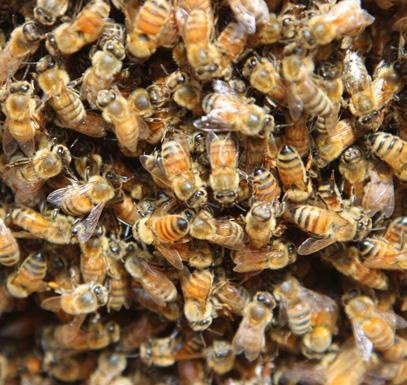
When talking about tech inspired by nature, Swarm AI is a standout example in applying natural processes to Artificial Intelligence. The expression was first coined by Gerardo Beni and Jing Wang in 1989, during the development of cellular robotics systems. Inspired by observations of the collective behaviour of animals in nature such as birds and fish, Swarm AI is a subsection of computational intelligence that centres on the interactions between multiple intelligent agents in a group (or swarm, hence the name) - instead of the more traditional approach focusing on an isolated agent. Typically, this tech is used as a computational modelling technique. Examples of popular simulations using this tech include using the patterns of bird swarms as a basis for business and economic complex systems.
Neuromorphic computing takes inspiration from a range of basic neurobiological processes. It focuses on developing systems capable of simulating the basic structure and functions of neuronal and synaptic connections present in the brain. What differentiates them from conventional computing systems is their collocated and parallel processing memory storage and event-driven activity, which can be attributed to the nature of neuronal systems. This further makes these systems an ideal platform for developing AI and machine-learning algorithms. While not yet commercially available, some neuromorphic computing systems, like SpiNNaker by the Human Brain Project and Loihi by Intel, are accessible for research. Their energy-efficient and stochastic nature makes them ideal for potential use in areas of autonomous systems, IoT, and AI accelerators for personal devices and they serve as coprocessors for high-performance computing.
Nature has played just as big of a part in the development of flight as science has; with the structural design inspired by creatures that have existed for centuries, combined with recent technology such as 3D printing. From the 16th century, Leonardo da Vinci observed the wings of bats and birds and continued to design the flight system. Da Vinci believed that if humans could flap (and grow) their wings, they could overcome gravity and fly into the sky.


The V-shaped formation within migrating birds like geese and ducks has in spired fuel-efficient flight patterns for long-haul flights. Recently, NASA developed a revolutionary wing inspired by the wing movements of birds, with a flapping motion. The design could go through a range of positions and angles throughout the flight, reflecting the bird’s wing, demonstrating the use of nature observation within aviation development.
Jenny Choi Science and Tech Sub Editor
n an era plagued by concerns over food waste and environmental sustainability, 3D-printed food emerges as a beacon of hope for conscientious diners. While the concept of 3D-printed food has been around for a while, the research trend has shifted from basic feasibility studies to more advanced applications spanning nutrition, sustainability, and healthcare. Beyond revolutionising culinary creativity, 3D-printed food serves as a sustainable solution to global food production challenges, including the critical issue of overfishing.
Overfishing is a severe global problem that depletes fish stocks, damages marine environments, and disrupts ecosystems. The United Nations stated that about 34% of global fish stocks are overfished, posing a significant threat to marine biodiversity and the livelihoods dependent on fishing industries. This is where 3D-printed food steps in as a part of the solution, particularly with the development of 3D-printed seafood.
Companies like Revo Foods are pioneering this field by creating plantbased fish alternatives using 3D printing technology. These products mimic the texture and flavour of real fish without the environmental cost of fishing. For example, Revo Foods uses a blend of pea proteins, algae extracts, and plant oils to replicate
salmon’s nutritional profile and taste, aiming to reduce reliance on traditional fishing methods and promote a more sustainable way of consuming seafood.
“
The potential for creating a sustainable, customisable, and efficient food system is within our reach.
Stakeholder Foods has launched the world’s first plant-based 3D printed eel, aiming to offer a sustainable alternative to traditional eel, which faces threats from overfishing and habitat issues. This innovation is a part of their broader initiative to revolutionise the seafood industry with technology. Utilising their unique DropJet 3D bioprinting process, Stakeholder Foods has managed to replicate the complex texture of eel, aligning with increasing consumer demands for ethical and cleanlabel products. This could lead to broader applications in producing various textured foods on a potentially industrial scale. Beyond addressing overfishing, 3D-printed food contributes to sustainability in several key areas, such as reduction in food waste and local production advantages.
3D food printers can use ingredients that would otherwise go to waste, such as ugly fruits and vegetables or by-products from food processing. This ability not only helps in reducing food waste, which
is a significant issue globally but also maximises the efficiency of food resources. By transforming less desirable produce into appealing and nutritious meals, 3D printing technology ensures that fewer resources are discarded unnecessarily.
3D food printing can also potentially decentralise food production, making it possible to produce food on-demand anywhere, including in disaster-stricken or remote areas. This capability reduces the need for long supply chains that are costly and carbon-intensive. For instance, if food printers become widespread, communities can produce what they need locally, relying less on global supply chains that contribute to significant greenhouse gas emissions.
While the benefits are promising, the road to the widespread adoption of 3D-printed food in sustainability efforts is fraught with challenges. Public acceptance, regulatory hurdles, and the need for infrastructural changes in the food production industry are significant barriers. However, with increasing technological advances and growing awareness of environmental issues, we can take a substantial step toward a more sustainable and food-secure world. The potential for creating a sustainable, customisable, and efficient food system is within our reach, promising a future where food production aligns harmoniously with environmental conservation.

Julia Uilenreef Staff Writer
With artificial intelligence rapidly advancing, we are posed with new challenges on how we can protect our identity. As examples of deepfakes are spread across the internet, concerns are raised regarding not only the manipulation of someone’s physical likeness but also of their voice. Until recently, the concept of ‘ownership’ of a human voice has been largely overlooked. However, evolving technology and the extensive collection of voice samples on the internet have brought this issue to the forefront, demanding urgent consideration.
Voice cloning, a process where algorithms are used to create convincing copies of voices, has emerged as a hot topic in discussions surrounding artificial intelligence. These clones, capable of mimicking the nuances and intonations of genuine voices, are often employed for various purposes; from lighthearted entertainment to spreading misinformation. The amount of video and audio clips containing voice clones has skyrocketed in recent years, posing significant challenges for individuals who
find themselves targeted. In 2019, a video of House of Representatives Speaker Nancy Pelosi surfaced where her voice had been deliberately manipulated to give the appearance that she was intoxicated. Similarly, last year, a documentary was released using a voice-over by Stephen Fry, despite him having never recorded it. The voice clone had been created using recordings of his Harry Potter audiobook narrations.
What could someone do with your voice if there were enough recordings of it?
consideration, ‘owning’ your voice in the UK presents more significant challenges due to limitations of the current legal frameworks.
One potential avenue in protecting your voice is through copyright protection. You may have copyright if your voice has been captured in a recording. However, it’s crucial to understand that the copyright would belong to the person who made the recording, not the speaker. Rather than the actual voice having copyright, it is the particular recording that does. Copyright protection may offer little recourse if someone else has recorded your voice.
a criminal offence. A voice recording employed for illegal purposes will naturally be unlawful. Outside of this, the harsh reality is that you do not own your voice, and you don’t have legal pathways open to protect it.
“ As artificial intelligence continues to challenge our legal systems, it is imperative that we continue to protect the integrity and autonomy of individuals in the face of technological innovation.
Although audio deepfakes are often used for humorous purposes, voice cloning technology has obvious potential dangers. What could someone do with your voice if there were enough recordings of it? The reality is that, despite our connection with our voices, we have no legal rights over it. While the United States offers greater potential for protection, for example, through publicity rights, giving individuals the right to control commercial use of their identifying aspects, as well as a potential ‘No
In a commercial context, individuals (especially celebrities) may find some protection under the “Passing Off” Law. This law prevents others from misrepresenting goods or services associated with someone else. Thus, individuals whose voices are closely tied to their professional identity or brand may be able to take legal action against those who misuse their voices.
Act’ that is currently under
Of course, this does not mean that anyone is free to use your voice for just about anything if you are not a celebrity. Recordings of your voice to access private information, such as your bank account details, are fraudulent and constitute
Technology is evolving, and the law must evolve with it. As it stands, the law isn’t equipped to fully address the complexities of voice ownership and protection. There is a need to develop regulatory frameworks that adequately tackle the harms that come with voice cloning and deepfake technology. As artificial intelligence continues to challenge our legal systems, it is imperative that we continue to protect the integrity and autonomy of individuals in the face of technological innovation.

Ruby Wheeler Staff Writer
n Wednesday 24 April, Sussex Women’s Hockey went up against Brighton Women’s Hockey in a fiercely contested match that ended in a draw, with both sides finishing with a score of 2-2. Audiences from both Sussex University and Brighton University assembled at Falmer Sports Complex at 1 pm, for the face-off at 1:30 pm. Anticipation ran high as supporters from both universities stood side by side, ready for the match to begin. The game was marked by intense action from the getgo. Both teams demonstrated high levels of skill and determination. Goals were scored by Megan Wroe and Analena Goldblum from Sussex women’s hockey. There were exceptional amazing halftime performances from Sussex Swallows, Sussex University’s game day cheerleading team as well as Waves cheerleading team, Brighton and Sussex’s joint cheerleading team. The second period saw relentless back-and-forth action as both teams fought to gain the upper hand. Despite numerous scoring opportunities, Sussex kept a solid defence. Although both teams pushed for a game-winning goal, the match ended in a hard-fought draw.
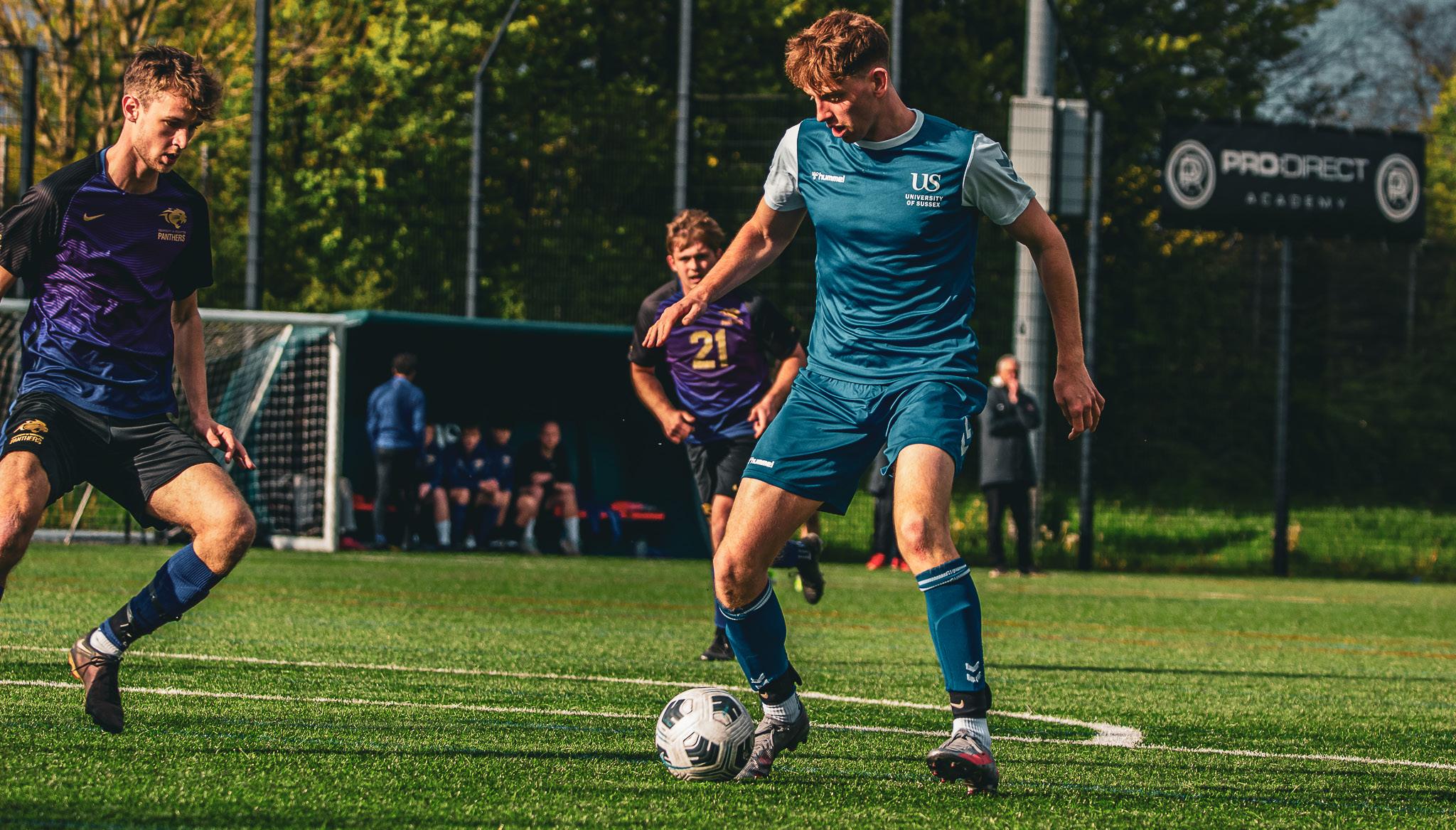
Men’s football is always an exciting match for the Sussex v Brighton Varsity, and 2024 did not disappoint. There was an atmosphere which wasn’t far from a Champions League Final as students of Sussex and Brighton alike, gathered at the Astro on campus to watch and yell chants. The first (of many) goals went to Brighton, but the Stingrays refused to give up, and eventually flipped things to their favour, with the score standing at 3-1 by halftime after a converted penalty. At halftime, the Sussex Swallows Cheer team shined bright with a performance full of stunting and dancing – a brilliant way to maintain suspense for the second half. Cheer team Waves was also in attendance, bringing their best stunts to the large crowd. The final score was 3-2 to Sussex, a brilliant win for the team who seemed very happy in their celebrations. This comes as a complete reversal of 2023’s result where Sussex lost 3-1 to Brighton.
James Caddick Staff Writer
he 2024 season is looking very promising for USCC with the club aiming to achieve a BUCS promotion for the 1st and 2nd XI. We have had one of our biggest intakes of freshers this year, meaning competition and training attendance throughout the club is the highest it’s been for numerous years. With the help of our coaches John and Phil, all the teams have wintered very well over the last six months and are buzzing to show off their skills this season. The lows of last year’s 1st XI BUCS campaign have all been forgotten. Within the camp there is a huge positivity that we can dominate in every aspect of the game and impose ourselves on the opposition. Oscar Bussey-Jones is at the helm this season for the 2nd XI and believes after last year’s promising BUCS campaign, the team go one further and achieve the promotion they so desperately want. The positivity and desire to compete runs across USCC. The 3rd XI, as skippered by Joe Grimes, have had huge interest from players which has led to many more fixtures arranged that previous seasons which outlines the magnificent culture within the club.
Kian Shayegan Sport Sub Editor
nfortunately the final result wasn’t what Sussex were looking for, but the game as a whole was a great advertisement to show how entertaining basketball can be, with constant end-to-end action and countless nail-biting moments. The most nail-biting moment was undoubtedly in the final action of the game, where Brighton had three free throws where if they score all three they win, and the game ends in a draw and goes to extra time if they score two. After scoring the first and missing the second, it all came down to the final throw to decide whether Sussex would be victorious or another gruelling five minutes of basketball were to be played. The crowd was about 80% Sussex despite the game being held on Brighton’s Falmer campus, and the amount of jeering and heckling towards the Brighton player shooting made me think it’s inevitably going to get into his head and make him miss. The fact that this exact player also hastily lashed out and tried to push one of Sussex’s players only a few minutes prior made me even more adamant that this would happen. However, despite all of this, he swished the ball into the net with minimal fuss, and the game ending 67-67 was to go to extra time, where Brighton would eventually emerge victorious.
Semhar (Semi) Tesfazgy Editor in Chief
ur Sussex Women’s Basketball Team (SWBB) does us proud, winning 58-38 in a tense match against Brighton’s Panthers. Taking place away across the road at the University of Brighton, the team went neck in neck to claim the win. Competing on the last official day of varsity meant the pressure was on to maintain the three-year win streak Sussex has held overall against Brighton at Varsity. Defence particularly shone from the Sussex team with the Panthers scoring only once in the last quarter, and things got dicey as the game went on with multiple cases of physical contact from the Panthers. This game was particularly meaningful due to being the last one of the season and most of the team members graduating - and it marked a sentimental goodbye to both the sport and Sussex as a whole. A massive congratulations to the team and their win, in particular their incredible coach Nick Stevens, resilient Captain Ciara Parker, and skilled Vice Captain Alicia Galiana Wallace. All of us at The Badger are big fans of the team, and are excited to see what great feats next year’s team accomplishes!

Jemimah Kayode Film and TV Editor
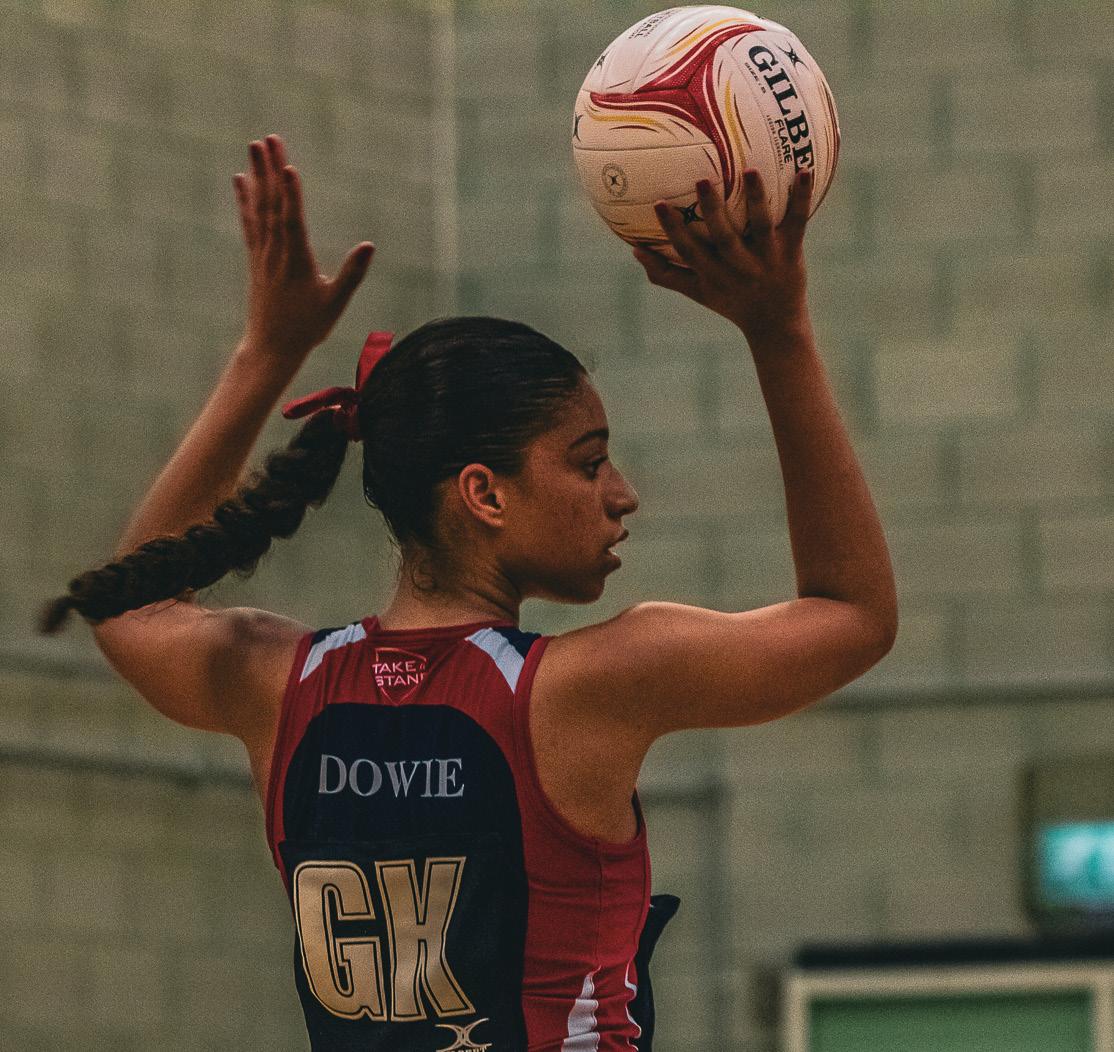
took the opportunity to watch the netball varsity match on 1 May, and if I could describe it in one word it would be “riveting”. After losing by one point in the first quarter Sussex picked it back up again to gain a lead in the second quarter, a lead which they held onto and widened, resulting in a stunning 29-24 victory, and another point for Sussex added to the Sussex vs Brighton score, which at the time of writing stands at 11.5-3.5 to Sussex. Being amongst the crowd was thrilling. Sussex fans were the ultimate cheerleaders and champions of sportsmanship, as they endured insults from the Brighton supporters, Sussex remained focused on uplifting the squad members of their netball team. Chants of “stingray till I die” and “come on Sussex” could be heard throughout the hall amongst others. There was also a netball development varsity tournament. Two Sussex netball development teams faced off against Brighton Eastbourne and Brighton’s development teams. This, unfortunately, however resulted in a Brighton win with an overall score of 8-16.
Will Symons Sport Editor
ayden Seales is eying up a return to test cricket this summer, after a barnstorming start to life in Sussex. After he was forced to withdraw from a stint by the seaside last season, fastbowler Seales returned to Hove last month, signing for the opening rounds of this season’s County Championship, and T20 Blast competitions.
Making an immediate impact, the hulking Trinidadian stole the headlines with six wickets in a fiery first bow against Northamptonshire.
Speaking before his debut, Seales seemed eager to make up for lost time. “I’m strong again, fit again and ready to go,” he told me. “It’s a bit cold, but as I expected, coming to England. I’m enjoying it, I’m enjoying being able to train out in the middle and get accustomed to the pitch here in Hove”.
Now 22, Seales burst onto the scene as
a teenager, becoming the youngest West Indian to take five wickets in an innings, in just his third appearance against Pakistan in 2021.
“
I try to focus on my game, and improving myself, to be able to perform for the team when called upon.
Dismantling a shell-shocked Pakistan batting card, Seales took 5-55 with the world watching, guiding his side to a thrilling one-wicket win in Kingston.
Three years on, the six-foot seamer has 37 wickets in ten test appearances - listing the likes of Ben Stokes, David Warner and Shakib Al-Hasan amongst his redball victims. And, despite his stellar start, Seales remains unfazed by his growing reputation.
“In cricket, there’s always pressure. In any sport, as a matter of fact, there’s always
pressure. Yes, maybe there’s been a bit of added pressure, knowing that I have that little bit more expectation on me, seeing how I’ve done, but I don’t really try to study it anymore. I try to focus on my game, and improving myself, to be able to perform for the team when called upon”.
After a breakthrough couple of years, Seales’ first major setback came in December of 2022, sustaining a knee injury in his first test on Australian soil. Proving troublesome, the injury kept Seales sidelined for the best part of a year, at the time he was due to feature for Sussex.
“It was really frustrating,” Jayden explained. “To have the start that I had, and then get injured at a crucial time, especially in that tour of Australia, it hurt a lot. I was disappointed and frustrated. Then, getting fit again only to be plagued by another injury had me down a bit.”
Yet, after a lengthy rehabilitation period, Seales is back and firing in the whites, helping Sussex to their first win of the season with twin four-fer’s against
Gloucestershire.
Alongside Championship glory, Seales has another goal in mind - a return to the world stage on the West Indies tour of England this summer.
“
Seales has another goal in mind - a return to the world stage on the West Indies tour of England this summer.
“The test side. It’s obviously at the forefront of my mind, being able to get back in the test team is the number one focus for me right now. It’s just a matter of keeping myself fit and available for the team at all possible times.”
Should he continue his excellent run of form, Seales can expect a place in the West Indies side taking on England in a threematch test series, beginning on 10 July at Lords.
Zeeshan Tirmizi Opinion Sub Editor
Victor “Striker” Hugo won his entry into UFC last year in Dana White’s Contender Series. UFC is the biggest championship platform for mixed martial arts (MMA) fighters. We spoke with Victor to learn more about his journey in his professional MMA career.
What was your motivation for deciding on a career in MMA?
I have been a fighter since I was five years old. My father was a fighter and started my career by teaching me kickboxing and putting me in a BJJ (Brazilian jiu-jitsu school). My father is my motivation because I believe all kids want to impress their father, so that is a reason.
What were the challenges you faced in your professional MMA career?
The biggest challenge was balancing training and work because I worked from 10 PM until 5 AM six times a week, slept very little and trained twice a day, and this routine continued for ten long years until I was signed as the most significant event in the world, man. It was challenging, but I managed.
How was your journey to get into the UFC?
My journey to the UFC was extremely difficult; as I said before, I started my career by training in kickboxing with my father and doing BJJ, too. I was taught from the age of five until I was 20 in my hometown, and
then I moved to the south of Brazil, where I had to train and work. In the south of Brazil, I met a great MMA team. I knew what it was like to train hard and have to dedicate myself. I must confess that I ultimately sacrificed my life to get to where I am today, including my time with my family, who lived two thousand kilometres away. I was able to visit them very rarely. I was distant from my friends, but I understand that this was all part of becoming who I am today as an athlete, man, and citizen...
Give your best, no excuses. There is no place for weak people in that world.
What do you expect to achieve in the UFC?
In the UFC, my ultimate goal is nothing short of becoming a champion. I envision myself dominating my division and rising with relentless determination and skill. Have you faced any unexpected obstacles in your life that affected you personally?
My brother passed away in 2022. That guy was like a brother to me; we had known each other since we were 3. He loved Charles “Do Bronxs” Oliveira (another UFC fighter). When he passed away, I was mentally broken. I was f*** crazy. I rode my bike at 180 miles per hour on the road. I lost my mind for sure... but with time, I was coming back to normal, but still sad. So, I fought and
started training. Then, I promised myself that I would finish my fight because my brother loved Charles Do Bronx. So I did it in 23 seconds of the first round. That was a tribute to him.
What advice would you like to give someone interested in making a career in MMA?
Give your best, no excuses. There is no place for weak people in that world.
Victor was rejected from the UFC years ago before getting accepted last year. Despite facing challenges in all aspects of life, Victor kept training with
his goal in mind and constant dedication. Victor shocked everyone with a kneebar submission for his entry into the UFC last year and a victory with a unanimous decision on his debut fight this April. UFC is a dream place for fighters worldwide, from Chechnya to Sao Paulo. Many come from extremely underprivileged backgrounds before making it big in this sport, which has its home in Vegas. Victor’s journey reminds us of the dedication and hard work it takes behind this blood sport enjoyed by millions all around the world.


5. Precious metal symbolising a 70-year anniversary (8)
6. Which UK nation has the national animal of a unicorn? (8)
7. Village with tearooms and gardens close to campus (7)
8. Sports event famous for strawberries and cream (9)
10. Award-winning student newspaper with six copies this year (3, 6)
11. Fast-food franchise first opened in the UK 50 years ago (9)
1. Star Wars Episode I title, released 25 years ago (3, 7, 6)
2. The name for the longest and shortest day of the year (8)
3. The name for a hundred-year anniversary (9)
4. How many years since Sussex University was established (5, 3)
9. Grid-based word puzzle first used in New York World (8)
All puzzles created by Andrew Malarkey, Puzzles Editor


Create as many words as possible with the letters in the word wheel. There is one using all the letters. You can only use each letter once and every word must contain the letter in the centre of the wheel. Letters must be followed by a letter in the section next to it.
Answers! (Don’t look yet...)

Lindsey Rippert Staff Writer
Aries (21 March to 19 April):
Aries placements may feel frustrated emerging from the slow-moving Taurus season, but the sun entering Gemini on May 20 will bring a sense of immediacy and directness that Aries placements have missed. When Venus enters Gemini on May 23, you will likely seek out new experiences and allow your curiosity to lead you.
Leo (23 July to 22 August):
The full moon on May 23 will bring good luck, good will, and inspiration. However, you may feel an inner conflict between logic and intuition or faith, and the full moon in Sagittarius invites us to find a balance between these.
Sagittarius (22 November to 21 December):
The full moon in your sign on May 23 will inspire your need to seek out new meaning and expand beyond the bounds of your comfortable environment. Be careful of living too much in your head and ignoring your emotions.
Taurus (20 April to 20 May):
May 8’s new moon in Taurus will illuminate a sense of stability and allow you to set the foundations for that which will come to fruition with the full moon in Sagittarius two weeks later. Avoid being overly stubborn or refusing to see other’s point of view.
Virgo (23 August to 22 September): Don’t take on too many projects or scatter your energy in too many directions this Gemini season. Your tendency may be to stay perpetually busy without getting much done. Remember to take time to curate the environment which makes you the happiest.
Capricorn (22 December to 19 January):
Capricorn placements will feel productive and grounded as Mercury enters Taurus on May 15. This is an excellent time to develop your routines and work hard to gain a sense of material security.
Gemini (21 May to 20 June):
The sun enters your sign on May 20 this year, encouraging your already inquisitive and friendly nature. This is an excellent time to try new things and expand your horizons. When Mercury and Venus enter Gemini, you will be especially communicative and charming to others.
Libra (23 September to 22 October):
On May 26, Jupiter enters the sign of Gemini, a fellow air sign. Libras will feel mentally adventurous and ready and willing to learn, leaning into the inquisitive nature of the air signs. They will be openminded, but be wary of being easily swayed from your beliefs.
Aquarius (20 January to 18 February):
The new moon in Taurus on May 8 will bring to the forefront your need for change, innovation, and expansion. The moon harmonising with Saturn reminds you to have patience and respect for the process and your past.
Cancer (21 June to 22 July):
Nine-letter

When Venus enters Cancer on June 17, Cancer placements will experience heightened emotions in their close friendships and relationships. Avoid overly clingy tendencies and be careful of your urges to self-isolate and sulk.
Scorpio (23 October to 21 November):
Scorpios will find themselves attracted to mentally interesting people who stimulate us intellectually throughout Gemini season. The May 23 full moon harmonises with your ruling planet Pluto and encourages introspection and a search for meaning.
Pisces (19 February to 20 March):
As Jupiter enters Gemini on May 26, your inner world will be rewarded when you connect with and repair relationships, learn new things, and explore new interests. Avoid skimming the surface of issues; dive deep into your connections.